|
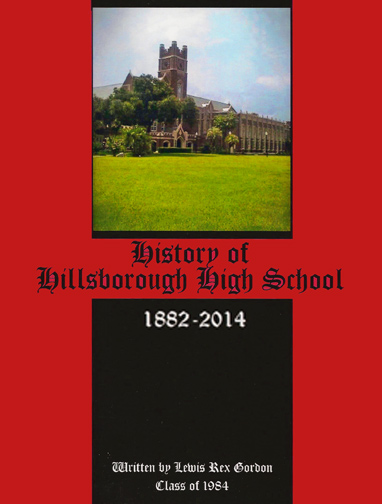 |
|
|
Rex's new
book on the history of Hillsborough High School was released
Sept. 2014. A must for all Terrier alumni! |
|
|
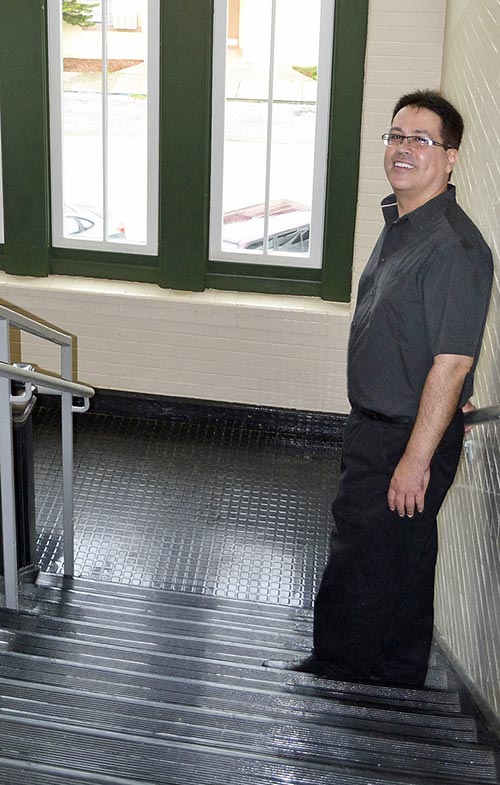 |
|
L.
Rex Gordon |
HISTORY REWRITTEN
Special thanks to HHS historian
Lewis Rex Gordon, author of
"History of Hillsborough High School," for his
permission to use his findings, and his assistance and
advice on the information presented in this feature.
In the
Sunland Tribune, Volume XII November, 1986 the article "Hillsborough
High School: The First One Hundred Years," begins with:
"In the beginning, Hillsborough High School was a department
of the Tampa Graded School System which was organized in 1885. It
began in a livery stable on Franklin Street with nineteen students
and one teacher, Mr. B.C. Graham, who also served as the
principal. The first four students graduated in 1886."
For many years,
this account was practically etched in stone. The
manuscript was written by the faculty and alumni of Hillsborough
High School in 1985 for the school centennial. But in
2003, evidence was discovered that would rewrite some of this
commonly accepted history of Hillsborough County's oldest high
school. Ironically, the new evidence was, in a way, found in
stone--a cornerstone.
The
revelation came in the form of a document written in 1911 by a
Hillsborough High School student named Doris Geraldine Hill.
Written on lined paper, it was rolled into a scroll, tied with a
red and black ribbon and placed into the cornerstone of the
then newly-built school at 2708 Highland Avenue. There it
sat until 92 years later, when the building was being restored,
the cornerstone was removed and opened.
Inside the
cornerstone time capsule was a copper box with a list of the contents, on Board of Public Instruction letterhead.
|
-
History of
High School by Doris Hill
-
Copy of
minutes of school board
-
Copy of Hymns
rendered at Occasion
-
Course of
study
-
Autograph list
of pupils attending High School
-
Names of
Faculty
-
Copy of Tampa
Tribune
-
Copy of Tampa
Times
-
Invitation to
Hillsboro Lodge 25
-
Copy of School
Law
-
Invitation to
Capt. George N. Lynch to deliver address at the laying of
cornerstone of Hillsboro High School
-
Copy of
Proceedings of Grand Lodge of Florida F. & A.M., 1910
-
Coins
-
List of
officers Grand Lodge
Photo by Dan Perez, property of TampaPix.com
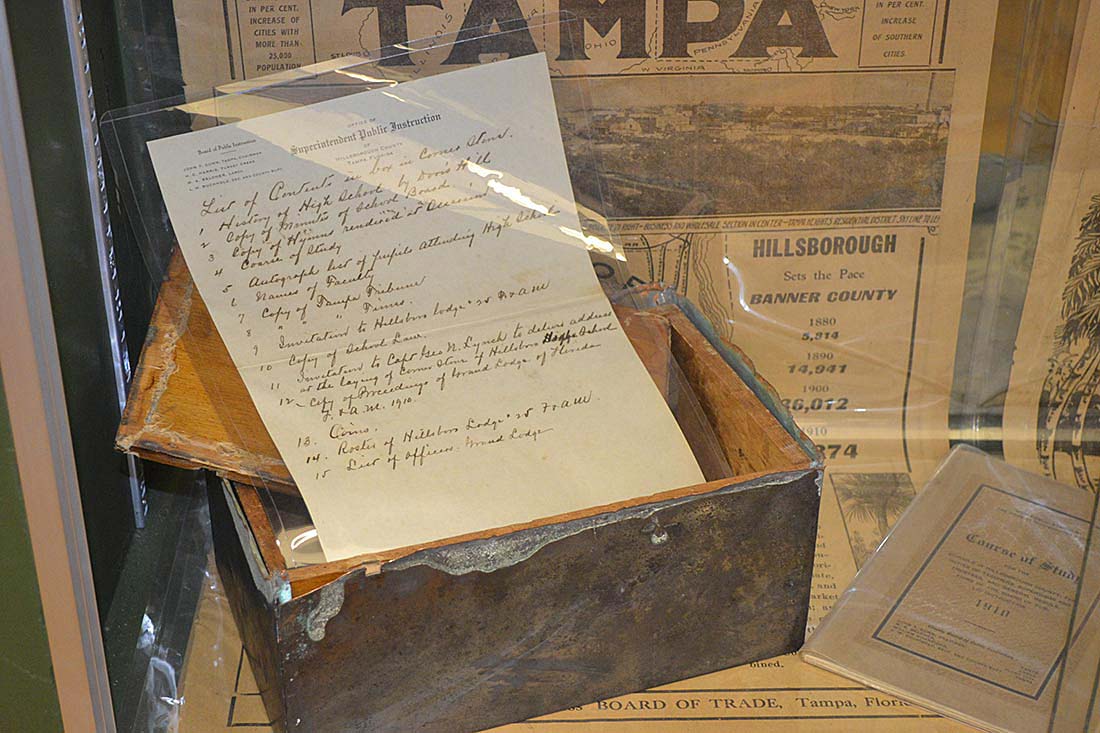 |
|
Read about the
items that were placed in the cornerstone time capsule before it was
put back in its place.
|
|
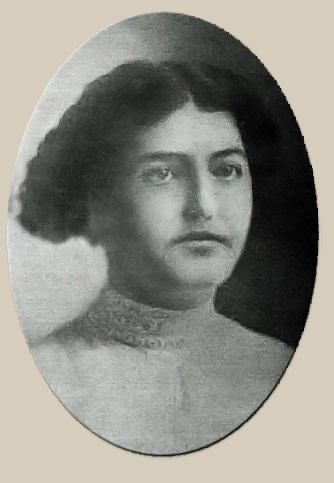
Doris Geraldine Hill graduated
with high honors in 1912. She was called the most studious
girl in her class, enjoyed music, having fun, and giving to others. |
Doris' history was
written at a time when many, if not all of the founders of
Hillsborough County education system were still living and available
for interview. She must have been a proud young lady to be
selected as the author of the official school history that would be
placed into the time capsule. In 1911, there was no published
history of the high school system in the county, so her resources
would have been original reference sources. It was literally
being written during her lifetime. It may have even
been a class history assignment for which she and her classmates
were graded on.
It begins as follows:
The History of the
Hillsborough County High School
Compiled by
Doris Hill
February 15,
1911
The laying of the cornerstone
of our new high school means so much to us. It means that the
building to which we have looked forward to for so long is now in
the course of erection. In 1905, the school paper expressed the need
of another building, and the pupils of the school have been longing
for it for all these years. Now, when we are about to realize our
hopes, let us look back over the history of the High School.
For the rest of this feature,
Doris's cornerstone history will be presented accordingly
over the various locations as they apply, and combined with the First
One Hundred Years history and E. L. Robinson's History of
Hillsborough County. Text from Doris Hill's history will be in
red italics.
|
SOURCES
-
Florida Homes Magazine (M. Leo Elliott)
-
History of Hillsborough
County Public Schools, Compiled by the Department of Research
and Development: Judith Lombana Ed.D., Supervisor Richard Bair,
Ph.D. Jim Cain Author Graphics, Layout, June 2000, p. 42ff
(All
text in this feature presented in blue
italics is from this source.)
-
History of the City and the Tampa Bay Region of Florida,
by Karl H. Grismer, edited by D. B. McKay, 1950.
-
History of Hillsborough County, by E. L. Robinson, 1928
at the University of S. Florida Digital
Collections
-
History of Hillsborough High School,
by Lewis Rex Gordon, Class of
1984
-
Hillsborough High School, the First 100 Years 1885-1985, a
manuscript written by the faculty and alumni of Hillsborough
High School, 1985, published in the Sunland Tribune, Vol. 12,
Nov. 1986, Journal of the
TAMPA HISTORICAL SOCIETY at the University of S. Florida Digital Collections
-
Hillsborough High School website
-
Pizzo, Anthony, Collection of Historical Documents, Special
Collections, The University of South Florida Library, Tampa
-
The City Council of Tampa
and Celebration of Old City Hall's Centennial,
a project of the City of Tampa, 7th Edition - December 2018
-
Wynelle Davis Gilbert,
Jefferson High School Alum & former curator of the JHS Museum in
the D. W. Waters Career Ctr.
-
Scanned newspaper images from
Newspapers.com - The Florida Peninsular, The Tampa
Herald, The Sunland Tribune, The Daily and Weekly Tampa Tribune,
The Tampa Times, The Charleston Mercury.
-
Various official records such as U.S. Censuses, Marriage
licenses & indexes, death & birth records at Familysearch.org.
|
|
TAMPAPIX
RECOMMENDS YOU FIRST READ ABOUT THE HISTORY THAT LED UP TO HCHS's
FIRST HOME
THE
BEGINNINGS OF A SCHOOL SYSTEM IN HILLSBOROUGH COUNTY
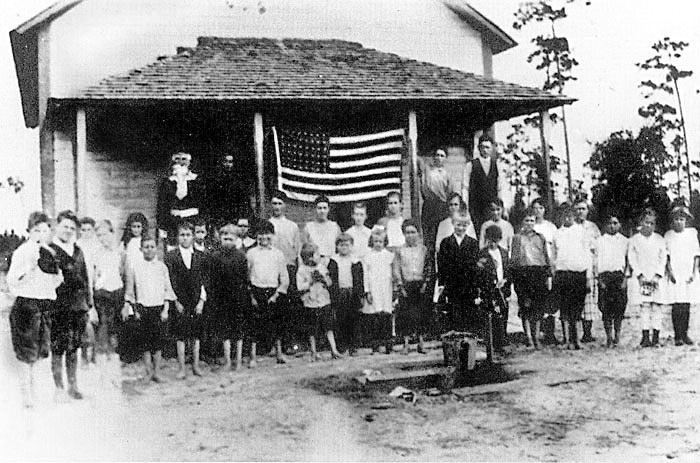
|
 HILLSBOROUGH
COUNTY HIGH SCHOOL'S FIRST HOME HILLSBOROUGH
COUNTY HIGH SCHOOL'S FIRST HOME
You are urged to first visit the previous page about the beginnings
of the Hillsborough County school system in the middle 1800s.
It is an important period which gives a better understanding of the
conditions that led up to the establishment of Hillsborough County's
first "official" high school.
Page 1 - THE BEGINNINGS OF A SCHOOL SYSTEM IN
HILLSBOROUGH COUNTY
|
MYTH
BUSTED!
Before Doris Hill's
cornerstone history was found, the generally accepted
account of the school's founding was as follows:
In the beginning, Hillsborough County High School was a
department of the Tampa Graded School System which was organized
in 1885. It began in room over a livery stable on Franklin
Street with nineteen students and one teacher, Benjamin Chalmers
Graham (B.C. Graham), who also served as the principal.
The first four Hillsborough County High School students
graduated in 1886.
This is the opening paragraph
to
Hillsborough High School, the First One Hundred Years
which was published in The Sunland Tribune, a Journal of the
Tampa Historical Society, Vol. 12, Nov. 1986, and is seen to the
right. The manuscript was written by the faculty and
alumni of Hillsborough High School in 1985 for what they thought
was the centennial.
Doris Hill's history written in
1911 reveals that the high school had its beginning three years
earlier, with a female principal, and no mention of a stable:
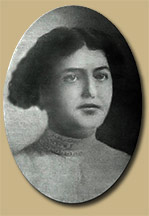 The
Hillsborough County High School was a department of the Tampa
School No. 1, which was located on Franklin Street, north of the
Court House. The
Hillsborough County High School was a department of the Tampa
School No. 1, which was located on Franklin Street, north of the
Court House.
A
High School course was introduced for the first time in 1882.
At this time, Mrs. Mary Cuscaden was principal, and Mr. Wesley
P. Henderson was County Superintendent.
Mrs. Cuscaden was principal for two years. In 1884, she was
succeeded by Dr. Raymond, and in 1885, the latter was followed
by Mr. B.C. Graham.
So the first high school
courses in a public school began in 1882 at Tampa School 1 and there were
two principals before B. C. Graham.
|
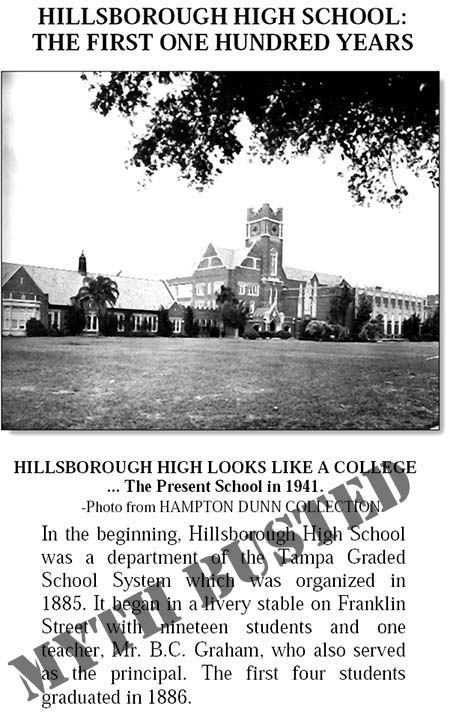
|
|
|
|
The school building was a
structure built in 1876 by John Givens and his son, Darwin
Branch Givens, on what was in 1911 the 500 block of Franklin
Street,1
between Madison and Twiggs Streets. This is the block
just north of the county courthouse as Doris' history
states.
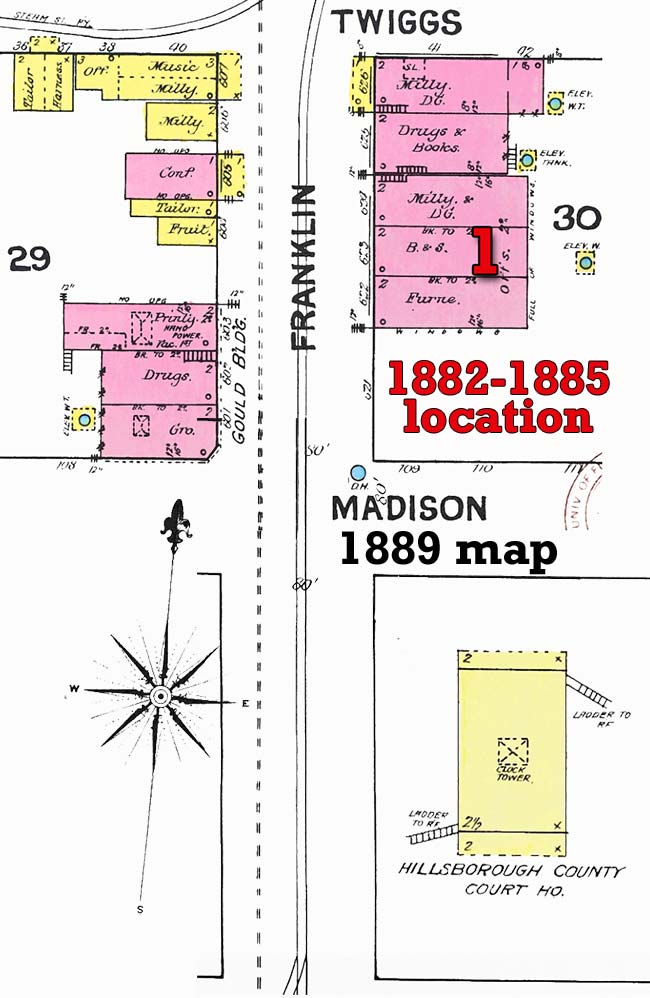
1889 Sanborn Fire Insurance Map from University of Florida
Digital Collections |
In E. L. Robinson's
"History of Hillsborough County" published in 1928, he states that
the schoolhouse was located "where the Shaw-Clayton bookstore
is now." Tampa's 1927 city directory shows this bookstore
was located at 509 Franklin St.
The Sanborn Fire
Insurance map at left is from 1889, the earliest year that any area
north of Madison St. is depicted on the Sanborn maps.
1Although
the 1889 map at left shows the block north of the
courthouse, between Madison and Twiggs, was the 600 block,
the 1892 map below shows the addresses along Franklin St.
were renumbered by 1892, and shows both the old 623 and the
new address 509 Franklin St. When Doris wrote her
history in 1911, that location was 509.
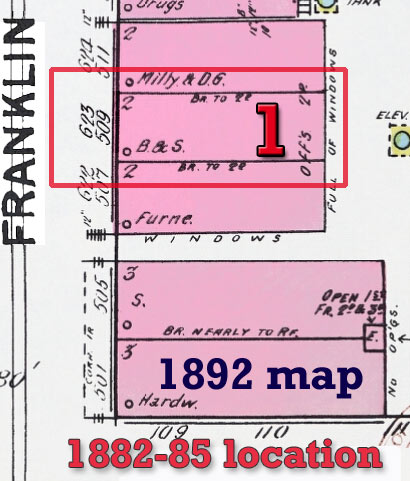
The school's location was at
the middle of the block of Franklin St., on the east side of
the street around where this map shows "B & S" (which could
stand for Books & Stationery.)
|
|
Since yellow structures were
wood frame buildings and the pink ones were brick, the
old wooden school building (everything was built from
wood in the 1870s) was apparently torn down and replaced by
the brick structures seen here in 1889. |
|
Present day
aerial view of this block.
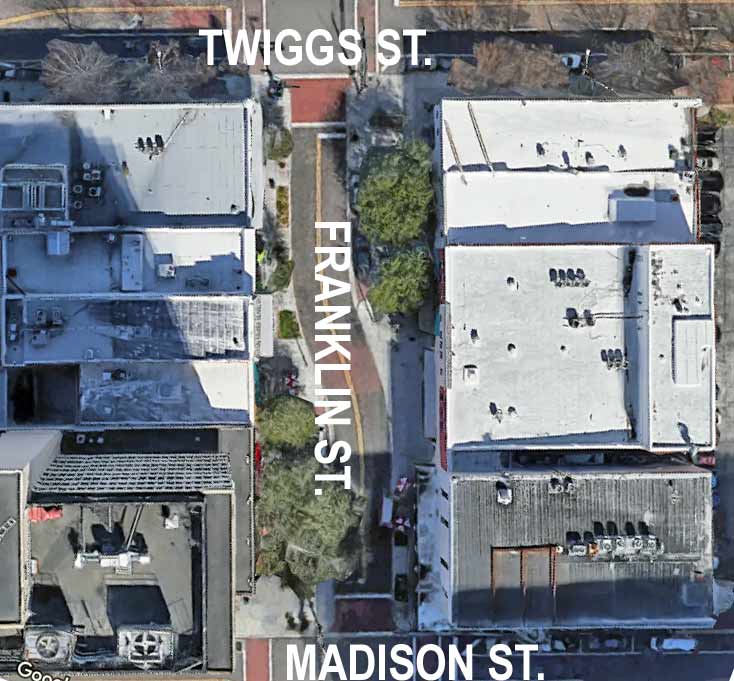
Recently, this address is
occupied by the CI Group.
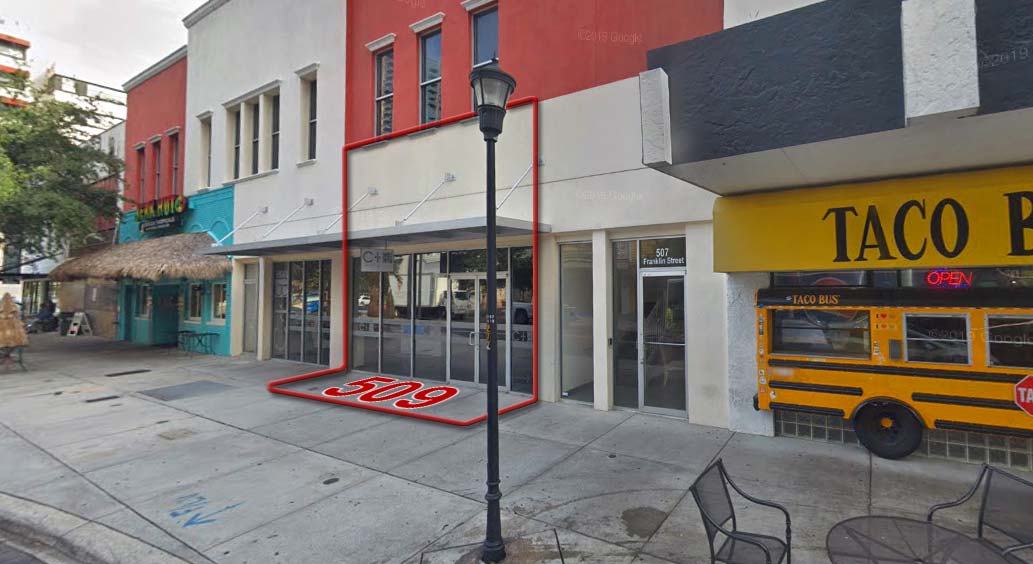
In 1929, E. L.
Robinson provided the early history of Hillsborough County's
education system in a Tribune article. Having just published
his book on the history of the county, the info would have been
fresh on his mind. This is an edited version with quite a bit
of the mid-section removed.
See the
WHOLE article here.
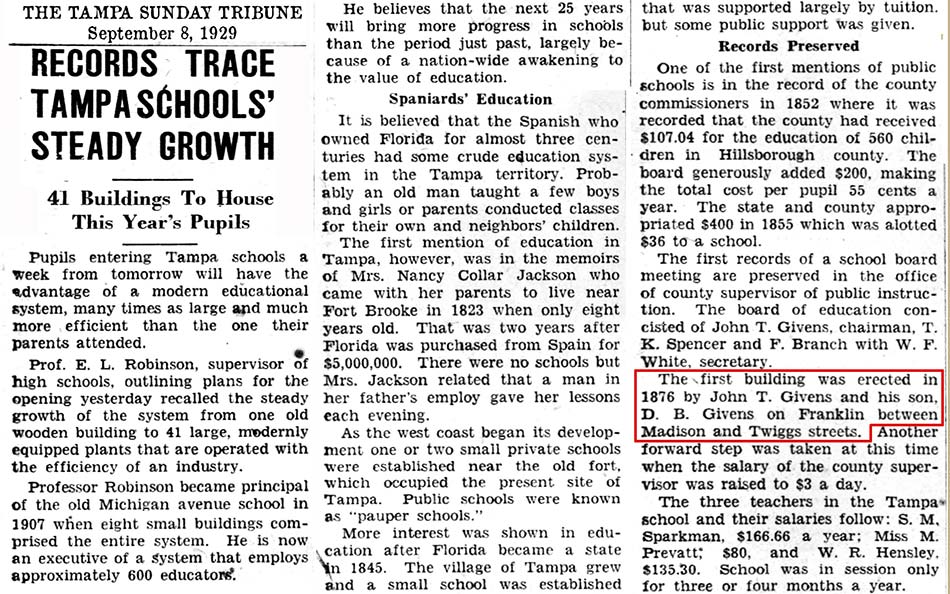
THE "IT STARTED
IN A LIVERY STABLE" MYTHCONCEPTION EXPLAINED
 According
to HHS historian Rex Gordon, the belief that the school started in a
livery stable is a result of misunderstanding E. L. Robinson's 1928
History of Hillsborough County. Robinson's history names a
later location of the high school as being in Maj. Wright's building
which was originally a brick livery stable on the northwest
corner of Florida Ave. and Madison Street. This location was
actually the 5th location. Robinson does not state that the
school began in that building or a livery stable. According
to HHS historian Rex Gordon, the belief that the school started in a
livery stable is a result of misunderstanding E. L. Robinson's 1928
History of Hillsborough County. Robinson's history names a
later location of the high school as being in Maj. Wright's building
which was originally a brick livery stable on the northwest
corner of Florida Ave. and Madison Street. This location was
actually the 5th location. Robinson does not state that the
school began in that building or a livery stable.
What Robinson wasn't aware of (or
forgot about) when he wrote his history of Hillsborough County was
Doris Hill's history of the school in 1911, sealed in the new
school's cornerstone time capsule, 17 years before he published his
book. |
|
|
|
NOT THE HOME OF
HILLSBOROUGH COUNTY HIGH SCHOOL! |
|
A photo that is often
used to depict the livery stable location of the first Hillsborough
County high school clearly shows a wooden structure with no access
for horses and, in fact, is not a stable but the first home
of the Hillsborough Masonic Lodge. (A fact also verified by the
Hillsborough Masonic Lodge website, which shows the same image as
their first home on the corner of Whiting and Franklin St.)
The
building was built by the Masons for use as their
meeting house. It is referred to as a school
building in this article because it was used during
the day to teach classes.
This was NOT a county public high school, nor did it
ever become one.
The first
Hillsborough Lodge building was built on the corner of
Whiting and Franklin Streets, Downtown Tampa, in 1852. |
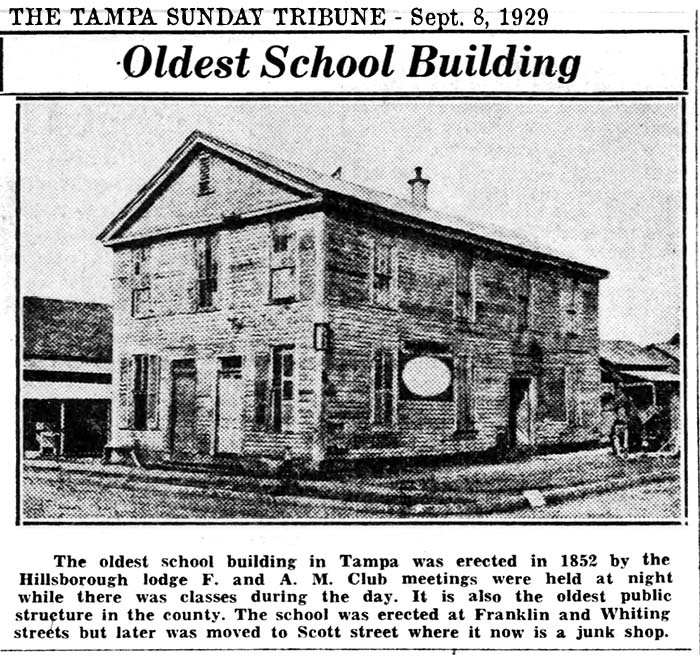 |
| |
|
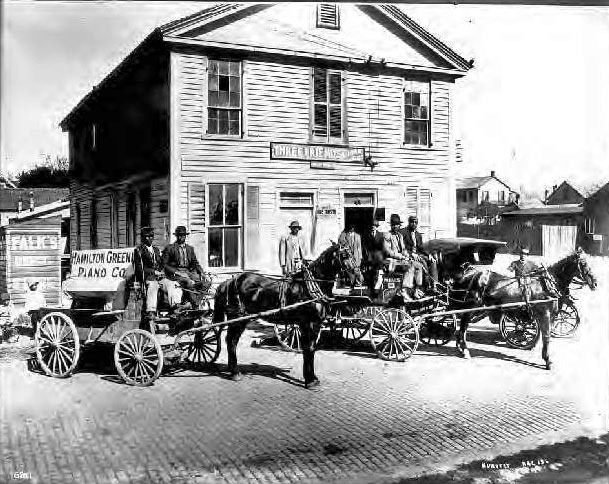
Three Friends Cigar
Company and Mims Transfer, East Scott Street, with
employees in wagons in front of building.
|
The
old Lodge became the "Three Friends Cigar Co." after
it was moved here to Scott St.
The building was
never the site of Hillsborough County High School.
Photo courtesy of
Tampa-Hillsborough Co. Public Library Cooperative,
Burgert Bros Collection.
|
|
The fact that four high
school students graduated in 1886, which when one considers would
have been awarded after a four-year high school education, places
the school's founding in 1882, the same year given in Doris Hill's
history. This, and her mention of two principals before B.C.
Graham, indicate that the school started before 1885 and did not
start in a livery stable. |
MARIETTA CUSCADEN, FIRST PROFESSIONAL
CAREER PRINCIPAL OF TAMPA PUBLIC SCHOOL No. 1
Marietta Cuscaden was
the mother of early Tampa citrus grove grower and city council
president Arthur Weston Cuscaden, for whom
Cuscaden Park and swimming
pool in Ybor City are named. The park and the pool are
located on the site of Arthur Cuscaden's former groves which he
donated to the city.
Marietta Mastick
Cuscaden was born in Ohio, probably in Claridon township, Geauga
County, on April 10, 1834. According to the 1850 U.S.
Federal census, she was 16, living at home in Claridon with her
father Owen Mastick, 47, and her mother Harriet, 45. Living in the
same home were her sisters Elizabeth, 19; Lavinnia (or Savinnia/Sovinnia),
11; brothers Julius, 14, and B. Mastick, 6. Her father was born in
Vermont, a typical starting point for many of Northeast Ohio’s
settlers. Her mother, Harriet, was born in Connecticut. All their
children were born in Ohio.
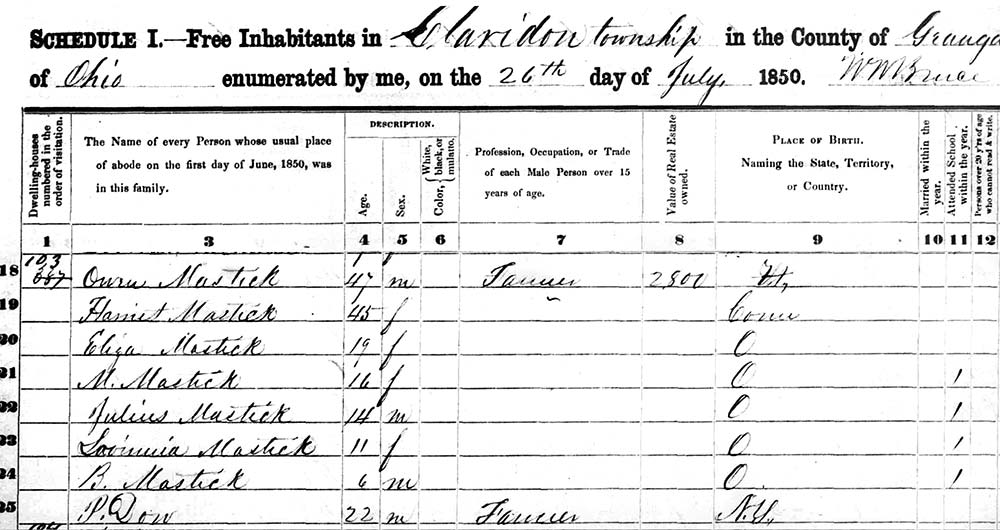
DR. THOMAS W. CUSCADEN
Thomas Cuscaden was a graduate of the
Eclectic Medical Institute in Cincinnati, Ohio. He first enrolled
there when he was 22 years old, beginning his first term on Mar. 5,
1853. Studying under Preceptor G. W. Bickley2,
he completed two courses and graduated in the spring of 1853.
He wrote his thesis on "Blood and the Causes of Circulation."
Eclectic Medical Institute Matriculation Roster-1845-1939

Age is age at 1st enrollment; Cinti=Cincinnati;
W=Winter and S=Spring (in both first-third enrollment terms and date
of graduation); y=years, and m=months (in “time of reading”
column); Freshman, Sophomore, Junior in “Comments” indicates
“admitted as” status; preceptors, unless otherwise noted are
physicians and/or professors.
2The
source of this information,
Eclectic Medical Institute
Matriculation Roster-1845-1939--composed
by John Haller, Lloyd Library and Museum, misspelled his name as "G.
W. Bigler." The correct spelling is seen in the image below, from
History of the Eclectic Medical
Institute, 1845-1902, Cincinnati, Ohio.
by Harvey Wickes Felter, MD, pub. 1902.
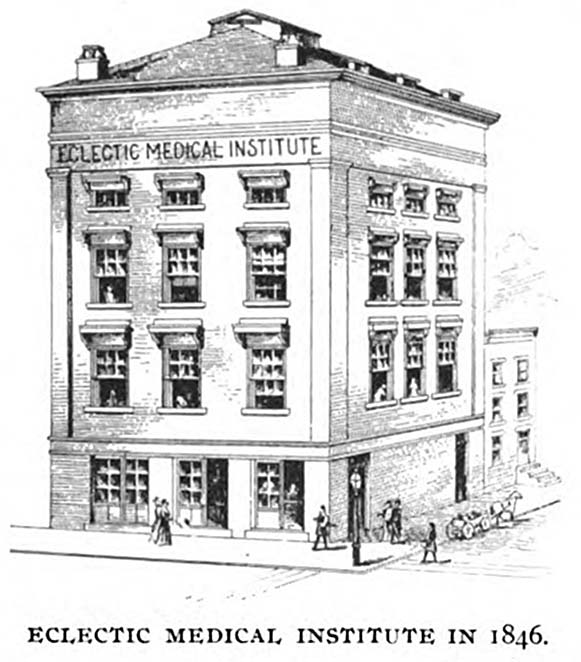 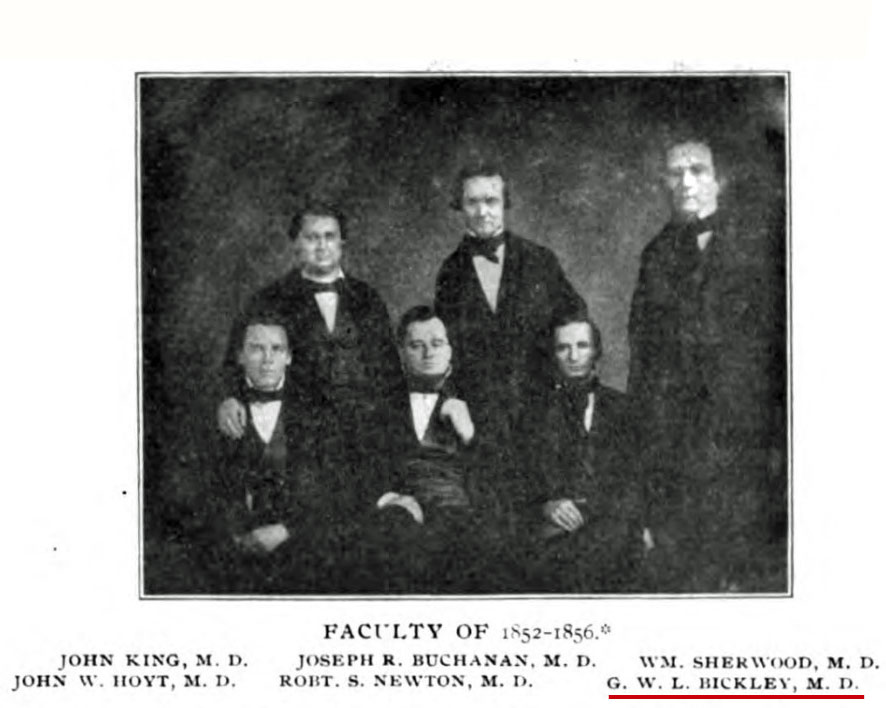
| Homeopathy is a
medical system based on the belief that the body can
cure itself. Those who practice it use tiny amounts of
natural substances, like plants and minerals. They
believe these stimulate the healing process. It was
developed in the late 1700s in Germany. It’s common in
many European countries, but it’s not quite as popular
in the United States. How Does It Work? A basic belief
behind homeopathy is “like cures like.” In other words,
something that brings on symptoms in a healthy person
can -- in a very small dose -- treat an illness with
similar symptoms. This is meant to trigger the body’s
natural defenses.
From Web MD - What is homeopathy? |
After graduation in 1853, Thomas
Cuscaden located just across the Ohio state line in Richmond,
Indiana where he first practiced homeopathy in 1853 with noted
homoeopathist Dr. Oliver Perry Baer. Baer had started his
practice there in 1849.

Dr. Baer later wrote,
My first
year's practice amounted to over $1,000, with a steady increase
until in four years I found it necessary to add a second
physician, and accordingly, Dr. Minier came, but being timid to
fight his way among so many
allopaths, he in a few months left for Rock Island, Illinois
and Dr. Cuscaden took his place. He after some two
years' commendable practice, he moved to Lebanon, Ohio...
Dr. Cuscaden opened a
practice in Warren County, Lebanon, Ohio in 1854, being the first
homeopathic physician in that area.
MARRIAGE OF DR. THOMAS CUSCADEN & MARIETTA MASTICK
On Sept. 2, 1858, Marietta Mastick married Dr. Thomas W. Cuscaden in
Geauga County, Ohio. Thomas was a highly-esteemed physician in
Warren County, Lebanon, Ohio and was well-known for being the first
resident homoeopathist in the county. Thomas and Marietta's
son, Arthur, was born in 1859 in Claridon, Ohio.
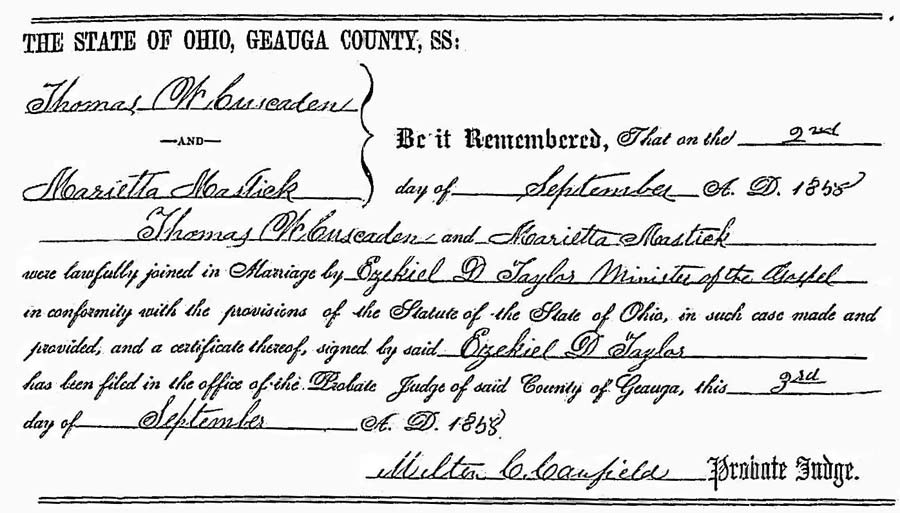
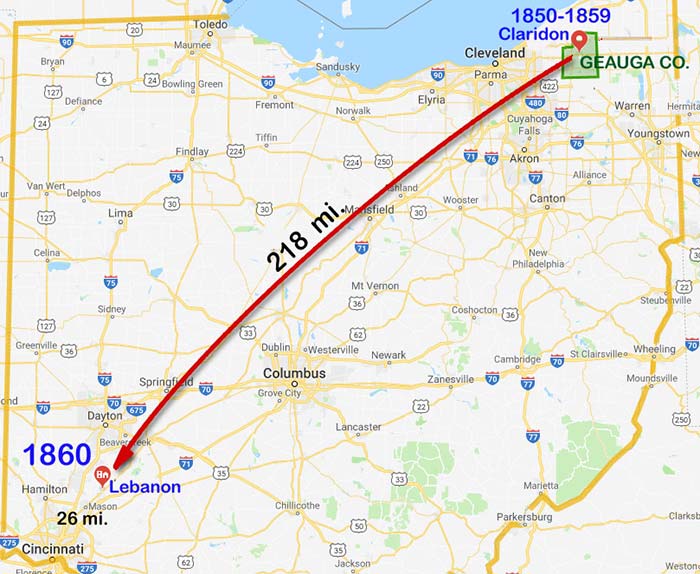
By 1860, Thomas had settled back in
Lebanon with Marietta and his son Arthur, which is about 26 mi.
northeast of Cincinnati.
MARIETTA TEACHING
BY 1860
On the 1860 census of Lebanon,
Ohio, Thomas W. Cuscaden was a physician, and born in Virginia.
Marietta was a teacher, age 25, born in Ohio, and their son, Arthur
was 1 year old. Also in their home was 19-year-old S. S. (or
L. L. ) Mastick who was probably Sovinnia,/Lavinnia, a sister of
Marietta. Notice Column 11 erroneously shows they married within the
year. In 1862, Thomas and Marietta would have a daughter named
Mary.
1860 Census,
Lebanon, Warren Co, Ohio
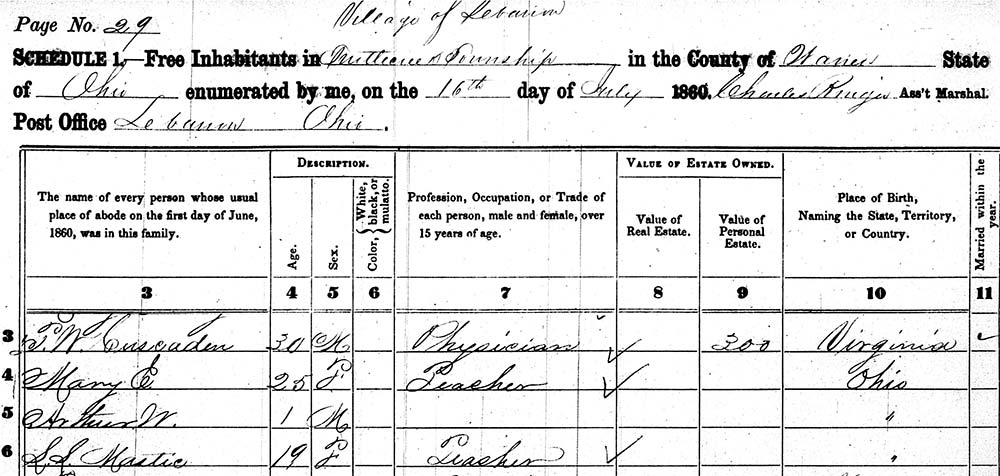
In "The History of
homeopathy and its institutions in America," the author states
of Dr. Cuscaden in Lebanon, Ohio, "Although it was said that he
could not remain, he did so until his death in 1861". Dr.
Cuscaden's death was attributed to "consumption."
-
Eclectic Medical Institute
Matriculation Roster-1845-1939--composed
by John Haller, Lloyd Library and Museum
-
History of the Eclectic Medical
Institute, 1845-1902, Cincinnati, Ohio.
by Harvey Wickes Felter, MD, pub. 1902
-
History of homeopathy and its
institutions in America;
their founders, benefactors, faculties, officers, Hospitals,
alumni, etc., with a record of achievement of its
representatives in the world of medicine by King, William
Harvey, Pub. 1905.
According to
THE HISTORY OF WARREN COUNTY, published by W. H. Beers & Co. in
1882, Thomas Cuscaden died in Lebanon in 1861. He was just 31
years old.
|
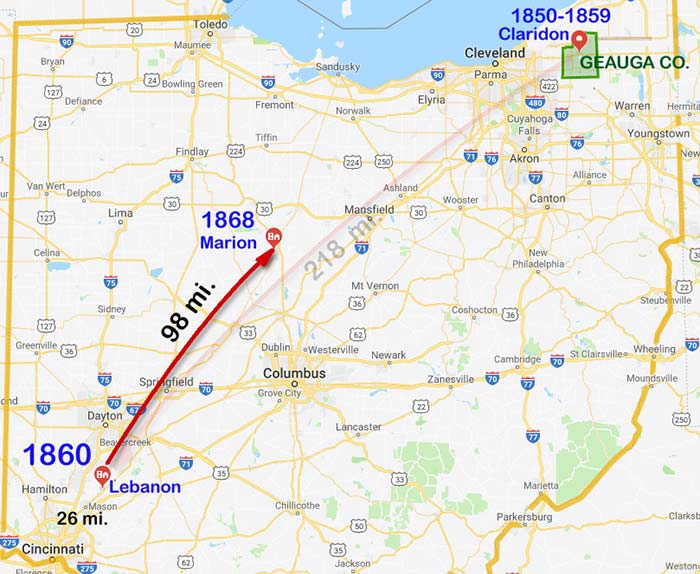 |
SUPERINTENDENT OF MARION UNION SCHOOL
By 1868, Marietta had
taken the position of Superintendent of Marion Union
School, (the predecessor to Marion City School) about
100 miles back towards Claridon, to the northeast.
The
Marion Star website,
Adams named Pleasant Local superintendent, by
Reporter Andrew Carter, March 21, 2017.
In between Marietta's
Lebanon and Marion positions was the Civil War.
On a visit
back to Marion in 1890, the Marion Star printed this
brief article which references Marietta was "at one time
principal of the Marion High School...
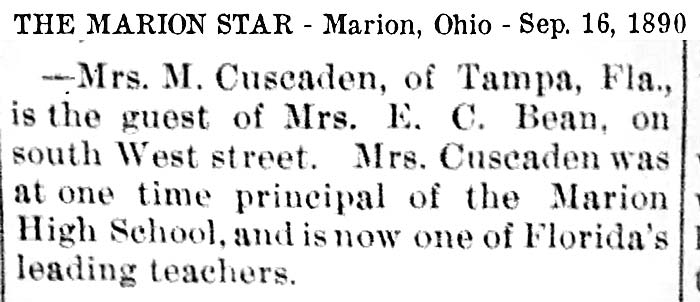
|
On the 1870 census Marietta was
back in Claridon Township with her parents Owen & Harriet Mastick, along
with her children Arthur W. Cuscaden, age 10, and daughter Mary L.,
age 8. Apparently, Mary L. was born just after her father
died. Marietta continued her career in education there, being
listed as a school teacher..
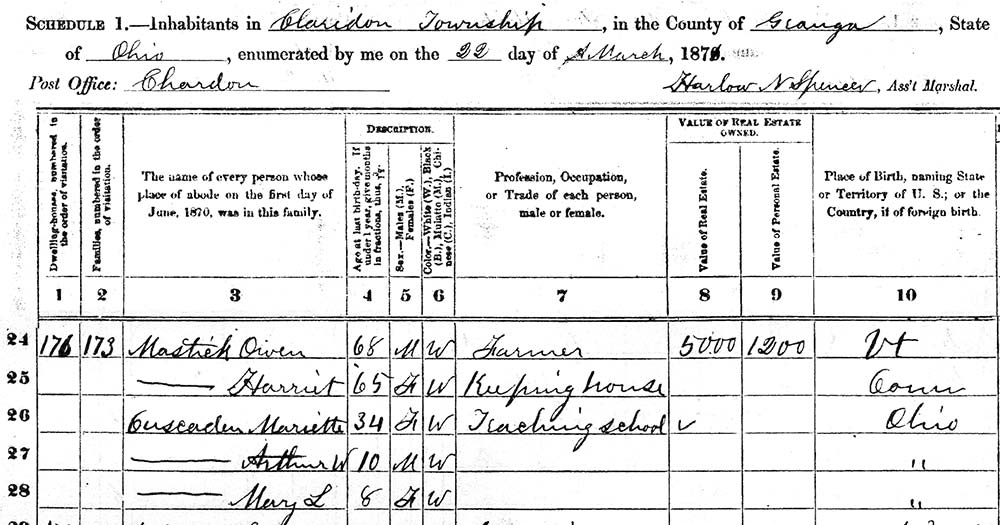
|
MARIETTA AT HIRAM
COLLEGE
Hiram, Ohio
"Mrs. Cuscaden is a lady of large experience as a teacher,
and of excellent reputation among the teachers of Ohio."
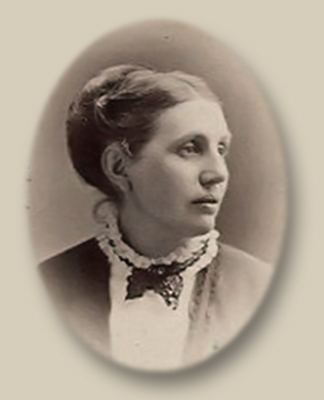
Marietta
Cuscaden photo from Hiram College Archives.
Special thanks to
Rex Gordon for obtaining and
sharing the photo, and to Jennifer S. Morrow, M.
A. Hiram College Archivist, who provided Rex with the
rare photo of Marietta seen here, along with the
following information about Marietta:
In 1871
Marietta Cuscaden took a position on the faculty of
Hiram College. She probably received her
college education there when the institution was the
Western Reserve Eclectic Institute. It was founded
in 1850 and became Hiram College in 1867. (Her son
Arthur also attended Hiram College.)
-Marietta-Cuscaden-to-take-of-ladies-principal-1872.jpg)
In 1871 Marietta was named successor to Miss Jackson as
Principal of the Ladies Dept. and she started in that position the
following year. She served as Lady Principal of Hiram College
from 1872-76.
According to Francis Marion Green’s Hiram College and
Western Reserve Eclectic Institute: Fifty Years of
History 1850-1900, the Lady Principal was
responsible for the “interests and conduct of the (36)
young women in the school."
Cuscaden’s name first appears in the list of faculty in
the Annual Catalogue of Hiram College for the year
ending June 1872. That same source notes that Cuscaden
also headed the Department of English Studies, whose
courses included Grammar, Descriptive Geography, and
Arithmetic. The catalogue noted that Cuscaden “is aided
by competent assistants.”
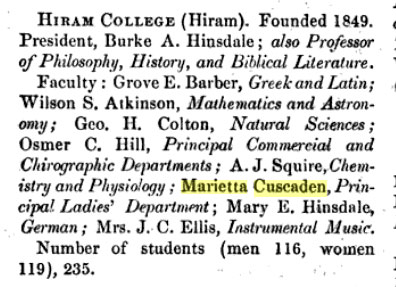
In describing Mrs. Cuscaden the catalogue notes that she
“brings to her position a large and successful
experience as an educator.”
In the 1872 catalogue, the department that Mrs. Cuscaden
headed was renamed the Department of Higher English. The description
of her qualifications now includes the statement “...she having been
identified for several years with public schools of Ohio.” In
addition to teaching the courses listed for her department, Cuscaden
is listed as teaching Algebra and Botany. |
HISTORY OF HIRAM COLLEGE
Combined from
the school website and
Wikipedia (also the source of the two photos.)
Hiram College is a private
liberal arts college in Hiram, Ohio, founded in 1850 as
the Western Reserve Eclectic Institute. The
college is nonsectarian and coeducational and is
accredited by the Higher Learning Commission. Hiram's
most famous alumnus is James A. Garfield, who served as
a college instructor and principal before he was elected
the 20th President of the United States.
On June 12, 1849,
Amos Sutton Hayden and other members of the Disciples of
Christ Church voted to establish an academic
institution, which would later become Hiram College.
On November 7 that year, they chose the village of Hiram
as the site for the school because the founders
considered this area of the Western Reserve to be
"healthful and free of distractions". The
following month, on December 20, the founders accepted
the suggestion of Isaac Errett and named the school the
Western Reserve Eclectic Institute and the school opened
on November 27, 1850.
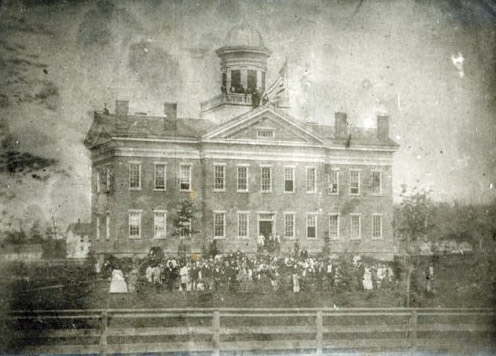
Western Reserve Eclectic
Institute, Hiram, Ohio, 1858.
Photo from Wikipedia
provided by Hiram College.
Many of the students
came from the surrounding farms and villages of the
Western Reserve, but the school soon gained a national
reputation and students began arriving from other
states.
During the years that
it was the Western Reserve Eclectic Institute
(1850–1867), the school had seven principals, the
equivalent of today's college presidents.
The two that did the
most in establishing and defining the nature of the
institution were Disciple minister Amos Sutton Hayden,
who led the school through its first six years, and
James A. Garfield, who had been a student at the
Institute from 1851–1853 and then returned in 1856 as a
teacher. As principal, Garfield expanded the Institute's
curriculum. He left the Institute in 1861 and in 1880
was elected the 20th President of the United States.
On February 20, 1867,
the Institute incorporated as a college and changed its
name to Hiram College.
Below: James A.
Garfield (left), his wife Lucretia Rudolph Garfield
(right) and other faculty, 1858.
Photo from Wikipedia provided by Hiram College.
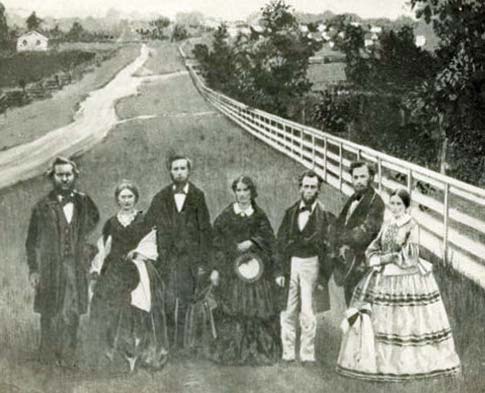
In 1870, one of
Garfield's best friends and former students, Burke A.
Hinsdale, was appointed Hiram's president. Although
there were two before him, Hinsdale is considered the
college's first permanent president because the others
served only briefly. The next president to have a major
impact on the college was Ely V. Zollars, who increased
enrollment significantly, established a substantial
endowment and created a program for the construction of
campus buildings. Later presidents who served for at
least 10 years were Miner Lee Bates, Kenneth I. Brown,
Paul H. Fall, Elmer Jagow, and G. Benjamin Oliver.
The complete history of Hiram College is on their
website. |
|
Scenes of Hiram Campus
today, from the
Hiram College website. |
|
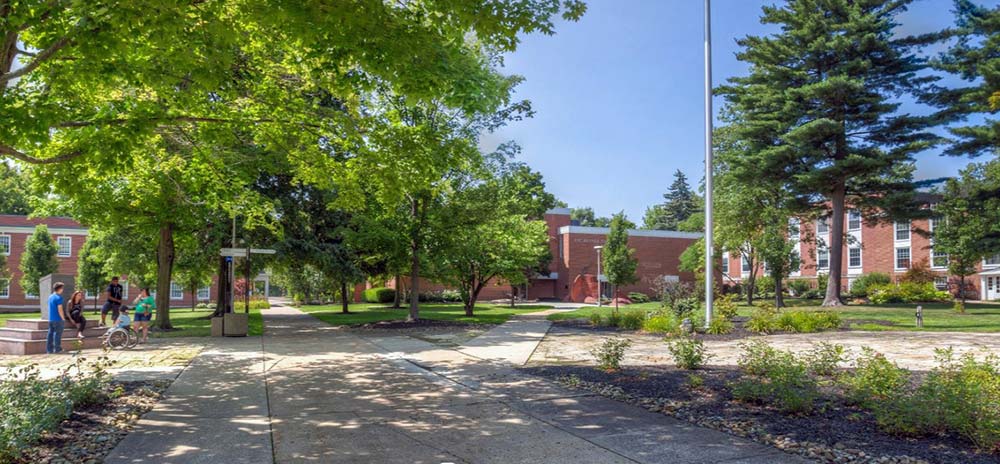 |
| |
|
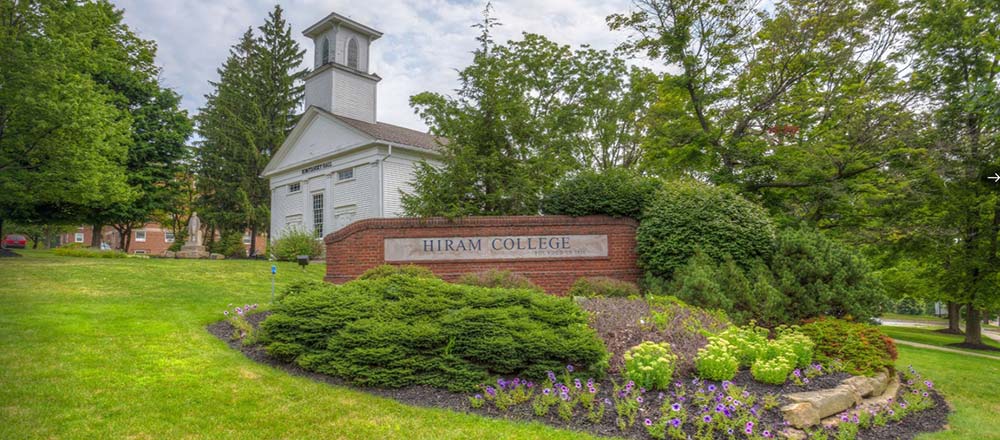 |
| |
|
MARIETTA IN FLORENCE, ALABAMA
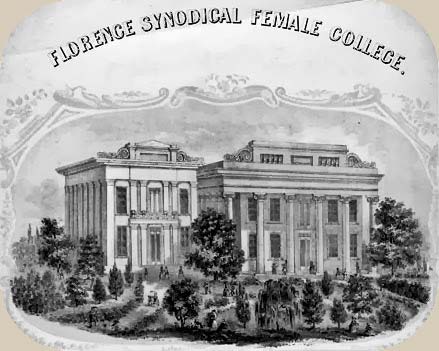 After
her last term as Principal of the Ladies Department at
Hiram in 1876-77, Marietta took a position in Florence,
Alabama as Principal or
President at the Florence Synodical Female College some
time by 1880. After
her last term as Principal of the Ladies Department at
Hiram in 1876-77, Marietta took a position in Florence,
Alabama as Principal or
President at the Florence Synodical Female College some
time by 1880.
(At this point, it isn't
known conclusively that she went there directly after
leaving Hiram, or if she came to Tampa first with her
son Arthur in 1878 and then went to Florence, then
returned to Tampa to become the Principal at HCHS in
1882. It is more likely that she went to
Florence from Hiram College.)
Her absence on the 1880
U.S. Census in Tampa is anindicator that she was in
Florence, Ala. at the time.
The image on the right is
courtesy of D. R. Curott's "More
Signs of the Past.
Commisioner's report on education 1880
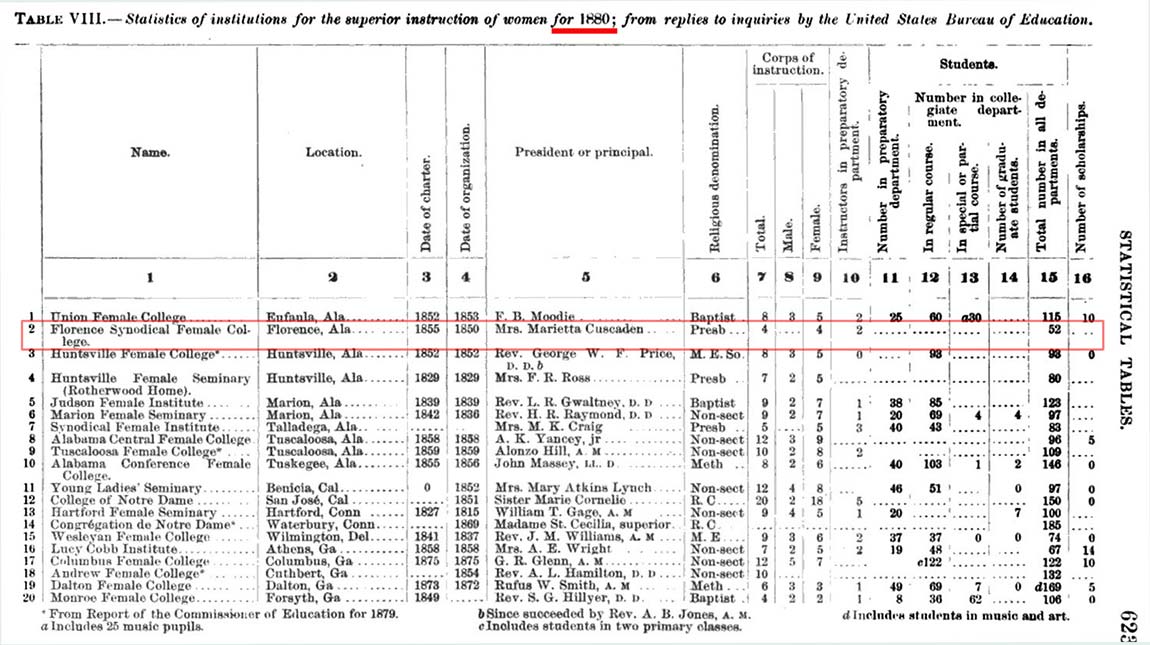
These images below are courtesy of D. R.
Curott's "More
Signs of the Past."
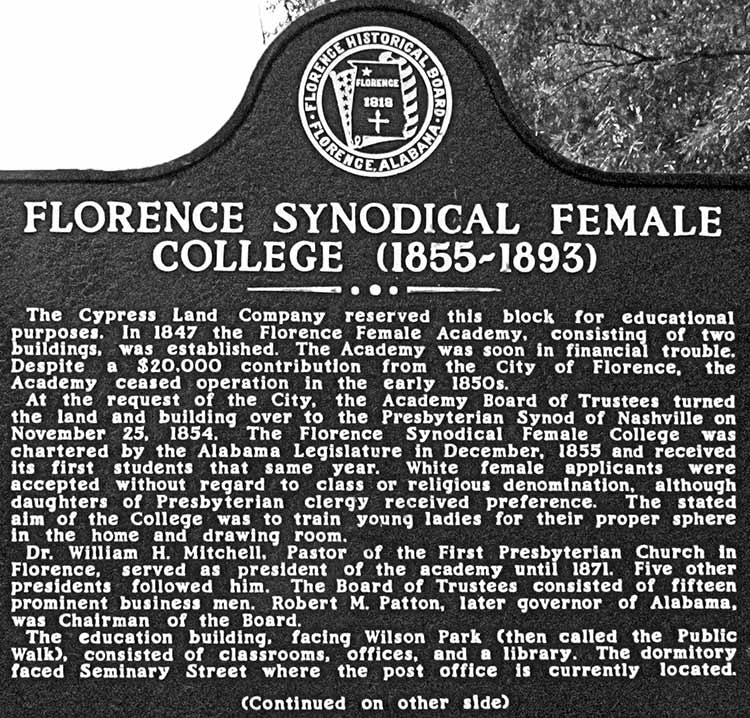
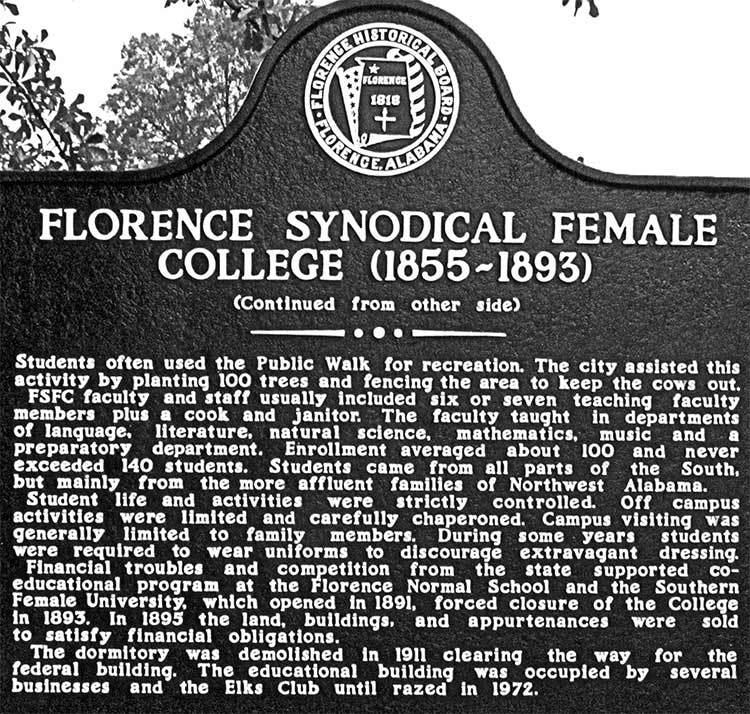
|
MARIETTA CUSCADEN COMES TO TAMPA
During the
1880's, most teachers had second occupations due to two
factors: Salaries were meager and averaged between $150
and $180 per year. Teachers were paid in a lump sum at
the end of the school year. These factors made it
difficult for the Board to secure highly trained and
qualified teachers. Thus, staffing has been a
long-standing problem for the school district. Despite
this, some early public school teachers went on to
significant accomplishments.
Marietta came to Tampa in
1881 and joined her son, Arthur W.
Cuscaden, who came to Tampa in 1878. By 1880,
Arthur was in the citrus, cigar and real estate
business, with orange groves in the area that would
become Ybor City. In 1890, he married Frances
Robles, a daughter of Tampa pioneers Joseph and Mary Ann
Robles.
Marietta wasted no time
"hanging out her shingle." She probably had the highest teaching
credentials of any woman or man to arrive in Tampa thus
far. With an actual teaching
degree, she was qualified to teach the subjects she
offered. She wasn't someone who was just "good at
teaching" and therefore decided to teach. She had
professional teaching experience and experience at the
position of principal. Even more, she had several
impressive references.
Marietta offered what NO OTHER school had offered
before--THREE types of programs: Classical,
Scientific and English. Higher Math, Common
English, Instrumental AND Vocal music, Painting and
Drawing.
The ad at right ran on
Dec. 17 & 29, 1881, and Jan. 5 & 12, 1882
|
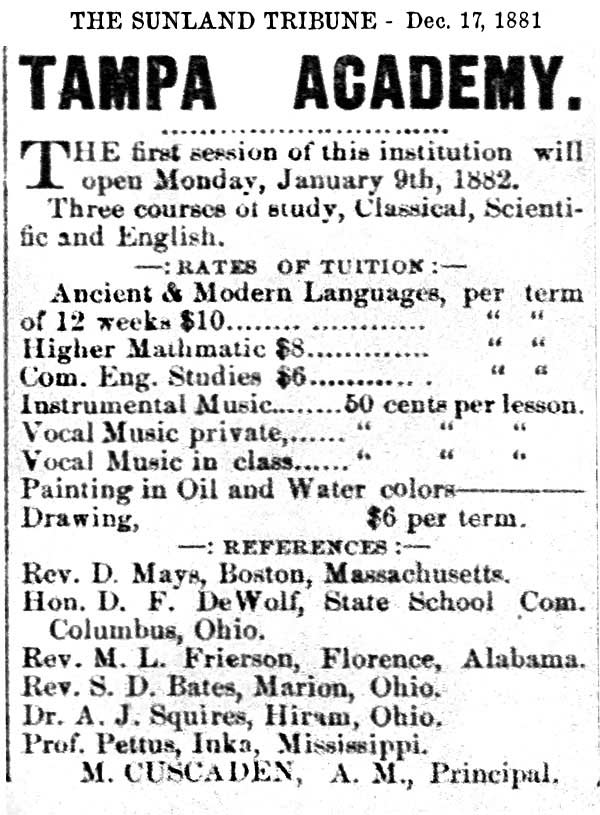 |
THE MOST COMPLETE COUNTY HIGH SCHOOL
PROGRAM AT TAMPA FREE SCHOOL
It didn't take
long for the county school board to take
notice. A month after advertising her
school, Marietta had a job teaching the
higher classes at the Tampa Free School--
$160, probably for one term.
Assuming the School Board had Marietta
teaching the same courses, or at least the
Math, Languages, and Scientific courses, we
can safely say this was the start of
Hillsborough County's most organized and
complet Public High School curriculum. |
|
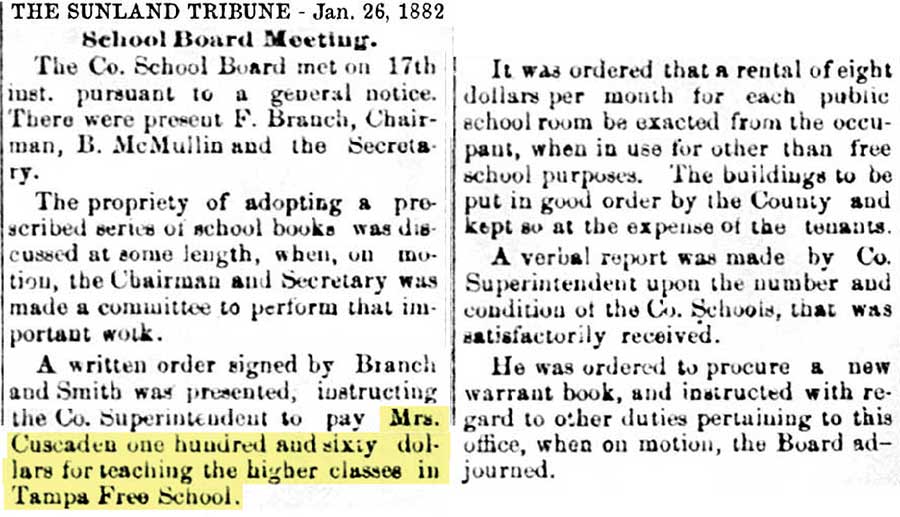
HOW MUCH WOULD
$160 IN 1882 BE TODAY?
According to
the Bureau of Labor Statistics consumer
price index, today's prices in 2019 are
2,423.00% higher than average prices
throughout 1882. The dollar experienced an
average inflation rate of 2.38% per year
during this period, meaning the real value
of a dollar decreased.
In other
words, $160 in 1882 is equivalent in
purchasing power to about $4,036.80 in 2019,
a difference of $3,876.80 over 137 years.
That's really
not much for 5 or 6 months.
In
1882 the
Hillsborough County Board of Education was
operating 57 schools throughout the county
at a cost of $4,225. The great
majority of these schools were scattered
throughout the rival areas of the county.
The Board actually contributed very little
to the formation of many of these small
"community schools". The local communities
not only provided the facilities, but also
provided furniture, materials, room and
board and supplemental salary for their
teachers. Many rural schools did not remain
open as long as the Tampa schools. Board
minutes stated that the term of instruction
was set at five months except in Tampa
schools where students went to school for 6
months. This provided additional work time
on the farms for the students in the rural
schools. |
|
|
|
|
At the end of the school term, the school
board met to estimate what funds would be
needed to operate the fall term starting
Oct. 1, 1882.
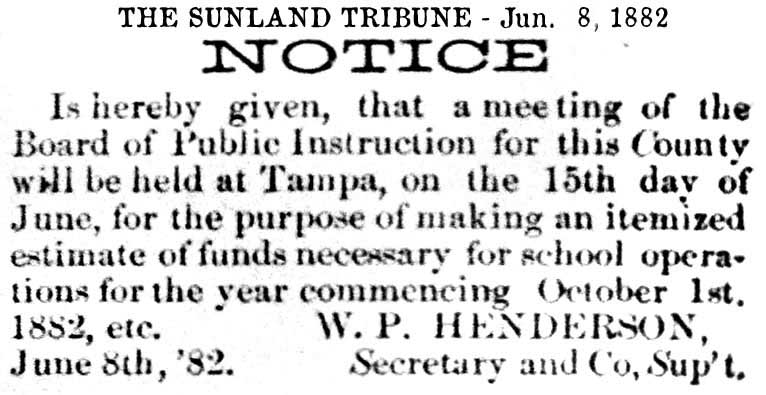 |
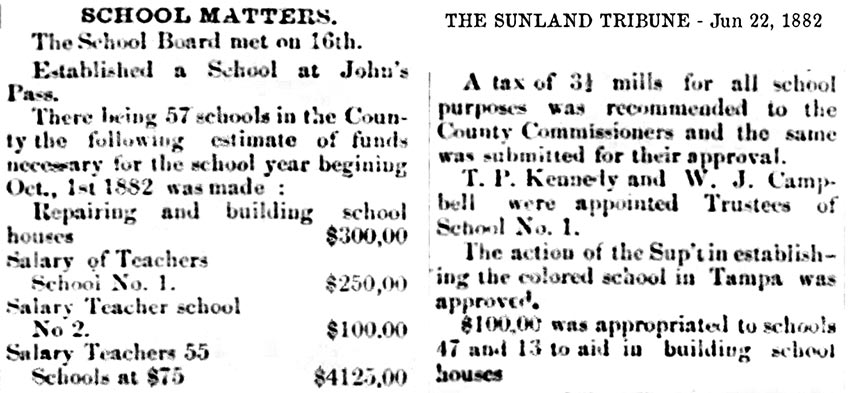 |
|
They concluded
that $250 would be needed for teacher
salaries at Tampa School No. 1, $100 for
School No. 2, and the other 55 schools would
get $75 each for teachers.
A "PEP TALK" FROM THE STATE
SUPERINTENDENT OF PUBLIC
INSTRUCTION
The Sunland Tribune printed this
message from E. K. Foster, the
State Superintendent of Public
Instruction, July 13, 1882:
|
To
the County Superintendents of
Schools in Florida, |
|
|
As the time is approaching for
the selection of teachers for
the next scholastic year, I take
this method of calling your
attention to the necessity that
great care and the closest
scrutiny should be observed by
you in selecting teachers.
The teacher should be
sufficiently educated himself to
be able to educate others.
Your examinations should
therefore be thorough, and no
motive should enter in you
selection of teachers but such
as tend to improve the schools
and scholars. The teacher,
during school hours, exerts a
great influence into the moral
character of those applying to
teach, and should issue
certificates only to those who
you know, or have satisfactory
reason to believe, are of good
character. Under no
circumstances issue certificates
to those who may be addicted to
intemperance; their example to
scholars is and would be very
dangerous. |
I hope the circular will receive
due consideration. One of
the great needs of the school
system in this State is a better
class of teachers, and this can
be secured only by proper
discharge of your duty.
I have issued, during the year, a number of
first-class certificates.
I shall send to each of you a
list of those holding these
certificates, and if you know of
any good reason, on account of
their character, why they should
not hold the same, you will
please write me and I will
investigate the matter at once.
I will, in short time, address you a more general
circular in connection with our
mutual work--the bettering of
our public schools.
Very Respectfully,
E. K. Foster,
Supt. of Public Instruction |
|
|
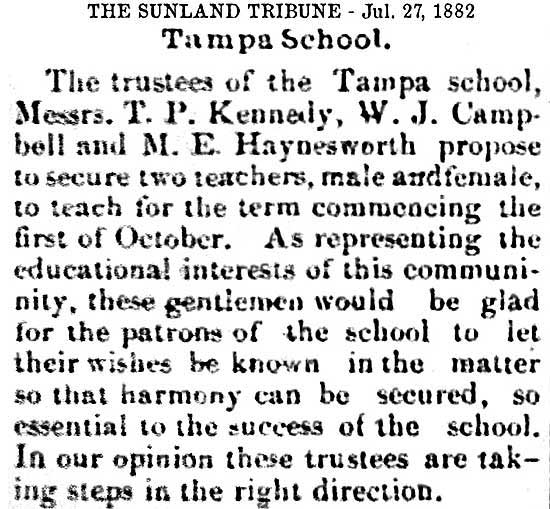
REQUEST FOR TEACHER SUGGESTIONS
The trustees
of Tampa School, also known as Tampa School
No. 1, which held classes at the Givens
school house on Franklin St, asked the public
to submit names of two teachers, male and
female, to be considered for the teaching
positions available in that district.
The Trib
agreed that soliciting the public is a step
in the right direction so that "harmony can
be secured."
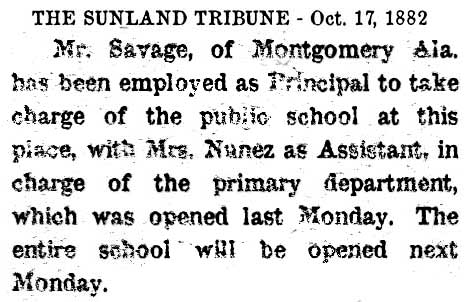 TWO
EDUCATORS CHOSEN TWO
EDUCATORS CHOSEN
So after the
lazy hazy days of the Tampa summer, the fall
term started a tad behind schedule, with a
Mr. Savage of Montgomery, Alabama, to be
employed as Principal of Tampa School No. 1
and Mrs. Nunez as Assistant Principal in
charge of the primary department. This
Oct. 17 article refers to primary classes
having started "last Monday," but Oct. 17,
1882 was a Tuesday. So it's unclear as to if
it started Oct. 16 or Oct. 9.
Apparently, the higher classes were waiting
on Mr. Savage to arrive so they planned to
start on the 23rd.
|
It's highly
likely that Marietta Cuscaden
was a candidate for the position
of Principal and teacher, but a
later article could mean that
the salary offered was
insufficient. The TOTAL
funding for both teacher
salaries at this school, as
announced on June 22, was to be
$250. |
WHO WAS MR. SAVAGE?
A search of
the Tampa 1880 Census finds no suitable
possibilities for Mr. Savage, but the
Montgomery, Ala. 1880 Federal Census has one
Mr. Savage with an occupation in the realm
of education--a teacher. He is 29 year
old John Savage, born in Ireland of Irish
parents, and boarding in the home of Richard
Savage and his family. Since John is
listed last as a boarder, it indicates he
wasn't a child of the head of house.
He was probably a nephew, possibly a son of a brother
of Richard.
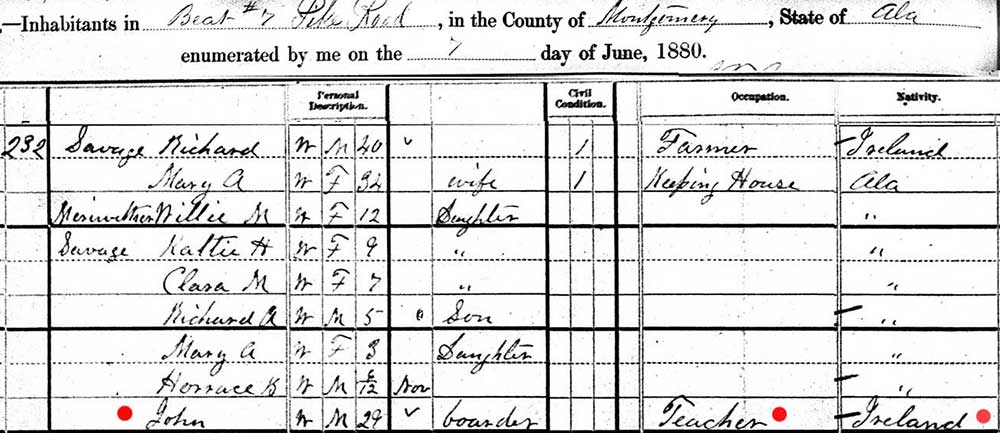
MARIETTA REOPENS HER PRIVATE SCHOOL
|
 |
|
On the same day
it was announced that Mr. Savage
and Mrs. Nunez would be
Principal and teachers of the
public school, this short
article might be an indication
that Marietta thought she could
earn her worth with her own
school, this time in the Masonic
Lodge building. |
|
|
MR. SAVAGE DECLINES, MARIETTA TAKES CHARGE OF THE HIGH
SCHOOL |
|
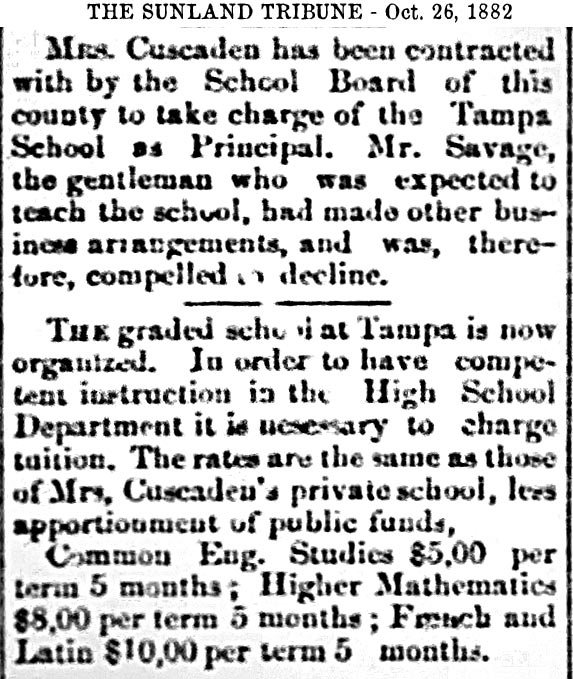 |
This Oct.
26, 1882 article states that the graded school system
was now organized. Marietta was hired to the position
of Principal of the Tampa School when "Mr. Savage, the
gentleman who was expected to teach the school had made
other business arrangements and was therefore compelled
to decline."
|
Being a highly qualified
teacher/Principal and well worth
keeping in the county school
system, the School Board may
have offered to pay her as much
as she could make in her private
school to take this position, "in
order to have competent
instruction in the High
School Department, it is
necessary to charge tuition."
A clear distinction was made in
reference to a High School
Department. |
Common
English Studies.....$ 5 per 5 mo. term
Higher Mathematics...........$ 8 per 5 mo.
term -->
French & Latin.........................$10 per 5 mo.
term |
First time Higher Math offered
in a public school building. |
|
"The
rates are the same as those of Mrs. Cuscaden's private
school, less apportionment of public funds."
Does this disqualify it from
being a public school?
No, the tuition was being
charged by the County School
Board, not by Marietta.
Marietta was being paid by the
county what she would have
earned privately. The
county would charge tuition by
that same amount they paid
Marietta, less the amount
apportioned by the County not
used to cover the rest of the
operating costs, including the
salary of Mrs. Nunez. |
|
|
|
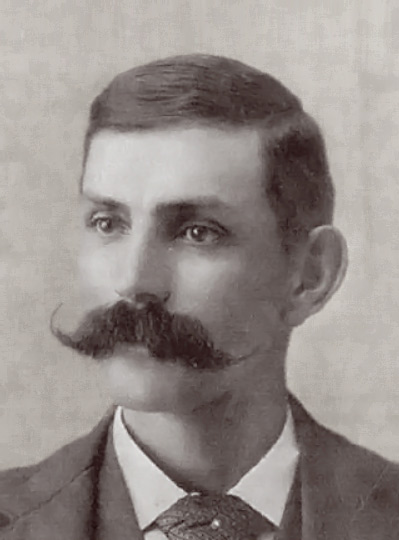
Arthur W. Cuscaden
Tampa
City
Council President
June 5, 1902 – June 5, 1904
|
ARTHUR CUSCADEN
Born
in Ohio on June 8, 1859, Arthur Weston Cuscaden
was a graduate of Hiram College. He settled in Tampa
in 1878 and planted one of the first orange groves
in the city. He remained active in the citrus
industry until his retirement. Cuscaden also worked
in the cigar business. He ran for mayor in 1906, but
lost to William H. Frecker. He served several terms
as a member of the county’s school board and he had
a son named Arthur Cuscaden, Jr., who also worked in
the cigar industry. After his death in 1941, a park
and pool in Ybor City was named in his honor. For
many years the park had served as a gathering place
for cigar workers in the neighborhood to play
baseball, watch boxing matches, and meet up with
their friends. The pool, designed by architect
Wesley Bintz, opened in 1937.
Bio and photo from
"The City Council of Tampa and Celebration of Old
City Hall's Centennial
More about the Robles family in Tampa
More about Arthur W. Cuscaden and the park named for
him
|
|
MARIETTA
BUYS LAND NORTHEAST OF TAMPA
As Doris
Hill's 1911 school time capsule history stated, the
Hillsborough Co. High School started as a department of
Tampa School No. 1 on Franklin St. There, a high
school course was introduced for the first time in 1882
when Mary (Marietta) Cuscaden was principal and Wesley
P. Henderson was County Superintendent.
Mrs. Cuscaden was principal for two years. In 1884, she was
succeeded by Dr. Raymond, and in 1885, the latter was followed
by Mr. B.C. Graham.
In 1884 Marietta bought 80
acres of land in Township 29 south, Range 19 east--the
northeast quarter of the southwest quarter, and the
northwest quarter of the southeast quarter in section 3.
Today, this land is just southwest of the former
Eastlake Mall where 50th street curves into 56th Street. |
| |
|
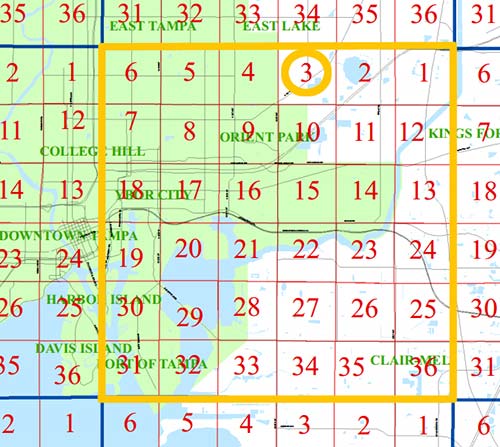 |
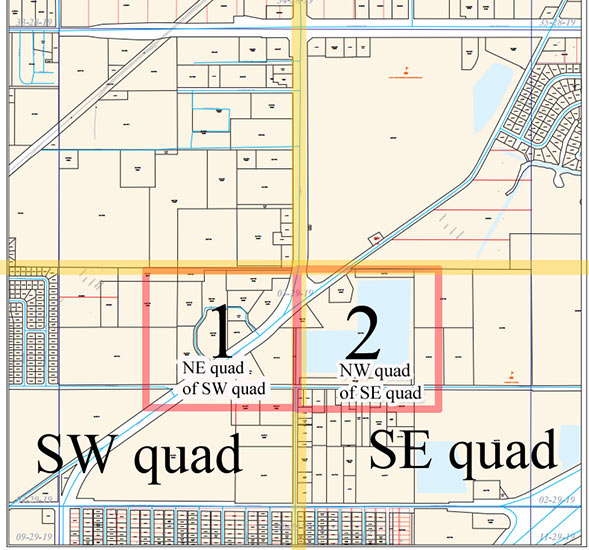 |
|
Township 29 south, Range 19 east
outlined in yellow. |
Close up of Section 3 showing
Marietta's property today.
Place your cursor on the image to see satellite view |
MARIETTA CUSCADEN ON THE 1885 FLORIDA STATE CENSUS
The 1885 state census of Florida
lists widowed, 50-year-old Marietta Cuscaden as a teacher, living
with her 24-year-old daughter Mary, who was a music teacher, and
their 36-year-old male farm hand, living in an unincorporated area
of Hillsborough County, surrounded by farmers. This location was
probably the land she had obtained in 1884.
1885 Florida
State Census, Hillsborough County

DEATH OF MARY L. CUSCADEN, MARIETTA'S DAUGHTER
On Nov. 4, 1887,
Marietta's daughter died from Yellow Fever. At the time, Tampa
was experiencing a Yellow Fever epidemic, although the local paper,
The Tampa Journal, refused to recognize it as such. A list of
the dead for the week published in the Nov. 10, 1887 Tampa Journal
shows over SIXTY deaths. Although the causes weren't listed,
most, if not all, were likely due to Yellow Fever. This was
over TEN TIMES the normal number of deaths in a week.
Even after
several weeks, when Dr. John P. Wall confirmed it was Yellow Fever,
the Herald grudgingly admitted as to Yellow Fever, but continued to insist
it wasn't an epidemic, that it was over and no longer a problem.
Tampa blamed its start on a visitor from Jacksonville, and so an animosity
existed between the newspapers in both cities. See "The
Final Battle for Ft. Brooke" at TampaPix for more about this.
|
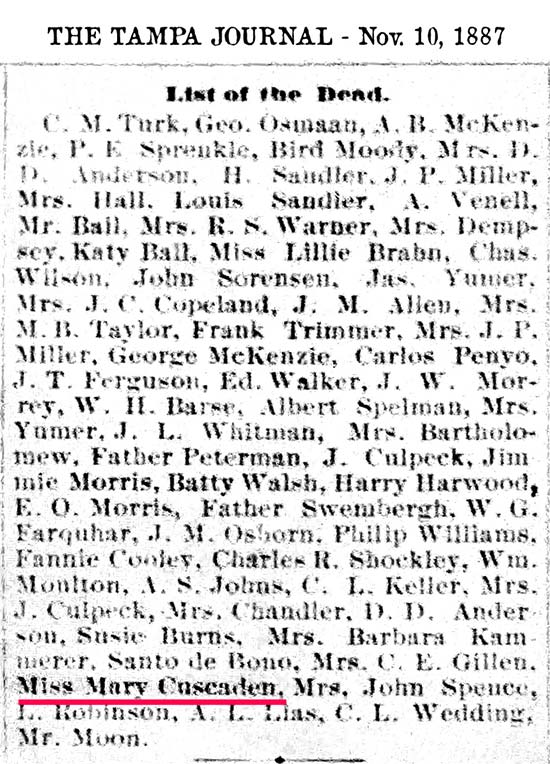 |
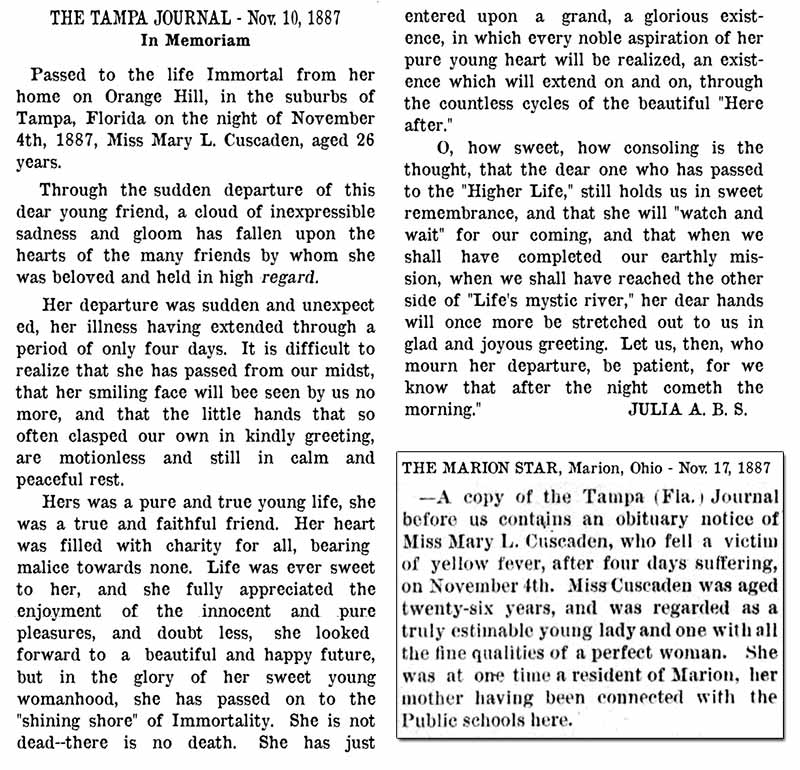 |
|
Mary L. Cuscaden was only
26 years old and passed away after only four days of
suffering with the disease. This was A LOT of deaths for
a week in Tampa.
At right is a transcription of the original article as
it appeared in the Journal. It was extremely faded
almost to the point of being illegible. Enhancement
was not much more legible. |
| |
|
|
MARIETTA AND THE AMERICAN THEOSOPHICAL SOCIETY
By 1900, Marietta served as the
secretary for the Tampa branch of the American Theosophical Society.
The society was founded in 1875 in New York City and was dedicated
to promoting the unity of humanity; to foster religious and racial
understanding by encouraging the study of religion, philosophy and
science; and to further the discovery of the spiritual aspect of
life and of human beings.
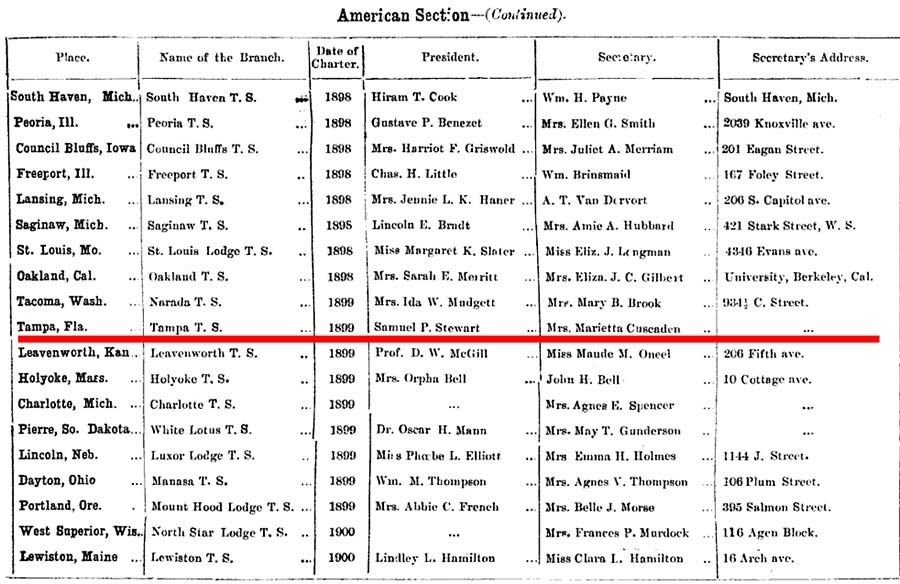
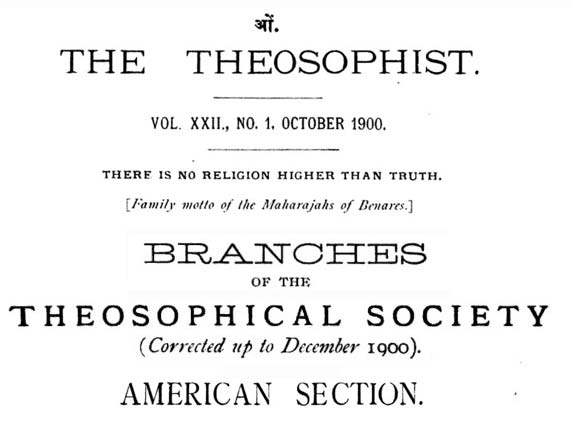
The Theosophist 1901
The 1910 Census in Tampa
shows Marietta lived in her own home which she owned, at
1317 Michigan Ave. She was widowed, age 76, living
alone and indicated she was living on her own income,
but no occupation indicated.
On her last census, 1920,
she was living with her son Arthur and his family at
1312 Michigan Ave.

Arthur W. Cuscaden was 60, his wife Frances was 54.
Their 3 sons Arthur W. Jr. 27, Ernest M. 23, and Thomas
W. 20. Only Ernest was married; his wife
Margaretta (21) and child Arthur W. III (1 yr 8 mos)
were also living there.
Marietta lived a
long life, through all the subsequent locations of Hillsborough High
School, and died at age 93 in Tampa, on Sept. 3, 1927.
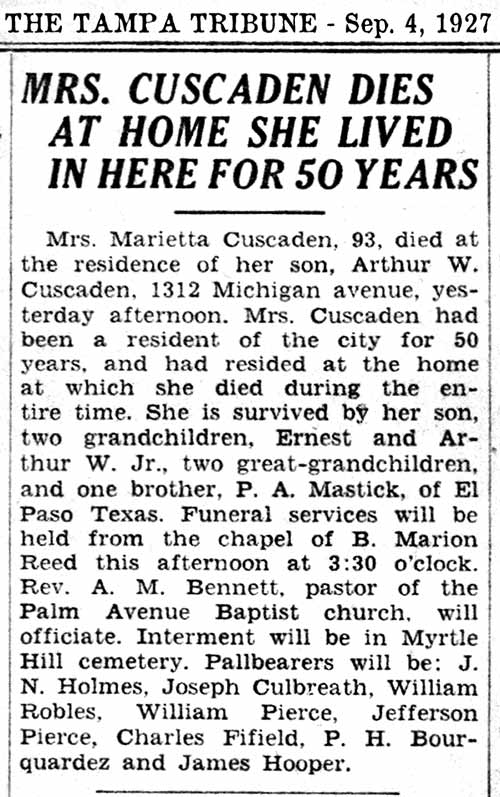
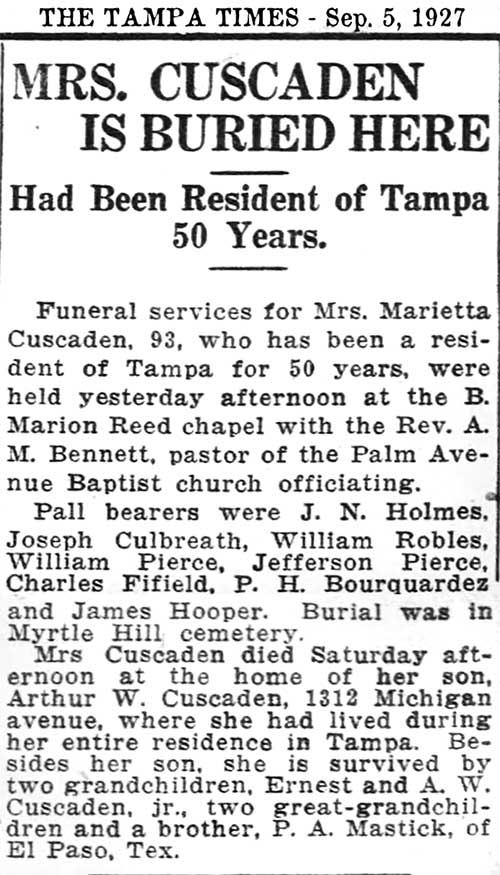
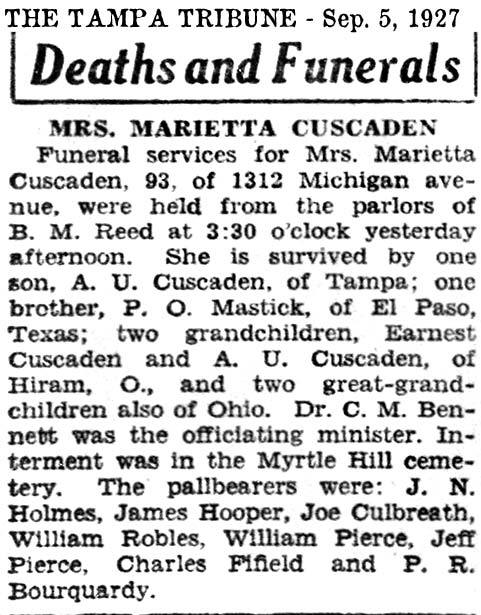
More
about Arthur Cuscaden and Cuscaden Park and Pool
|
 HILLSBOROUGH
COUNTY HIGH SCHOOL'S SECOND HOME HILLSBOROUGH
COUNTY HIGH SCHOOL'S SECOND HOME |
|

In 1885, the School Board sold the school property
on the 500 block
of Franklin St.
to Sparkman and Sparkman (which in 1911
was known as Sparkman block),
and
purchased an entire block on Jefferson Street, between Henderson
Street
and Estelle Street. (Ybor's 6th
Ave. was called Henderson St. north of downtown).
Under
the guidance of Superintendent Wesley P. Henderson, a new 8-room
schoolhouse was built on this property on Jefferson St. at a cost
of $4,735 for the purpose of teaching elementary and high school
classes.
Superintendent Wesley P. Henderson was given much of the credit for
organizing the scattered programs and limited resources
throughout the large county into a unified system, Hillsborough
County Public Schools. Some of the most significant early
advances occurred during his tenure as superintendent. For
example, it was under his leadership that the first "modem"
building was constructed with the intent of providing an
"organized high school curriculum" to all children in the
county.

At the beginning of the term in 1886, the High School and Tampa
School No. 1 moved into
this
new home
where it remained for six years.
B. C. Graham taught the eighth grade
and the high school together in the same room. A little later the
high school department was moved to a room on the west end of the
building, but was not yet separated from the grade school.
|
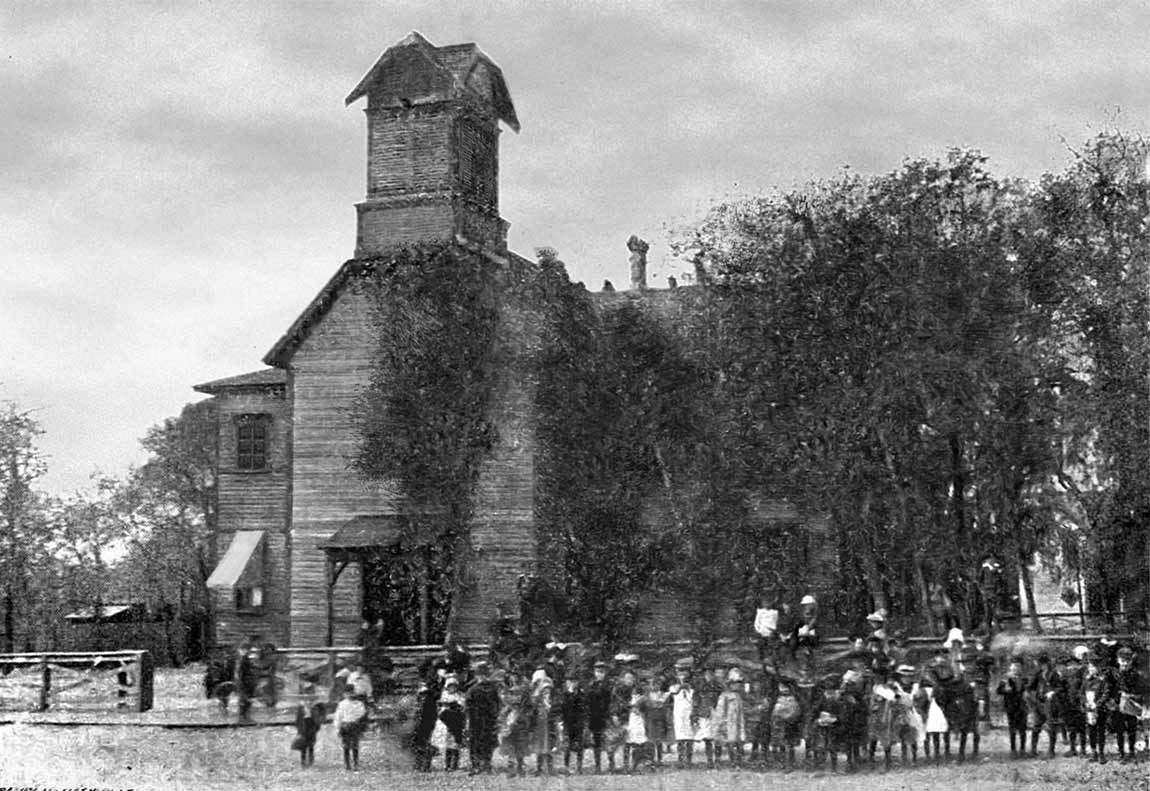 |
|
This 1898 photo
shows Hillsborough County High School's (1886-1892) second home--at 6th Avenue
& Jefferson St.
The photo was taken about 6 years after the high school had moved
out and the building became the location
of only the public county primary or ("grade") school.
Thanks to Rex
Gordon, HHS historian, for locating and sharing the photo of
Hillsborough County High School's
second home..
Photo from
Biennial Report, Superintendant of Public Instruction, State of
Florida, published in 1899.
|
|
 |
From E. L. Robinson's History of Hillsborough County:
In
1886, on the recommendation of Wesley P. Henderson, who resigned
his position as county superintendent to take up other work, and
from the many candidates for the position, the governor appointed
as Henderson's successor Mr. Ludwig W. Buchholz who was then
teacher of the school in Bloomingdale. Mr. Buchholz bad been
trained in one of the teacher training schools of Germany, had
taught there for a few years and then, because of impaired health
had come to sunny Florida to seek renewed health. His enthusiasm
for education and his skill as a teacher had been well exemplified
in the rural school at Bloomingdale and as a result he was called
to this greater work. He continued as county superintendent until
1901 when be became professor of philosophy and
pedagogy at the
Florida State College in Tallahassee.
|
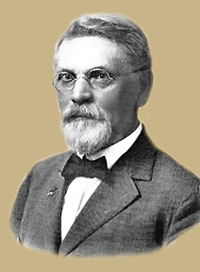
Ludwig Wilhelm Buchholz
Photo from E. L. Robinson's
"History
of Hillsborough County." |
|

|
In January 1887,
Mr. Wesley
P.
Henderson
resigned as County
Superintendent
and, in his place, Mr. L. W.
Buchholz was appointed by Governor Perry.
Read
about Wesley P. Henderson here on this page about the
Henderson family.
|
A
GRAND JURY REVIEWS, ASSESSES, AND REPORTS ON THE COUNTY SCHOOL
SYSTEM - Nov. 3, 1886
In these times,
a Grand Jury not only reviewed criminal activity, it also looked
into the general condition of various aspects of the county and
reported on it to the county judge. Here, Henry C. Ferris, a prominent
businessman in the community, reported the Jury's findings of
the Fall Term of the Court, 1886. This article has been
edited to show only the portion pertaining to the school
matters.
Overall, the
Jury gave a favorable report of the school system and the County
School Board, in particular for building "the large and
commodious house at this place, and in the establishment of a
High Graded School here...in successful operation...and a total
attendance of something like 200 pupils."
There was a minimum amount of residents necessary in an area
before a school could be established there. Because there
was already $1,791 in the School Fund, with $1,300 more funding
coming in the year, the Grand Jury felt that the County was well
financed so recommended that the minimum amount of
residents needed in an area be reduced so that more schools
could be established in those sparsely populated areas.
Read
this Nov. 3, 1886 article.
Superintendent Buchholz toured the schools
in late April 1887 and gave "forcible and
enthusiastic" praise for the management of the
school system.
Read this Apr. 28, 1887 article.
The new school became one of the
advantages of buying property in Highland Park in the developing
Tampa Heights suburb.
See
a Mar. 10, 1887 ad which mentions the construction of a board
walk to Highland Park.

See
the Aug. 25, 1887 real estate ad for Highland Park that the
above comes from.
|
| |
|
|
|
 HILLSBOROUGH
COUNTY HIGH SCHOOL'S THIRD HOME HILLSBOROUGH
COUNTY HIGH SCHOOL'S THIRD HOME
 In
1892, the high school
department
moved into a new building
erected by the City of Tampa
and had two regular teachers.
This building is situated just south of the old building
on Jefferson
and Henderson Streets (6th Ave.) During its four
years in this building the library had accumulated a nice
collection and such chemical apparatus as needed for experiments
in chemistry.
In 1894, upon the recommendation of Superintendent Buchholz, the
High School was made a separate and distinct institution
and was permanently separated from the grade school.
It was at this time that B.C. Graham became the high school
principal with duties confined to the High School. This
change was a great improvement over the previous arrangement. In
1896, the building, now called the Tampa Heights Primary School
building, was enlarged and arranged for a primary school. In
1892, the high school
department
moved into a new building
erected by the City of Tampa
and had two regular teachers.
This building is situated just south of the old building
on Jefferson
and Henderson Streets (6th Ave.) During its four
years in this building the library had accumulated a nice
collection and such chemical apparatus as needed for experiments
in chemistry.
In 1894, upon the recommendation of Superintendent Buchholz, the
High School was made a separate and distinct institution
and was permanently separated from the grade school.
It was at this time that B.C. Graham became the high school
principal with duties confined to the High School. This
change was a great improvement over the previous arrangement. In
1896, the building, now called the Tampa Heights Primary School
building, was enlarged and arranged for a primary school.
This 1903 Sanborn Fire Insurance map
below shows (2) the previous 1886 location of the high
school now marked in 1903 as
"PUBLIC
SCHOOL." The
wood structure (3) below it (south) was the newer
building occupied by Hillsborough County high
school from 1892 to 1896. In 1896 the high school
moved out and that building was enlarged (eventually
becoming the Tampa Heights Primary School referenced by
Doris Hill in 1911.) By the time of this 1903
Sanborn map, the high school had moved on to its
4th and 5th locations, and this location became the
grammar school as seen here.
|
|
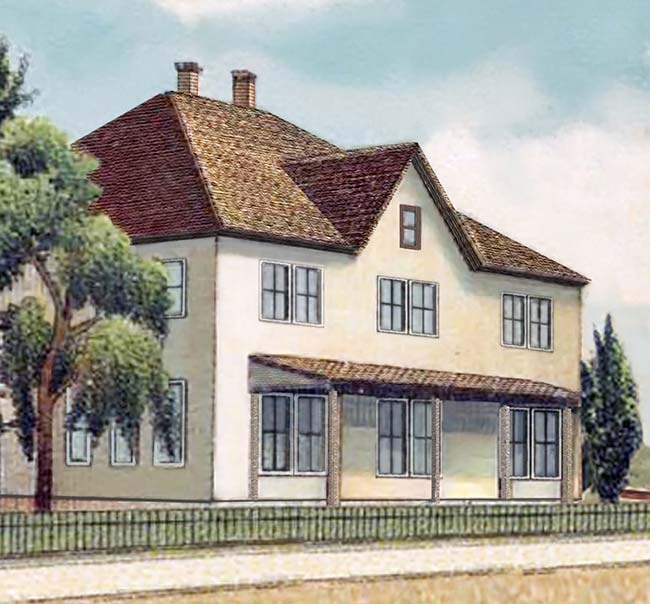
The above image of the building
is a cropped area of a postcard depicting the school circa 1905 after
it had already been enlarged and became the primary school.
The enlargement probably didn't affect the appearance of
the front portion seen here.
Enhanced & cropped by TampaPix, the postcard image courtesy
of
Hometown Currency Virtual Museum - Florida Alligator
Border Postcards
|
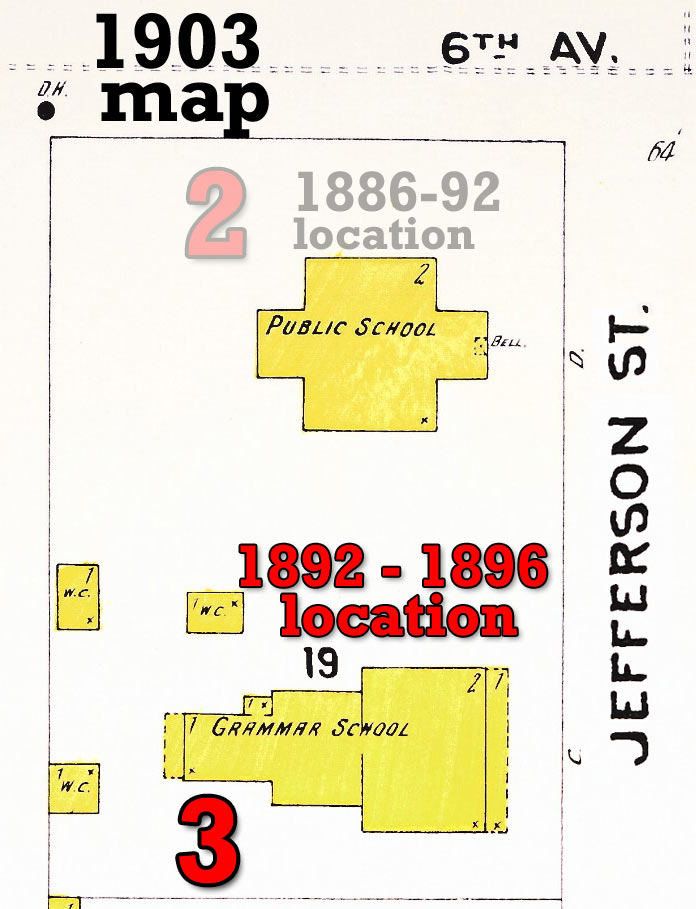
It appears that the 1896 enlargement of the former
3rd high school location was the 1-story portion of the
structure comprising the west (left) portion of the
building. "W.C." stood for "water closet"-- outhouses.
|
|
(You probably noticed that there is no front door.
Some post cards of this time period were created from
photographs enhanced by an artist, especially in areas
that were too dark to show detail. It's possible
the artist just didn't have a door in mind when he/she
enhanced this photo.) |
|
B. C.
GRAHAM, HILLSBOROUGH COUNTY HIGH SCHOOL'S 3RD PRINCIPAL
|
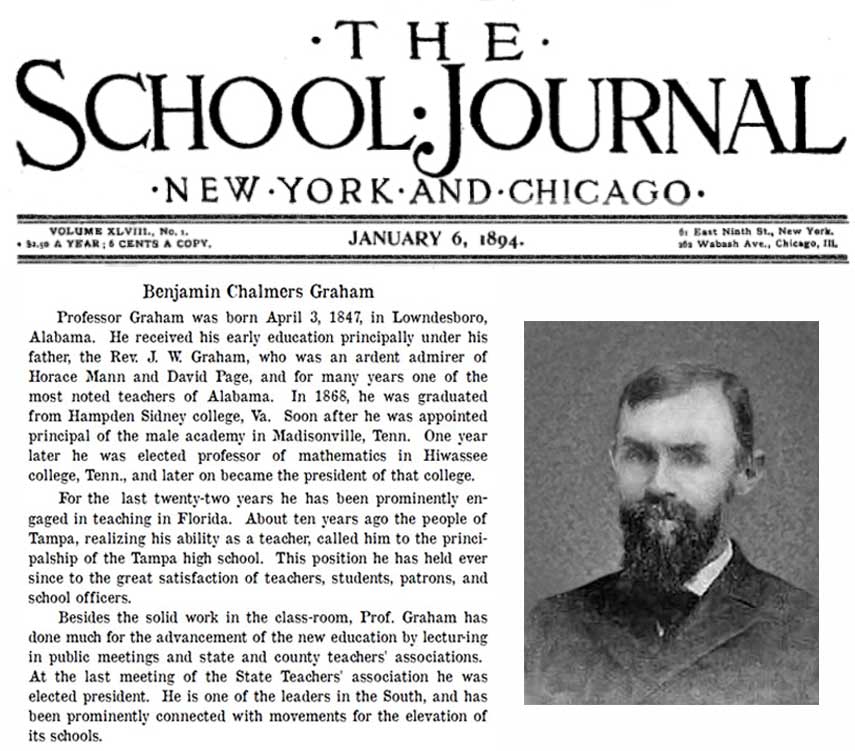
*He became
principal of HCHS in 1894. the year of this publication,
not "about ten years ago" (~1884).
|
Professor
Graham was born April 3, 1847, in Lowndesboro, Alabama.
He received his early education principally under his
father, the Rev. J. W. Graham, who was an ardent admirer
of Horace Mann and David Page, and for many years one of
the most noted teachers of Alabama. In 1868, he was
graduated from Hampden Sidney college, Va. Soon after
[1869?]
he
was appointed principal of the male academy in
Madisonville, Tenn. One year later
[1870?]
he was elected
professor of mathematics in Hiwassee college, Tenn., and
later on [1871?]
became the president of that college.
For the last twenty-two
years [since 1872?]
he has been prominently engaged in teaching in
Florida. About ten years ago
[1884? No, see footnote] the people of Tampa,
realizing his ability as a teacher, called him to the principalship of the Tampa high school.* This position he
has held ever since to the great satisfaction of
teachers, students, patrons, and school officers.
Besides the solid work in the class-room, Prof. Graham
has done much for the advancement of the new education
by lecturing in public meetings and state and county
teachers' associations. At the last meeting of the State
Teachers' association he was elected president. He is
one of the leaders in the South, and has been
prominently connected with movements for the elevation
of its schools.
|
|
|
B. C. Graham was the
3rd of eleven children of Rev. J. Whitfield Graham and Sarah
Catherine Smith. Benjamin's wife, Sally Gates, was a
granddaughter of Josiah Gates, the first white settler in the
Manatee Settlement (Bradenton), Florida. B.C. was a brother of noted
Tampa judge
William Shelby Graham.
B. C. GRAHAM TIMELINE
Concluded from Doris Hill's history as the primary credible
source of this time in Tampa, combined with the above publication
with approximate dates calculated from the text.
|
1847 |
Born in Lowndesboro, Ala. |
Benjamin Chalmers
Graham
Detail from photo below Circa 1900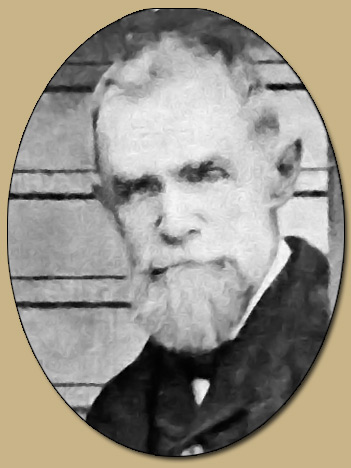 |
|
1868 |
Graduated from Hampden Sidney |
|
1869 |
"Soon after" principal of the male
academy in Madisonville, Tenn. |
|
1870 |
"A year later" professor of Math at
Hiwassee, TN |
|
1871 |
"...and later on" president of that college. |
|
1872 |
"prominently engaged in teaching in
Florida" |
|
1886 |
Teaching the High School & 8th grade in
the same room, in the new building at location #2, the
same building as the grade school. In the latter years of this
teaching period the high school dept.
was physically moved to its own room on the west end of the
building, but still in the same building as the grade
school. |
|
1892 |
Teaching the high school department in
new building at location #3 with two regular teachers. |
|
1894 |
Becomes High School Principal while still
teaching at location #3, when Supt. Buchholz makes the
high school a "separate and distinct institution"--a
change in organization, but no physical location change. |
|
THE FAMILY OF B. C. GRAHAM'S WIFE, SALLY GATES GRAHAM
The Gates
family reunion, circa 1900 photo below was provided by Louis Edwin
Gates, Jr., son of Louis Edwin Gates and Mary Virginia Hefner,
to Sally E. Tait Quinn, granddaughter of Louis Edwin Gates and Mary V.
Hefner Gates, who then provided it for use here.
A world of thanks
to all the Gates family members who made this image possible
here.
Place your
cursor on the photo to identify family members
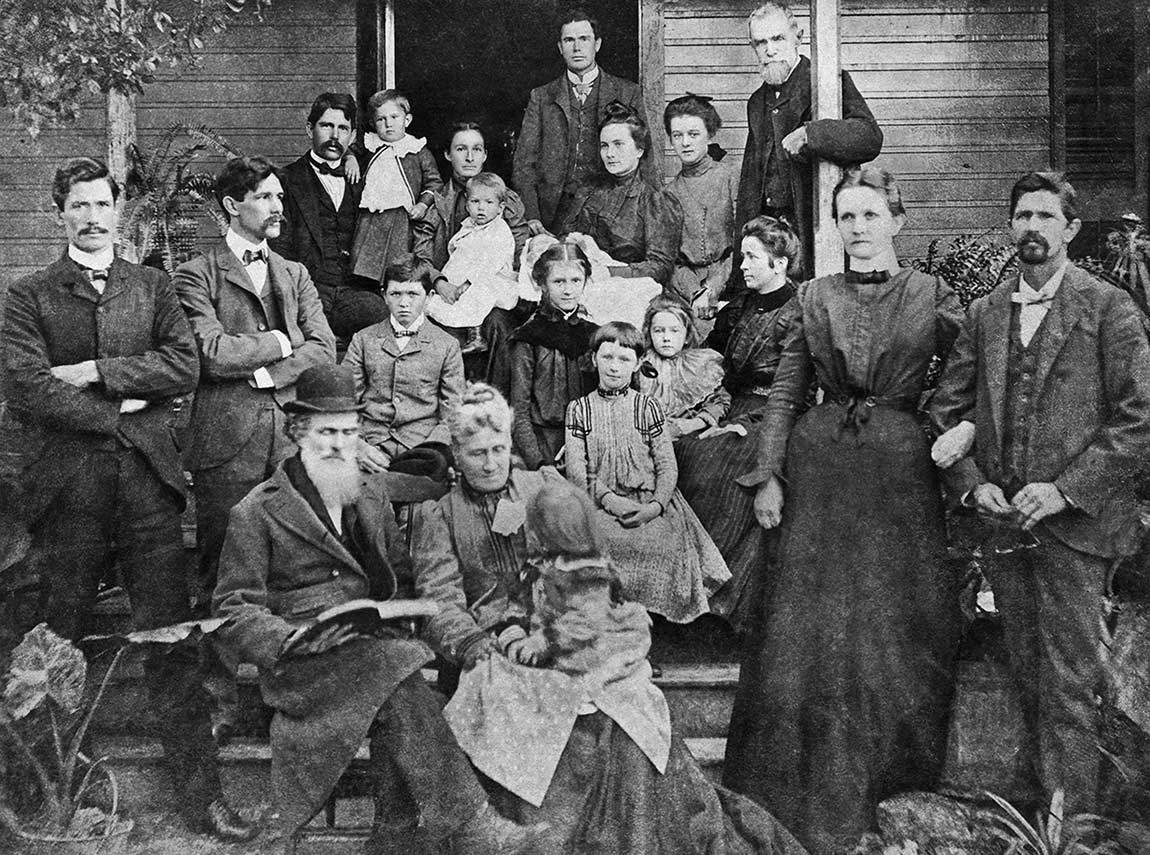
Picture taken in front of Rev. Edward Franklin Gates' home in
Manatee, circa 1900, now East Bradenton, Florida.
Terms of
relationship in quotes ("Grandma," "Uncle," etc.) are what Louis Edwin Gates
called them; he provided the photo and names, and was grandson
of #1 and 2.
Children of Rev. E. F. Gates & Euphemia Hubbard Gates are in
red.
1.
Rev. Edward Franklin Gates "Grandpa" (son of Josiah Gates, first
settler in the Manatee/Bradenton settlement).
2.
Euphemia (Feemie) Hubbard Gates "Grandma".
3.
Samuel Chaires Gates "Uncle Sammy", son of 1 and
2.
4.
Lula Curry Gates "Aunt Lula", first wife of 3.
5.
Roy Gates, son of 3 and 4
6.
Sally Gates Graham, "Aunt Sally", daughter of 1 and 2, wife of 7.
7.
Benjamin C. Graham, "Uncle Ben".
8.
Katy Graham (later Dickens), daughter of 6 and 7.
9.
Bertha Graham (later Anderson), daughter of 6 and 7.
10.
Robin Graham (later Sutton), daughter of 6 and 7.
11.
Gladys Graham, never married, daughter of 6 and 7.
12.
Annie Laurie Graham, (later Allgood), daughter of 6 and
7.
13.
Rev. Edward Josiah Gates, "Uncle Eddie", son of 1 and
2.
14.
Esther Rebecca Wartmann, first wife of 13.
15. Dr. Hubbard Gates, my papa, son of 1 and 2.
16.
Lilla Corbett Gates, my mama, first wife of 15.
17.
Olin Edward Gates, my oldest brother, son of 15 and 16.
18.
Ralph V. Gates, my second oldest brother, son of 15 and
16.
19.
Laurie Gates, "Uncle Laurie" (later marr.
Pearl) son of 1 and 2.
20.
Josiah Olin Gates (later married
Bertha
Alice Stetler), Son of 1 and 2.
21.
Chester Gates (infant obscured, on lap of 14), baby of 13 and 14.
I (Louis Edwin Gates) was born in 1902 and my youngest brother,
Kyle was born ~1905.
The information
above is the result of slight modifications (on Oct. 16, 2009)
by Louis E. Gates, Jr. from what his father originally provided.
The photo
was provided by Louis Edwin Gates, Jr., son of Louis Edwin Gates
and Mary Virginia Hefner, to Sally E. Tait Quinn, granddaughter of Louis Edwin Gates and Mary V.
Hefner Gates, who then provided it for use here.
A world of thanks
to all the Gates family members who made this image possible
here.
B. C. Graham family from Genealogical Record of
the Descendants of Col. Alexander McAllister, of Cumberland
County, N. C ... by David Smith McAllister
|

HILLSBOROUGH COUNTY HIGH SCHOOL'S FOURTH HOME
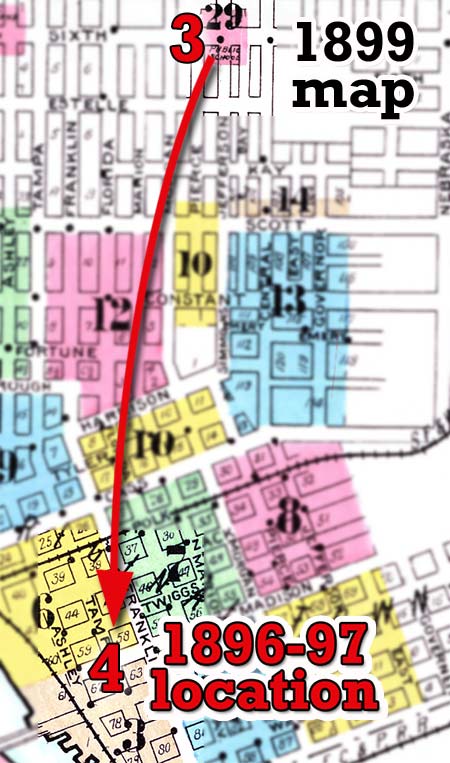 
Owing to the disastrous freeze of 1895, the plan of Supt. Buchholz
to erect a brick building for the High School had to be postponed.
Accordingly, the school was taught for one year in the old Baptist
Church on the corner of Twiggs and Tampa Streets.
By relocating the high school in the old Baptist church,
students found themselves back in nearly the center of
Tampa’s business community.
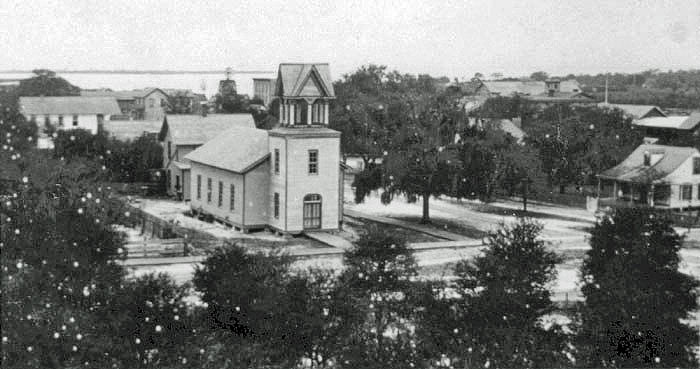
Photo from"Exploring Florida"
Courtesy of the Special Collections Department,
University of South Florida.
Digitization provided by the USF Libraries Digitization
Center.
THE RED
ARROW ON THE MAP BELOW INDICATES THE DIRECTION FROM
WHICH THE ABOVE PHOTO WAS TAKEN.
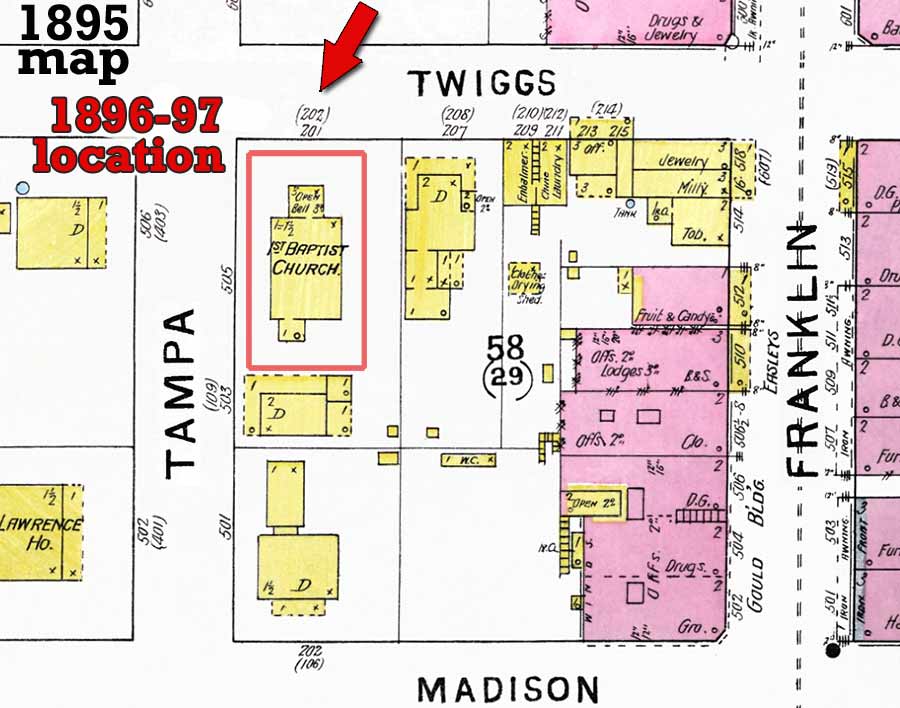
The
1903 map below shows the same location but in 1903. The brick
building Tampa Steam laundry on the corner has replaced the old
Baptist church. The green arrow indicates the direction from
which the next photo of the laundry was taken.
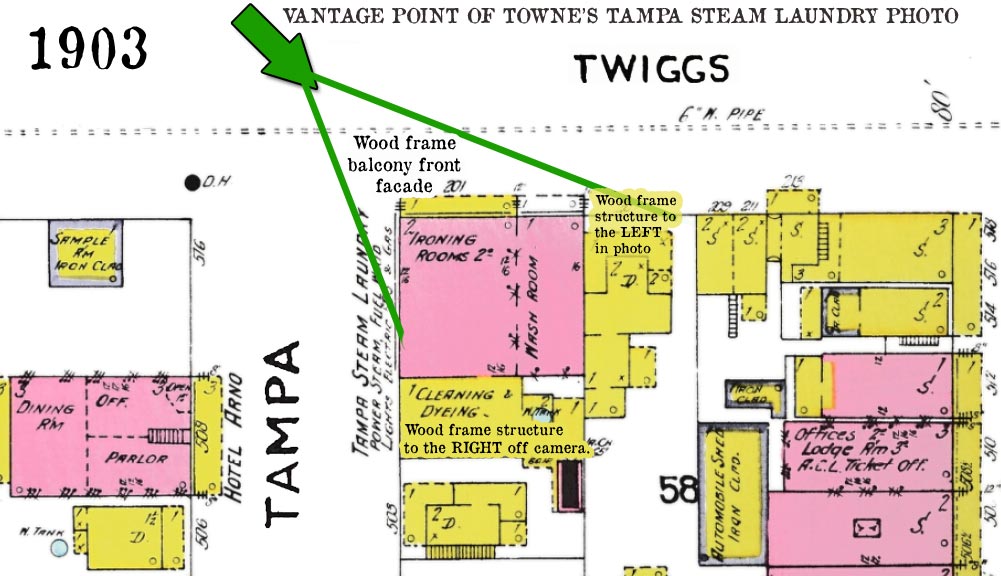
Towne's Tampa Steam Laundry as seen from the
intersection of Tampa St (on the right) and Twiggs (in
front of the building, to the left.)
Take a good look at the decorative miniature arches trim
on the front facade just above the 2nd floor porch roof.
Photo from "Tampa
Illustrated" at Internet Archive, compiled
and published by C. E. Bissell and Roy Dougherty in
1903.
Photo by Fred Barker.
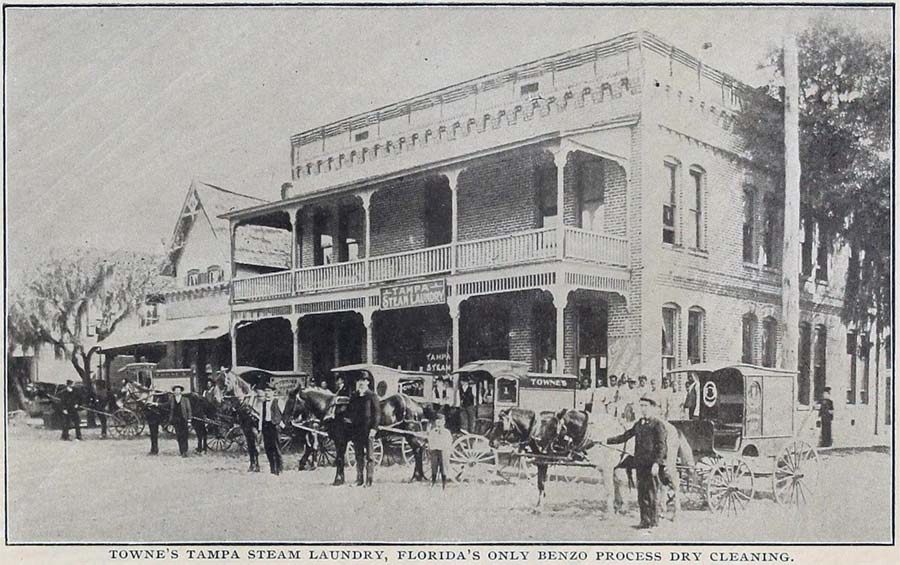
Today, this building still occupies this corner, but
with countless remodeling and renovation.
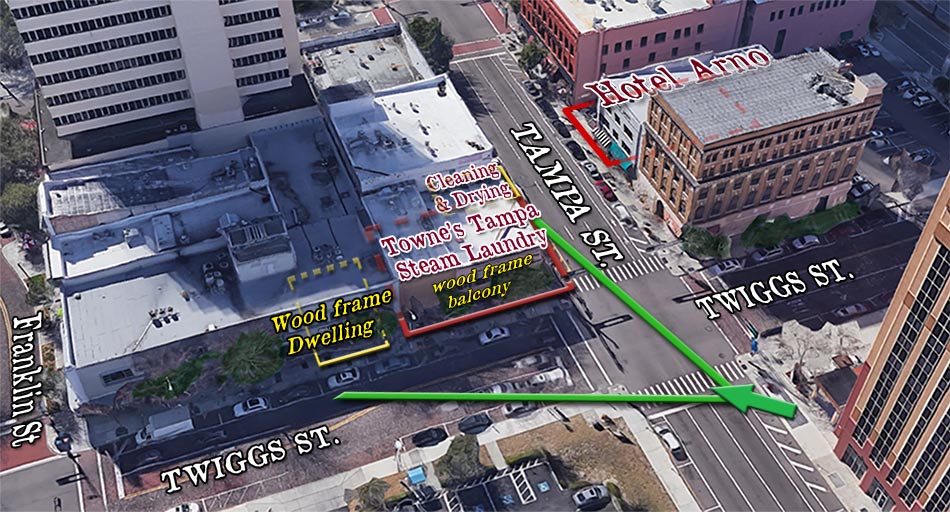
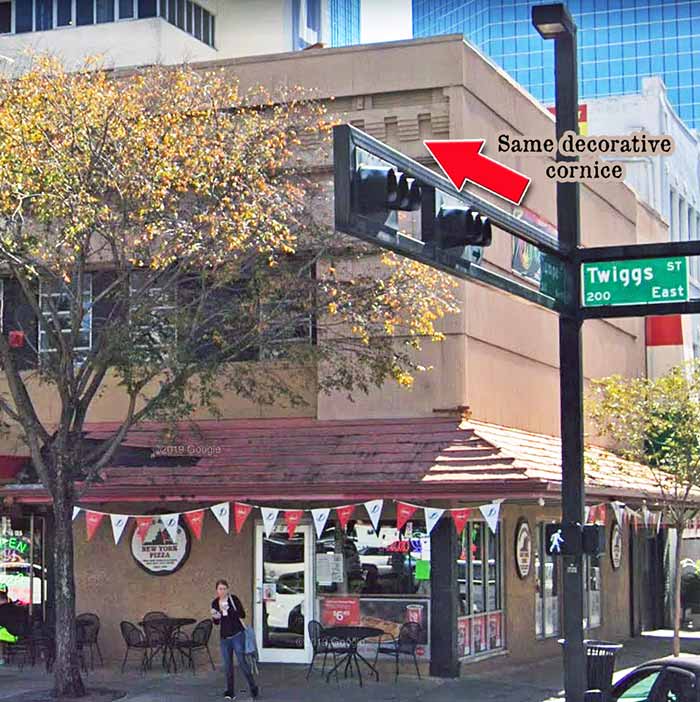
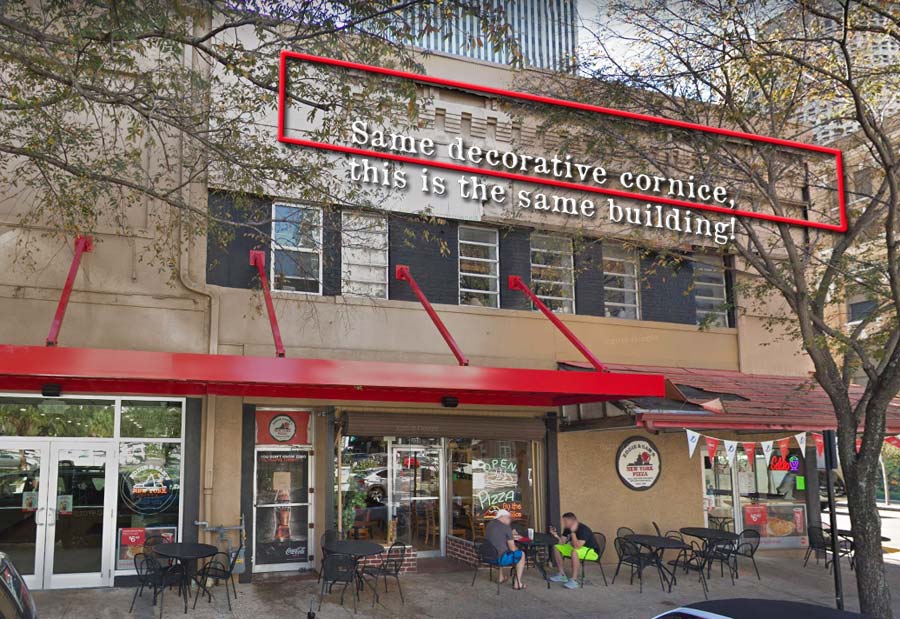
Underneath all this paint,
plaster, stucco and facing is that same old brick
building from circa 1899!
|
 HILLSBOROUGH
COUNTY HIGH SCHOOL'S FIFTH HOME HILLSBOROUGH
COUNTY HIGH SCHOOL'S FIFTH HOME
THE WRIGHT BUILDING

From 1897 to 1900,
the High School was over the Post-Office, located in the Wright
Block on the corner of Madison Street and Florida Avenue.
Both
the School Board and the students wanted a building they could call their
own, but instead what they got was a lease. The students were happy to learn that it was a short term lease, because the
property which they had obtained consisted of four rooms on the upper
floor of a the Wright building, a brick building on the northwest corner of Madison St. and
Florida Avenue, the remainder of which was occupied by The
Tampa Daily Times printing office and a post office on the first floor.
The school
remained in this location from 1897 to the end of the school year 1900. During the first year the high
school occupied three rooms, but in the second year, four were needed.
This showed an increase in enrollment and led to the addition of two new
teachers and additional course requirements.
It was in this atmosphere
that the school newspaper, then called The Donnybrook Fair, was established
and published, possibly because of their sharing the Times' printing
office. |
|
THE MOVE FROM THE OLD BAPTIST
CHURCH TO THE WRIGHT BUILDING
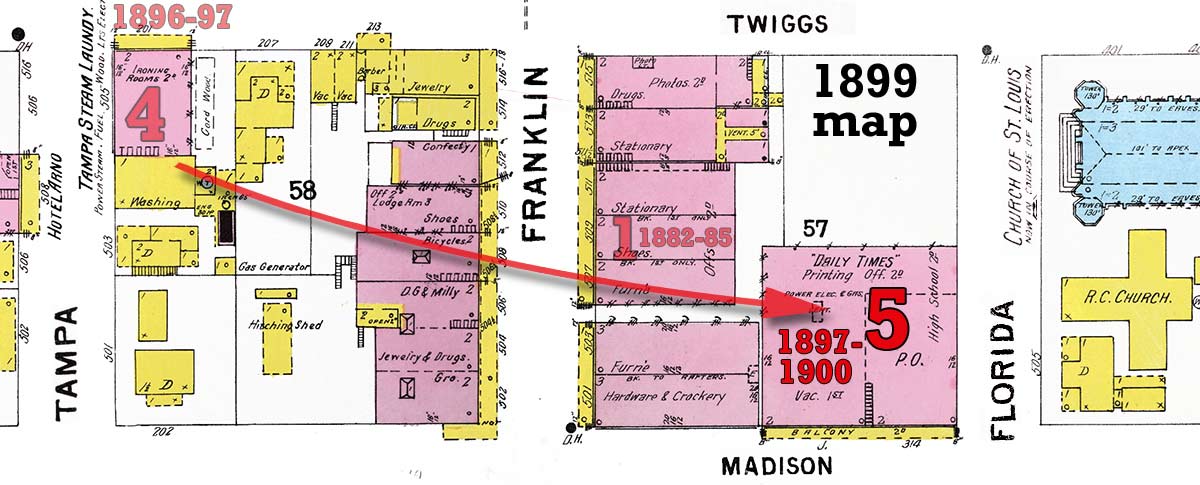
The
1899 map above shows the school location at the northwest corner
of Florida Avenue and Madison St. The post office occupied the
first floor, with some vacant space behind it. The high school
was on the 2nd floor, along with the Daily Times printing office. Across Florida Avenue is shown "R.C.
Church" (Roman Catholic) and in blue, the "Church of St. Louis"
currently under construction. This was soon renamed the Sacred Heart
church.
|
During the time the
school was in this location, the U.S. became involved in
the Spanish American War in 1898. It was on April 12, 1898 that founder
of the American Red Cross Clara Barton stayed a night at the Arno
Hotel on Tampa St. after having left Cuba due to the explosion on
the USS Maine battleship and the ensuing declaration of war by the
U.S. on Spain. She had her luggage fumigated at the Tampa
Steam laundry, which on this map has replaced the old Baptist
church where the high school was previously located.
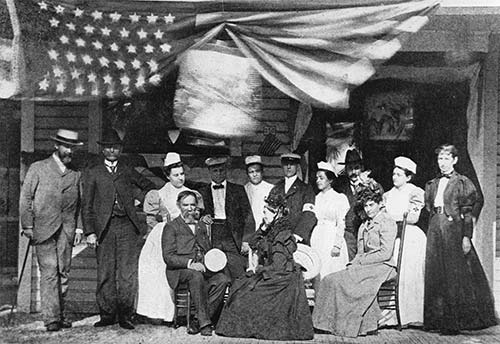 |
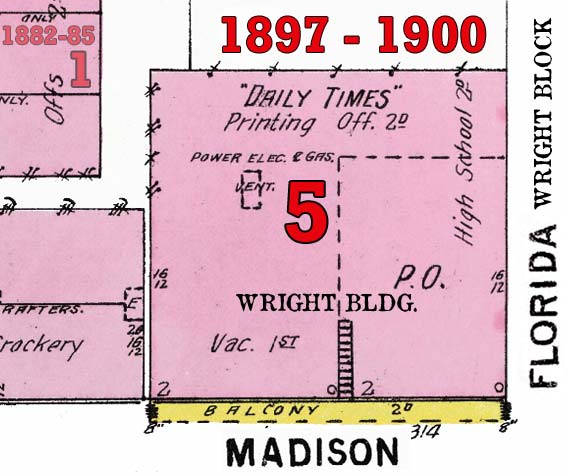 |
| Clara
Barton and her American Red Cross entourage on the porch
of J. Mack Towne's home in Hyde Park. Towne was
the owner of Tampa Steam Laundry. |
Read more about Clara's visit to Tampa. |
READ ABOUT THE HISTORY OF THE
WRIGHT BLDG. AFTER HCHS MOVED OUT, AND THE HILLSBORO HOTEL, HERE
AT TAMPAPIX
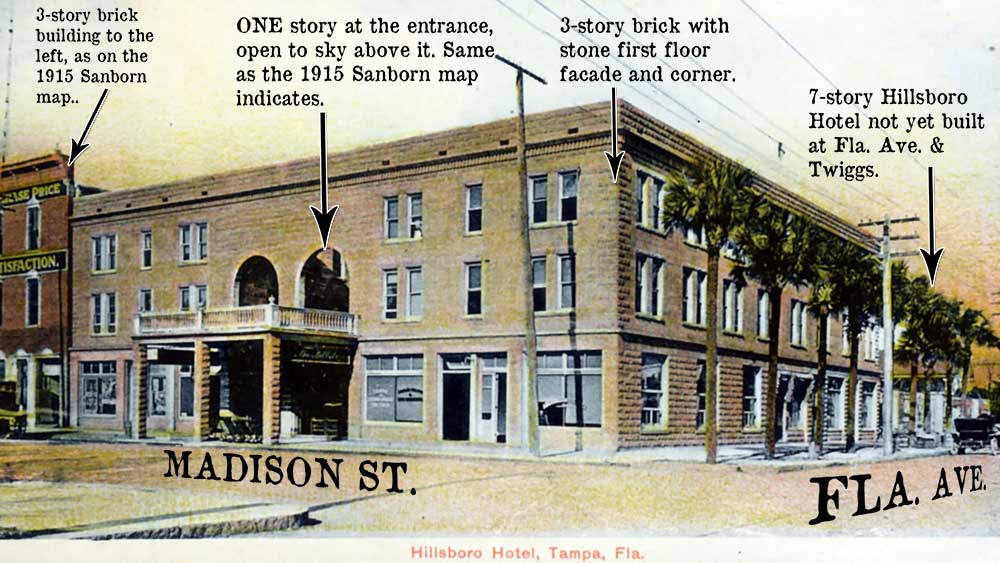
|
|
THE ORIGIN OF THE IT STARTED IN A LIVERY STABLE MYTH-CONCEPTION
The map below shows the
block of the school's 5th location just before
(1895) the
high school was located there. The Wright
Building site of the high school was the only former livery
stable location and was made of brick as
stated by E. L. Robinson. The diagonal lines indicate
this was a stable. As seen on this 1895 map, it was
once the home of Tampa Livery Sale & Transfer Co., a
2-story brick building on the northwest corner of Florida
Ave. and Madison.
|
The
Livery Stable, 1895
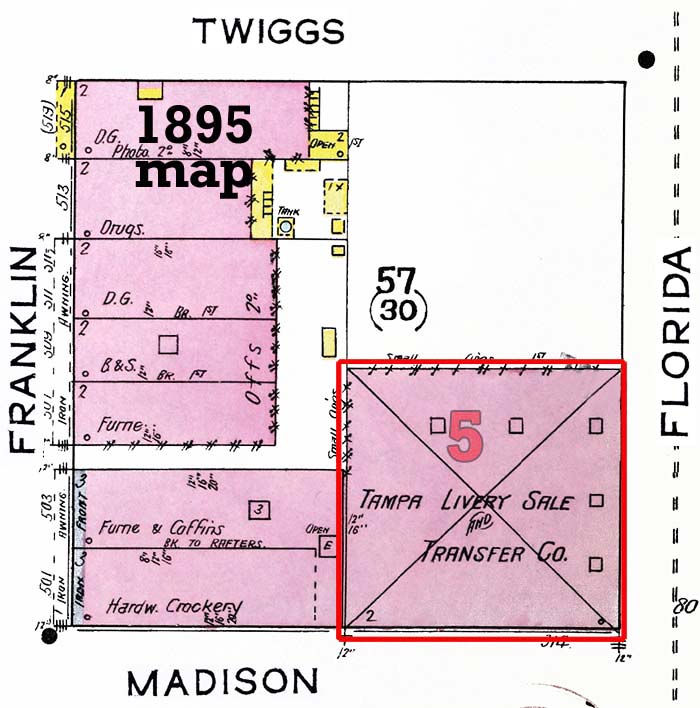 |
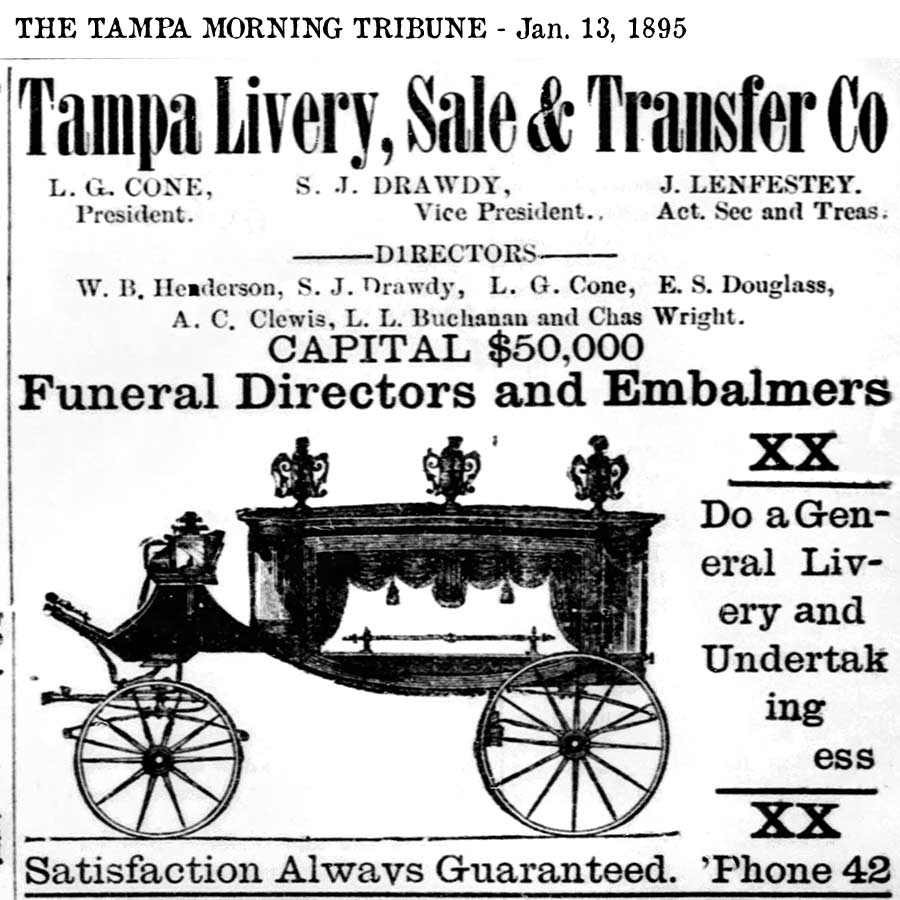 |
|
|
|
|
 HILLSBOROUGH
COUNTY HIGH SCHOOL'S
SIXTH HOME HILLSBOROUGH
COUNTY HIGH SCHOOL'S
SIXTH HOME

A
new school building was needed but there was no legal way of raising money for
building purposes, except to save it from the general school fund.
The year
1900 started off with Supt. Buchholz returning from the
annual convention of Florida teachers with the honor of
being elected President of the organization and plans to
bring the members to Tampa next year. He proposed
to make every effort to build new schools in the county
to "crown the last year of this century..." But
he was in favor of building grade schools for
children first, not a high school. He estimated
150 to 200 high school students that year, but "an army
of 1,500 children in lower grades" who are getting along
with scattered, overcrowded structures, "and this army
is constantly increasing." City council had
already started conferring with county authorities to
begin moving on a large and suitable building.
|
|
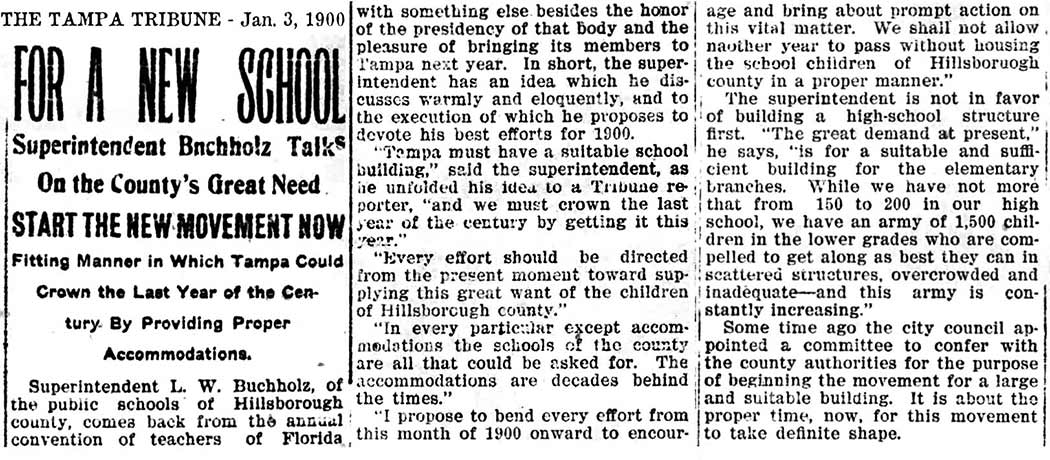 |
|
A tribune reader wrote as "Patron" with a
view that Tampa needs FOUR school buildings, one in each
district of Hyde Park, Tampa Heights, Ybor City, and
near the present Washington School. One could
house the high school until a site could be chosen and a
schoolhouse built. |
Fifteen seniors were named as the
graduating class from the high school while located in
the Wright Building above the Post Office. This
would be the final graduation of students attending
this building. |
|
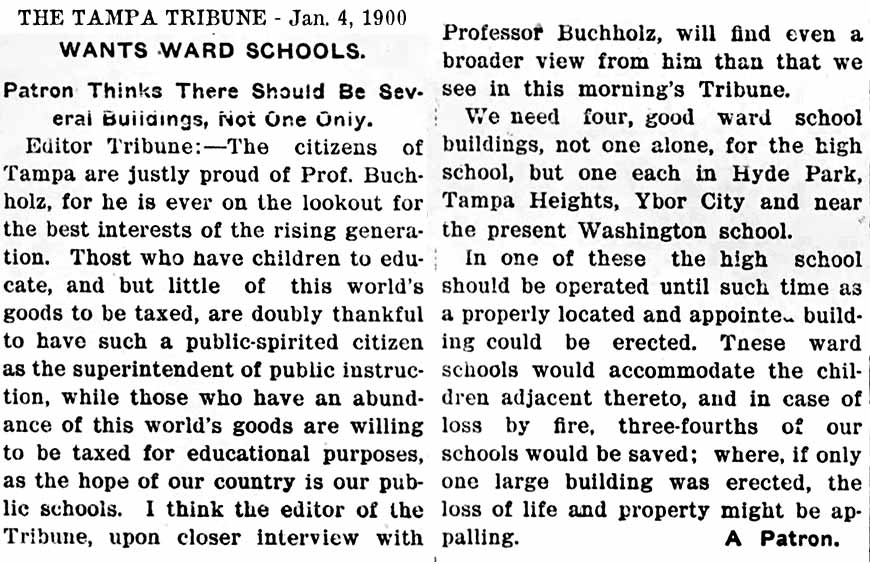 |
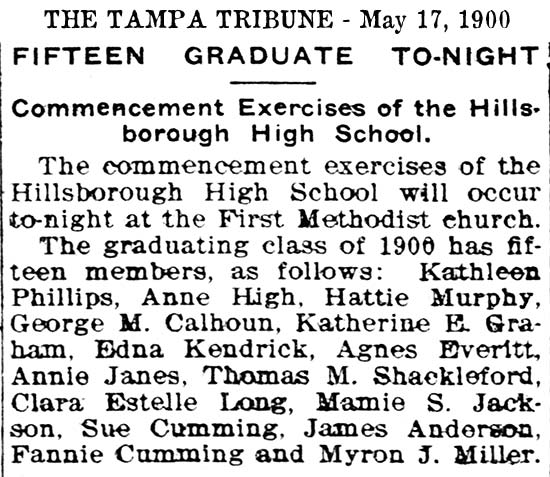
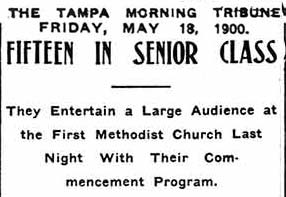 |
| |
Read
the entire article |
|
|
|
|
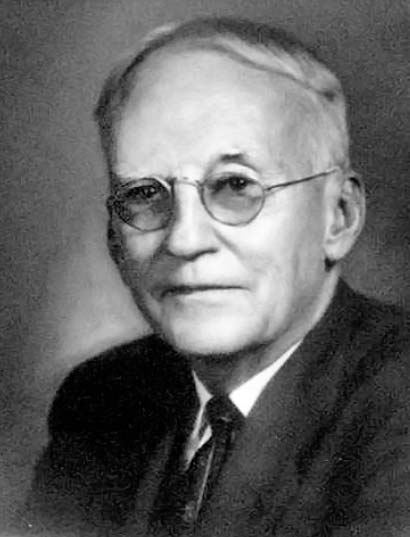
Thomas M. Shackleford, Jr.
A founder of the Shackleford Farrior law firm in Tampa
Photo from the publication featured at left. |
|
On May 20, 1900, this short article
appeared in the Tribune announcing that Mrs. T.M.
Shackleford would be entertaining the graduates at her
home in honor of her son.
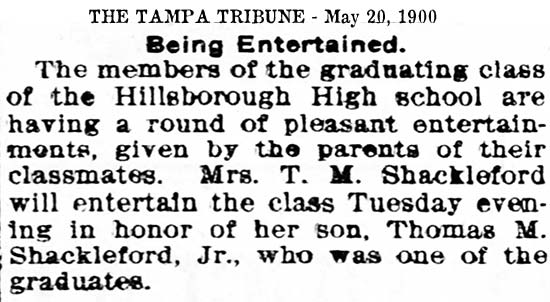
Thomas
Mitchell Shackleford, Jr.
Select excerpts below from:
T.M. Shackleford, Jr: A lifetime of quiet achievement
(1884-1973),
by Judge Morison Buck, Jan. 1,
2000.
|
|
From USF Scholar Commons Digital Collection of Morison
Buck's biographies
The only child of Thomas M. and Nannie Rhea Shackleford,
Thomas Mitchell Shackleford, Jr. was born in 1884 in the
rustic setting of tiny Brooksville.
The senior
Shackleford (usually referred to as T. M.) was a
native of Fayetteville in south-central Tennessee, just
a few miles south of Lynchburg.
After T.M.
Sr.'s marriage to Nannie Rhea, he did what many
from the Volunteer State did before and after him; he
moved to Florida, settling initially in Lake Weir.
About 1883, T. M. and his
retinue moved west to Brooksville and remained there
for about a decade. T.M. Jr’s mother died when he was
three years of age and the following year his father
married Lena A. (Jane) Wooten of Russelville, Kentucky,
with whom he would have three children. One of these was
R. W. (Bob) Shackleford who also became a trial lawyer
in Tampa, first with his father, and later with J. Rex
Farrior and others.
1884 was a
banner year for the Shacklefords... after relocating in
Tampa, T. M. [Sr.] quickly became prominent in Tampa,
both professionally and politically. He forged a
partnership with Hugh C. Macfarlane, a native Scot who
began the practice in Tampa the year of T. M. Jr’s
birth, and who was already a force in the legal and
business community of Tampa. T. M. [Sr.] served for two
years as City Attorney in Tampa before realizing his
long-time ambition to gain a seat on the Florida Supreme
Court. In 1902 he was appointed by his good friend and
fellow Democrat, Governor William Jennings, and served
with distinction and acclaim for several terms between
1902 and 1915, some of which as designated Chief
Justice.
|
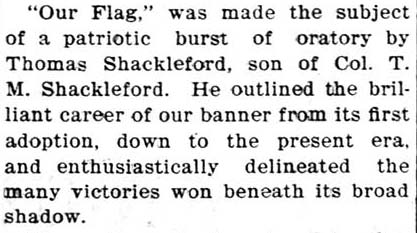 |
|
T. M.
Shackleford Jr.'s participation in the May
17, 1900 High School commencement ceremony.
|
There was
a lot going on in the Shackleford family as the 19th
century was winding down. Number one son, T. M. Jr.
was prepping for high school, and graduated from
Tampa's Hillsborough High School in the first year
of the 20th century. [1900 was the last year of the 19th
century].
Interviewed
in 1959 by a reporter from The Tampa Times, [T.M. Jr.]
he reminisced:
“When [I] graduated from Hillsborough High, there were
11 girls and 5 boys in the graduating class. We had sand
streets and wooden sidewalks then, and Tibbett’s Corner
at Franklin and Lafayette (Kennedy) streets was the
gathering place for couples after a dance. Cocktail
lounges were unknown, and an ice cream soda was a real
treat. Tampa had perhaps 15,000 people then.”
The primary thrust of the
Times story was that the 4th of July in 1900 was not
recognized with the hoopla and festiveness common today.
T. M. Jr. ventured that the Fourth was viewed somewhat
suspiciously as a Yankee holiday, a remnant of the
feelings engendered in the aftermath of the Civil War.
After high school, it was
time to get intellectually prepared for a career in law,
following the example set by his father, so T.M. Jr.
attended the following secondary schools: John B.
Stetson University, 1901-02; University of Florida, 1905
BA degree; University of Virginia, 1907 LLB degree. Phi
Beta Kappa and Blue Key. The University of Florida,
incidentally, bestowed an honorary LLD degree upon his
father, Justice Shackleford, in 1910. After receiving
his law degree from UVA, it was back to Tampa for the
23 year old new lawyer. Tampa was growing apace
during the first quarter of the last century. So,
indeed, was Shackleford’s reputation for intellect,
diligence and professionalism.
In 1910 he became the junior partner
in Caraballo & Shackleford, located in the old American
National Bank Bldg (the bank failed during the Great
Depression). Martin Caraballo and later his son were
respected names in Tampa's legal community. In 1912,
while living at the YMCA, Shackleford had an office in
Exchange National Bank Building. The following year he
took space with C. C. Whitaker in Citizens Building. The
year 1915 saw his appointment as Referee in Bankruptcy,
a judicial responsibility which gives him eligibility
for this biographical series. He and his brother, R.W.
(Bob) Shackleford, a splendid trial lawyer, and his
father (who had just concluded his noteworthy tenure on
the Supreme Court of Florida) teamed up for a time in
the location last mentioned.
One of the longest of his early
associations was with Marcus F. Brown (Shackleford &
Brown) with some noted associates including: Morris E.
White, J. Rex Farrior and George T. (Pat) Shannon, in
what was the embryo of the fabled [Shackleford Farrior]
firm which for many years featured T. M. Jr. as its
head. His dearest friend was Fred Thompson, after whom
his second son was named, but he was also close to L. L.
Parks, with whom he practiced as Shackleford & Parks
commencing in 1919 and lasting until Parks appointment
to Circuit Court in 1923. About 31 years later, Bar
President O.D. Howell, Jr. appointed a committee to
draft a resolution recognizing Judge Parks 30 years as
Circuit Judge. It consisted of Judges O.K. Reaves and T.
M. Shackleford, Jr. and this humble scrivener. [Author
of this biography, Judge Morison Buck.]
One of Tampa’s most historic landmarks built in 1925 is
the Tampa Theatre (Building). The theater opened in 1926
and records show that Shackleford & Brown became tenants
there in 1927. Shack1eford & Brown was succeeded by
Shackleford, Ivy, Farrior & Shannon. Prior to its fairly
recent merger with an Orlando law firm, there were
periodic changes to reflect new named partners in S-F,
to-wit: Corbin Glos, Norman Stallings, and Thomas P.
Evans. The subject firm is now (at the time of this
writing in 2000) Gray, Harris, Robinson, Shackleford,
Farrior.
After moving from the Tampa Theatre Building, S-F went
into the Marine Bank Building where T. M.’s last years
were focused. According to Martindale-Hubbell, usually a
reliable source reflecting the structure of law firms,
Mr. T.W. (as he was affectionately known to members and
staff alike at the firm) was until the 1969 edition
listed as the first named partner in Shackleford Farrior.
He is shown as “Of Counsel” in that and later editions
until his death on January 10, 1973.
Read this entire biography, it contains many memories by
those who knew T.W Jr. personally. |
Death of 29 year old high school teacher Cora Henry
from Typhoid Fever on July 11, 1900.
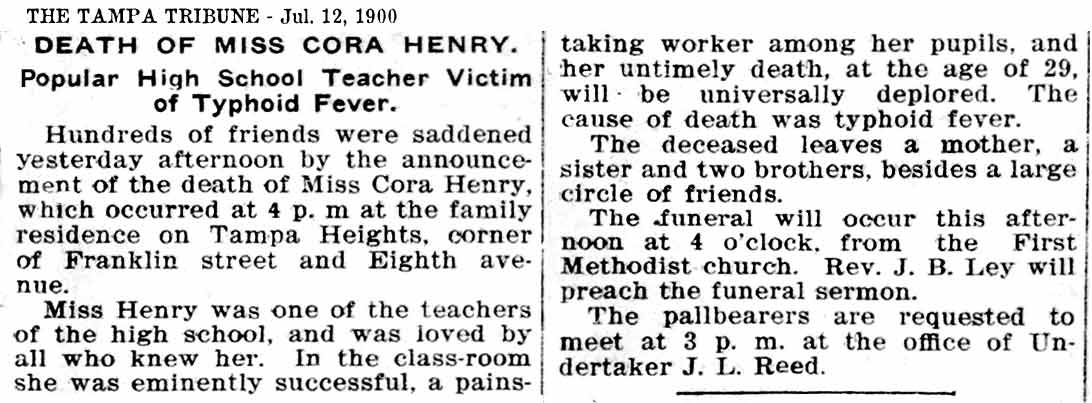
1900 Census of Cora Henry, Tampa, June 6.

Cora Henry was living with her brothers and sister at
108 Oak Ave., all were natives of Louisiana.
Walter was an electric lineman, Guy was a painter.
THE SCHOOL BOARD RESOLVES TO BUILD
A NEW HIGH SCHOOL
In mid-July, the school board decided to build new
schools at Harney and
Chitto
[sic] Creek. They also decided to
assist financially in building new schools at Valrico,
Evergreen and
Fishhawk. They decided against building one at Sidney. Supervisors
were appointed at 3 locations. They resolved to construct a
new high school building on the school lot in Tampa Heights and
authorized plans to begin. They also resolved to add a
business course to the curriculum. Finally, they appointed
several grade school teachers.
Read this
article.
On the same day, the Tribune published
its approval of the Board's decisions, and urged the general public
to assist in whatever means they could.
Read this
article.
In the latter half of
July, 1900, Supt. Buchholz met with the architect Miller of the firm
of R. B. McGeckin, and discussed plans. The school would be
built on the same property it occupied at its 2nd & 3rd location,
having an acre at its disposal.
Read this
article.
On July 26, the notice
to contractors for construction bids was placed in the Tribune. The new
building was to be completed by Oct. 6, 1900.
Read this
article.
In late July, Supt.
Buchholz had already bought equipment for the school--some type of
apparatus which the manufacturer claimed would give the same results
as other equipment costing thousands of dollars per year in
maintenance alone. Other updates were described for window
furnishings and electricity for the auditorium and teacher's room.
Lighting wasn't necessary for the classes as they were to be held
during daylight hours.
Read this
article.
|
Buchholz
was also displaying a sample student
desk at his office. It was made of finely polished oak with
cherry finish. On Aug. 1 it was announced that the bid
deadline for contractors would be extended. |
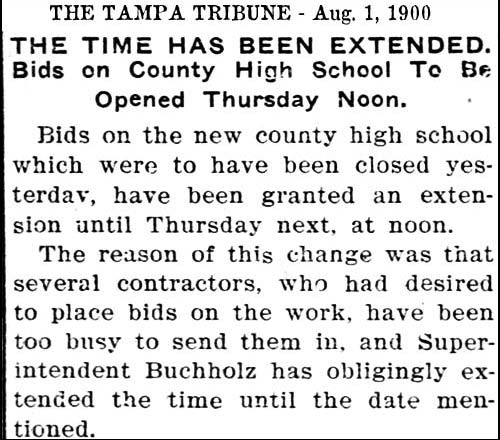 |
|
 |
|
GRACEFUL, YET
IMPOSING
On Aug. 2, 1900, the Tribune published the county's plans for the
new high school building which was to be completed by Oct. 6,
1900. Architect R. B. McGeckin designed it to be a 2-story frame building in the classical
style, with special attention given to heat, light and ventilation.
It would be graceful, yet imposing, and have a marble block with the
year of completion near the peak of the roof. A covered porch
was to run the complete length of the first floor. It would
have 10 rooms--8 classrooms and a teachers & library room, as well as
an apparatus room. The first floor would consist of 4
classrooms, the teachers room, and the library. The 2nd floor
would have 3 classrooms, an assembly room and the apparatus room.
It would be possible to design the assembly room so it could be
divided using sliding doors, for use as 2 or 3 classrooms.
Read this
article.
|
|
|
|
On Aug. 3, 1900, the
Tribune announced names of new teachers at various schools, an
update on the high school furniture being moved from the Wright
building, and bidding info for the new building.
Read this article.
|
|
|
|
|
Aug. 8 -
More new county teachers were named along with their schools,
contractors began work on new high school, to be
completed by Oct. 1.
Read
this article. |
Aug. 9 - The building contract
was awarded to Walker & Hester for $6,190. The design was by architect
firm G. C. McGeckin,
aided by Superintendent Buchholz regarding light,
ventilation, acoustics, etc. Construction had
already begun on the brick pillars.
Read this article. |
|
|
|
|
Aug. 16 - The McGeckin architectural design
firm designed homes
in NY for R. E. Slade of the Tampa Waterworks Co. Read this
article.
Read this article. |
Sep. 25 - All city schools opened on the
24th except the high school, which was still under
construction. Work continued with enrolling the
former students and examining the new ones. The names of the teachers and
principals for the four opened schools were announced.
Read this article. |
|
|
|
Oct. 7 - The high school was to be
completed by end of month and classes would then start.
Read this article |
Oct. 11 - The school board inspected the
building and liked what they saw. They were to
have a meeting in the afternoon but Dr. Symmes of Peru
(now Riverview) was sick so it was postponed.
Read this article |
Oct. 12 -
The BPI announced names of the new high school principal
and teachers.
Read this article |
|
|
|
|
|
|
 By careful management after the freeze of 1895, money was saved and
through the special efforts of Supt. Buchholz, the frame building on
the south end of the school property on the corner of Jefferson and
Estelle Streets, our present home, was erected in 1900 at a contract
price of $5,1003 dollars. This well-planned building has two stories
and contains an assembly hall, six large rooms, science
laboratories, several small rooms, a library, an auditorium and an
office. It was large enough to accommodate as many as 250 high
school students--ample room for the number of pupils enrolled at
that time.
3The bid was
$6,190 By careful management after the freeze of 1895, money was saved and
through the special efforts of Supt. Buchholz, the frame building on
the south end of the school property on the corner of Jefferson and
Estelle Streets, our present home, was erected in 1900 at a contract
price of $5,1003 dollars. This well-planned building has two stories
and contains an assembly hall, six large rooms, science
laboratories, several small rooms, a library, an auditorium and an
office. It was large enough to accommodate as many as 250 high
school students--ample room for the number of pupils enrolled at
that time.
3The bid was
$6,190
This building housed a real county high school, with a standard
four-year course, which immediately became recognized as a leading
high school of the state.
Mr. J. W. McClung was principal from 1900 to 1907.
During the next two years, 1907 and 1908, Dr. E. M. Hyde was
principal. Then in 1909, Mr. E. L. Robinson was appointed
principal.
|
Oct. 17 - The new high
school was completed on Oct. 16. Classes to start
the following Monday (Oct. 22) but new furniture had not
yet arrived. |
Oct. 21 - School will
start tomorrow, students will be assigned to their
classes. A large number of students were expected.
Principal J. W. McClung will have charge, his first
assistant was Miss Katharine Wicker and will teach
English and History. Mrs. D.B. McKay to teach
Spanish and Science. (Continued at lower left.) |
|
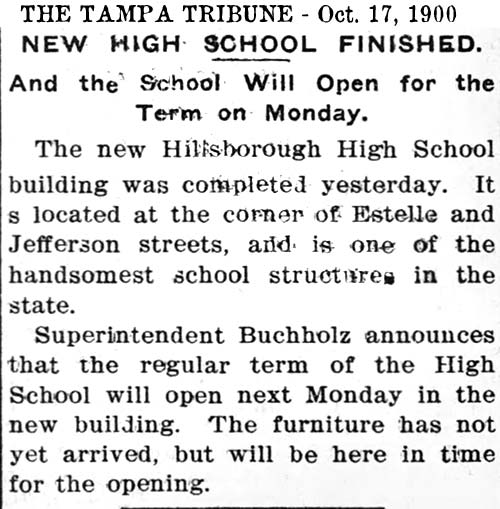
At right,
continued: Mrs. F. N. Clayton in charge of D class.(?) A
teacher will be added later for the commercial
department.
An error
by the furniture supplier caused only the wood portions
of the desks to arrive. Since the iron portions
would be received later, the school would be using
chairs for the students. It was planned for primary & grammar school
students to attend their classes in designated rooms at
the new high school building due to their insufficient
accommodations at their respective schools, but that
plan was delayed as well due to the lack of desks. |
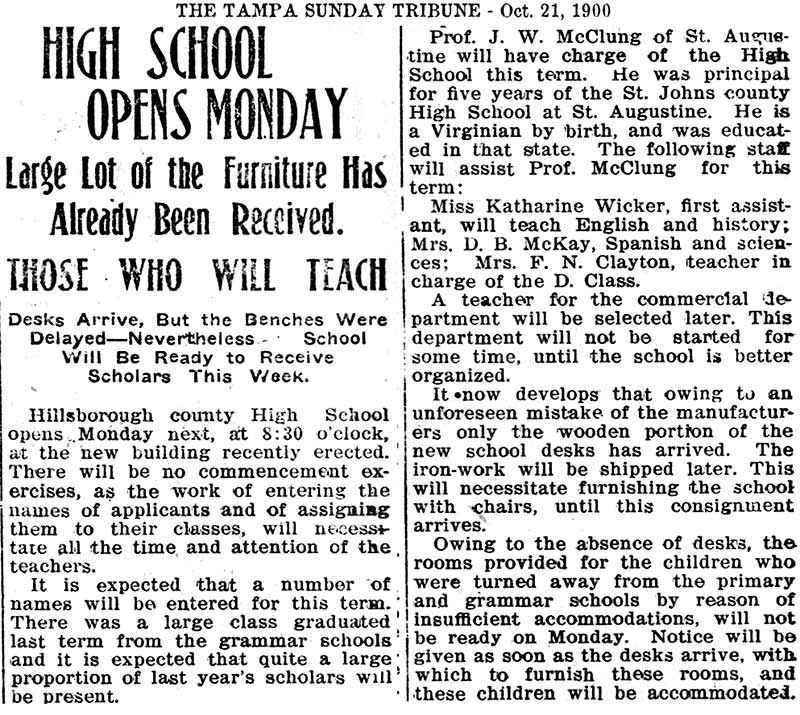 |
The school
opened October 22, 1900 to 125 students. Chairs were used to seat
the pupils since there were no desks. Supt. Buchholz made some
opening remarks and introduced their principal, Prof. McClung.
Students were quickly assigned to their classes, and cards were
given to them on which they wrote their full name, residence,
whether or not vaccinated, what grade they were promoted to, and
what studies they were deficient in. They were informed of
what textbooks would be used, and given their lessons for the next
day.
"System" was the watch-word; with
everything arranged to be the most efficient. The rule of allowing
only students who were qualified to enroll in the grade level was to
be strictly enforced, as well as the care of the new building and its
fixtures.
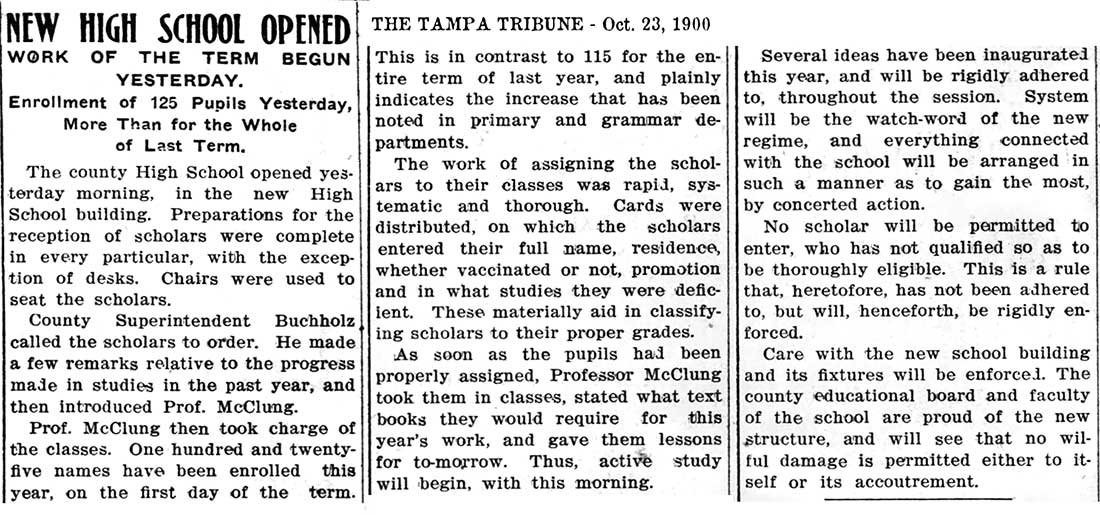
The postcard image
below shows the school's former location No. 3 on the right some
time from 1900 to 1910 when this postcard was designed. That
building had been enlarged by then, having been vacated by the high
school in 1896.
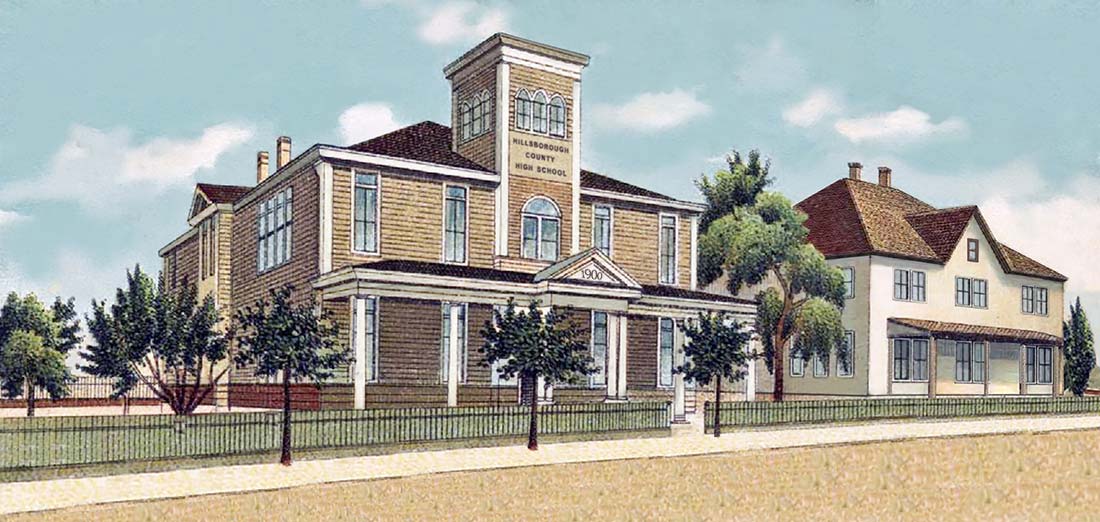
Post card image courtesy of
Hometown Currency Virtual Museum - Florida Alligator
Border Postcards, digitally altered and enhanced by
TampaPix.
|
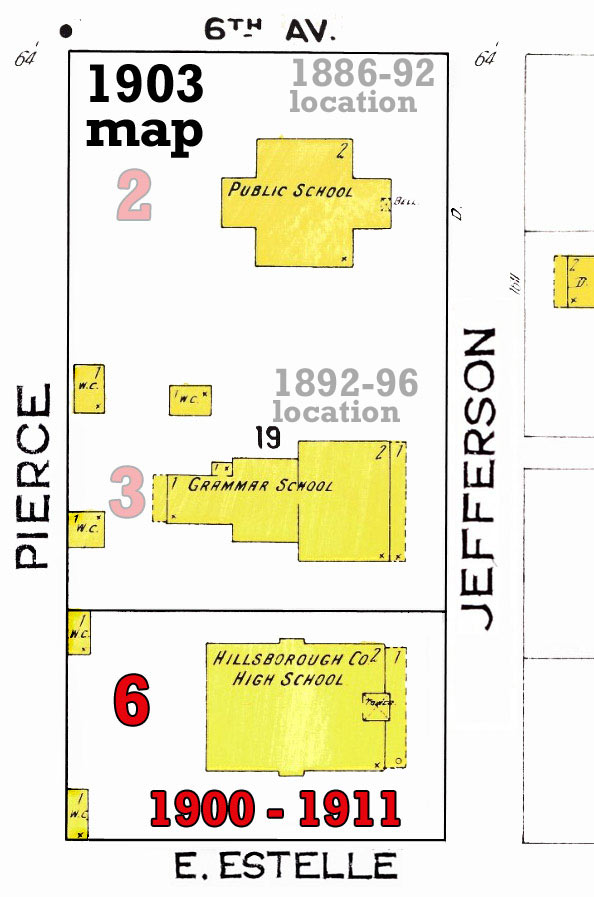
Although it appears that the enlarging was done at the rear of the
location #3 building, looking at the Sanborn maps, the front facade may have
been remodeled and improved as seen in the postcard, but probably not by much.
(The lack of a door could be due to the artist who created the post
card image from the original photo probably could not see much
detail in the photo if the porch area was shaded and underexposed.)
The 1903 map at left shows the 2nd, 3rd and 6th locations of
Hillsborough County High School.
#2 - The 1886 to 1892 combined location of Tampa School #1 and
Hillsborough County High School.
#3 - The 1892 to 1896 location of Hillsborough County High
School.
#6 - The 1900 to 1911 location of Hillsborough County High School
seen in the photo above and the photos below.
|
|
Oct. 25, 1900 -
Despite a few "usual embarrassments" associated with
moving into a new building, the operation of the new
school was progressing smoothly. The lack of desks
didn't cause any great inconvenience due to use of
temporary furniture. Principal McClung is described as a
"first-class disciplinarian and instructor." |
Nov. 4, 1900 - The rest
of the parts for the desks arrived and plans were in the
making to assemble them and have them ready for Monday
(next day.) It was expected that then there would
be enough room to accommodate the Tampa Heights Grammar
and Primary school children who were unable to start
school due to overcrowding in those adjacent buildings. |
|
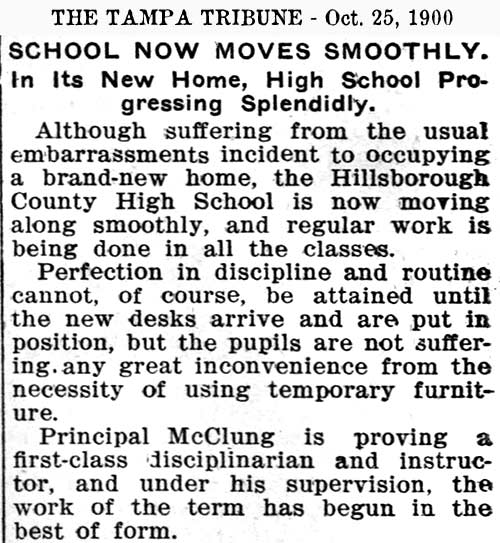 |
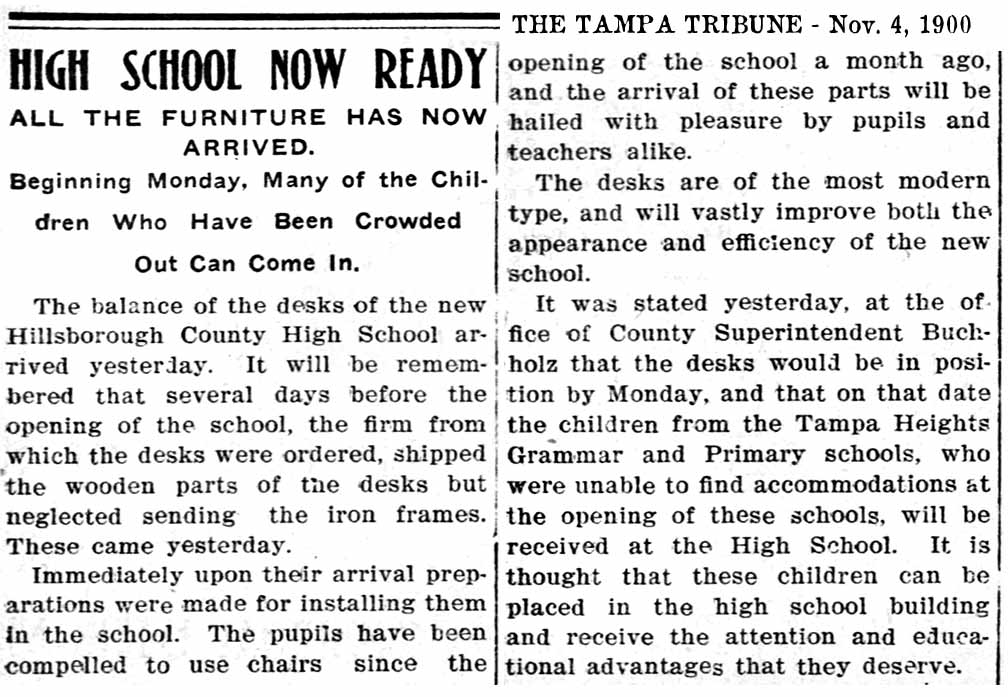 |
|
|
|
|
In late November a
business course taught by Prof. L. M. Hatton was offered
at the high school. Hatton was the principal at
Tampa Business College. Complete courses in
bookkeeping, stenography and typing would be offered, in
addition to other commercial courses. In late Feb.
of that year, Hatton had moved the college to the Davis
block, which was the west side of the 700 block of
Franklin St. Today, this is where the TECO Plaza
building is located. |
THE LAST MEETING OF THE PRESENT SCHOOL
BOARD WITH SUPT. BUCHHOLZ In early January 1901 the final details
of construction were completed, and already it was noted
that although the students would be comfortably and
adequately housed, the new building didn't fulfill
the deficiency of space needed due to the large increase
in student population over the past two years. |
|
Supt. Buchholz provided the final costs: |
The board's next meeting (tomorrow) would
be its last under the present administration with
Buchholz as superintendent. On the 8th, a new
board was to take office. "It leaves a record of
faithful service and devotion to duty..." |
|
Contract |
$6,190.00 |
|
Extras |
$
69.68 |
|
Improvements |
$2,186.88 |
|
Total completed & Equipped |
$8,446.56 |
|
|
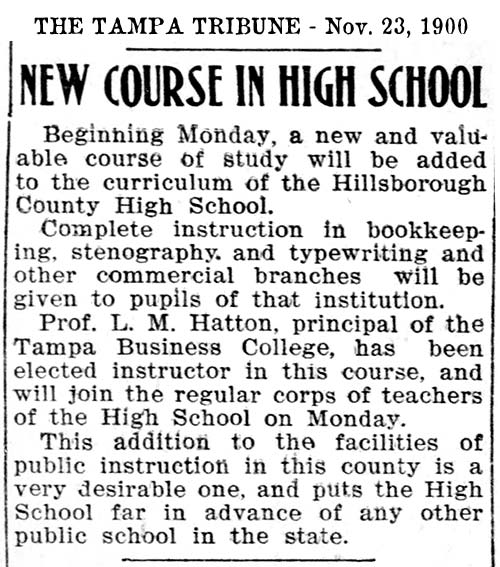
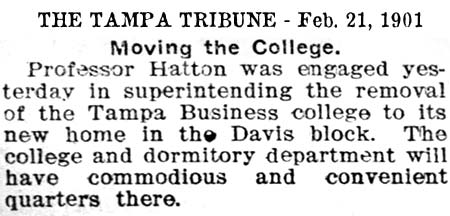 |
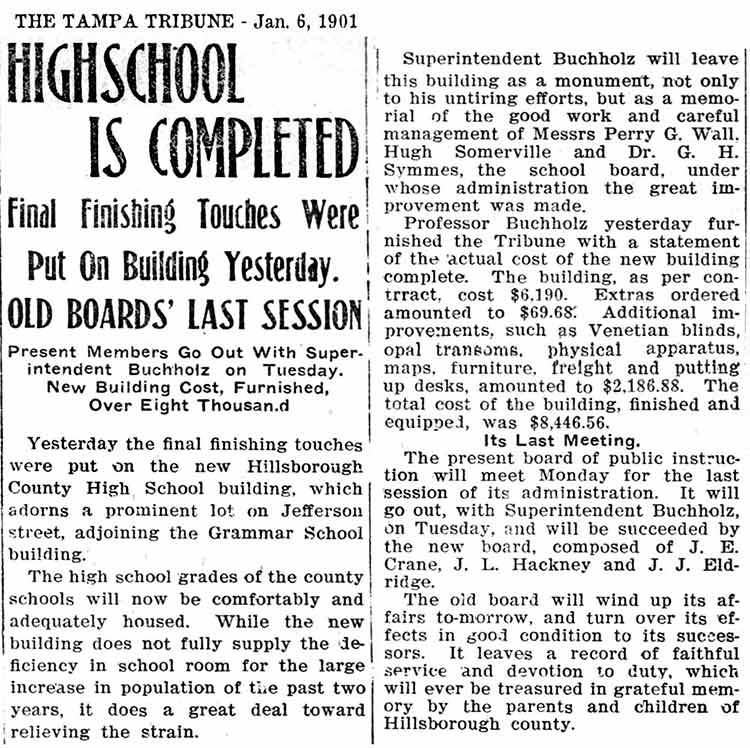 |
|
|
|
|
Professor Hatton's Tampa Business College
(TBC) had its roots in a school that was started in
Tampa under that same name in 1891* by B. B. Euston.
Originally on
the corner of Franklin St. and Harrison, by June 1892, the college had
moved to the corner of Whiting and Marion streets.
A few years later it would merge with a different
business school, Tampa Business University, which was
established in Tampa in in 1895 by R. N. Hadley.
*Later ads by Euston claim TBC started in 1890.
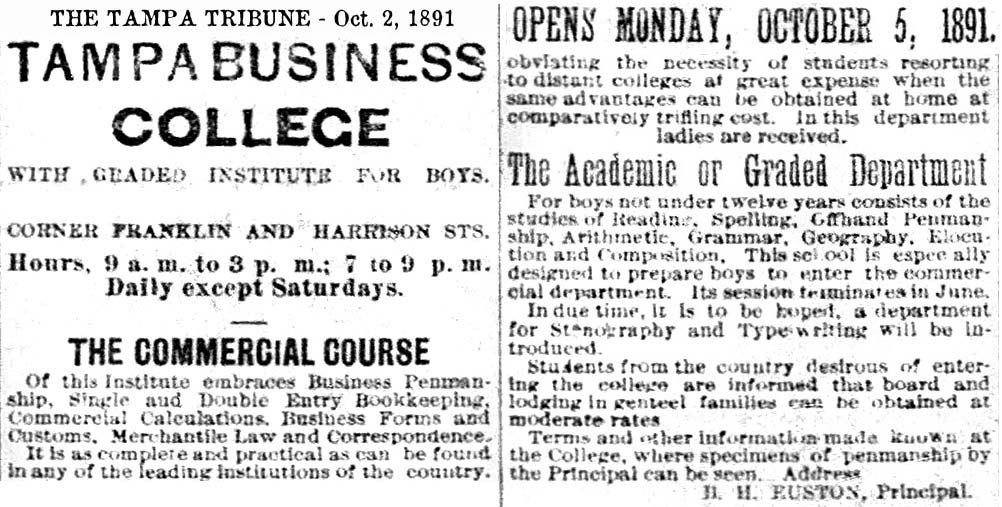
Read more about Tampa
Business College, how it became Tampa Business
University, and the circumstances of a the start of a
new Tampa Business College by L. M. Hatton, here at
TampaPix on a separate page.
THE HISTORY OF TAMPA
BUSINESS COLLEGE
and
THE HATTON BROTHERS OF
SCOTLAND COUNTY, JEFFERSON, MISSOURI
|
|

In January 1901, Mr. Buchholz
accepted a position in the Florida State College at Tallahassee. Mr.
B.C. Graham, who up to that time had been principal, succeeded Mr.
Buchholz as County Superintendent, which office he held until 1904,
when he was succeeded by Mr. W.B. Dickenson, who also occupied that
position for a term.
In 1908, Mr. Buchholz was again elected as
County Superintendent, which place he holds at the present time.
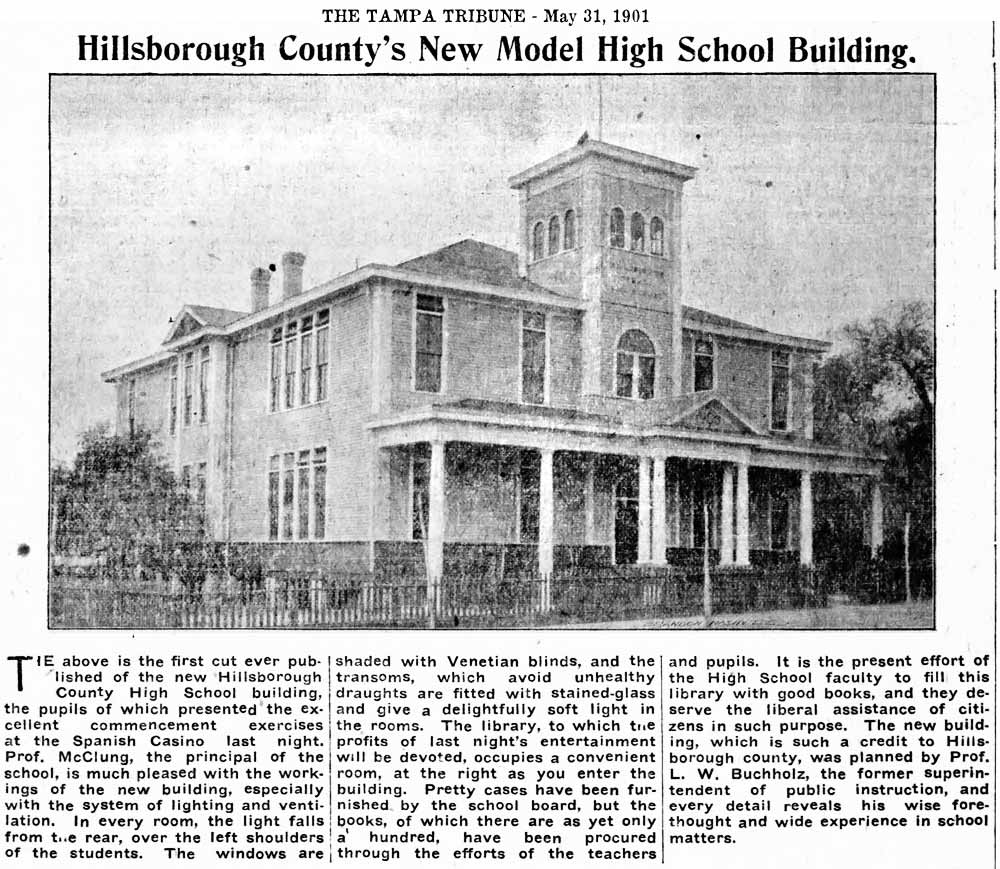
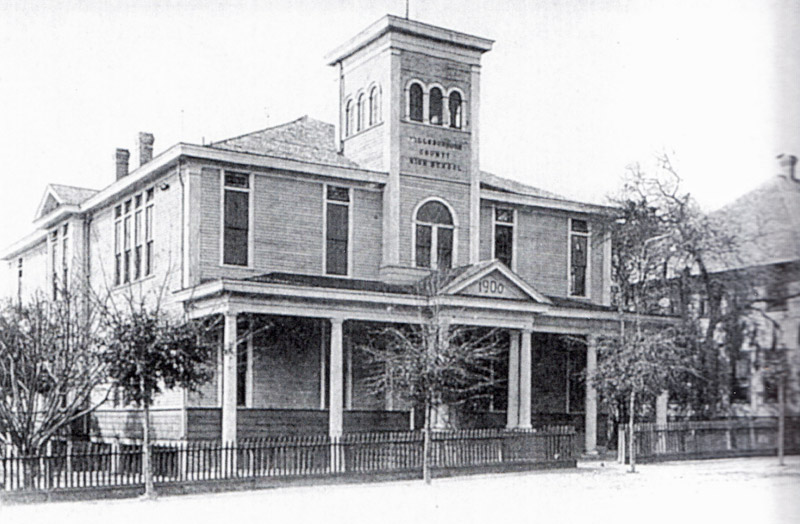
|
|
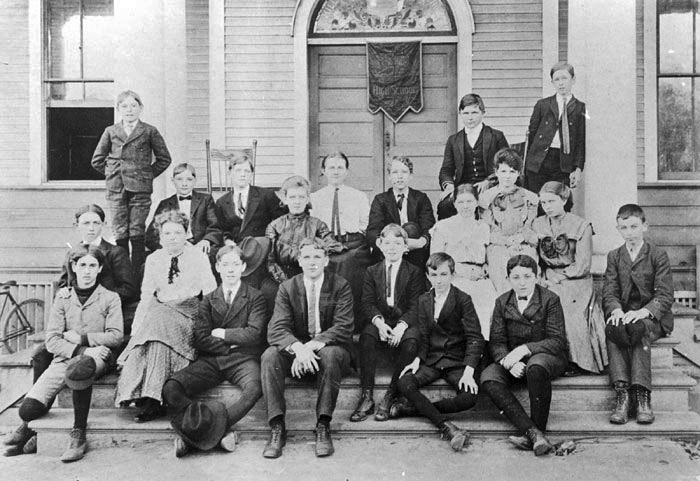
Students on
the steps of Hillsborough County High School, 1905.
This was not the entire student body, as there would have been over
140 students attending at the time.
Photo from Exploring Florida
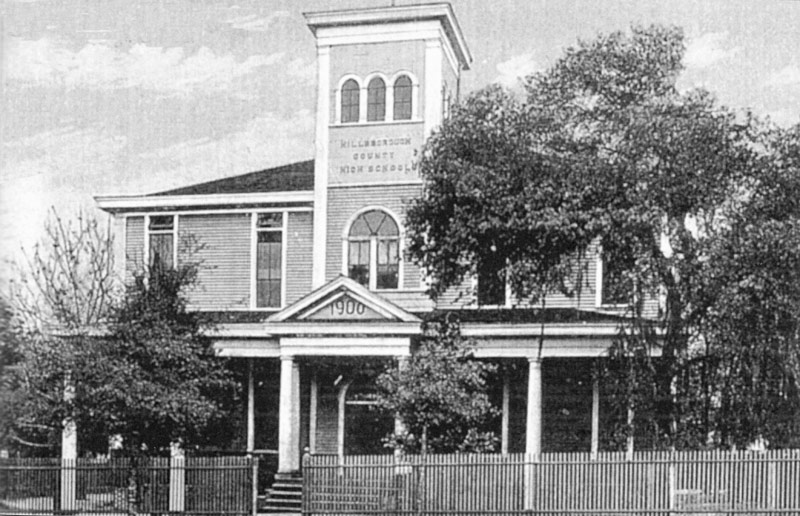
Above, the Burgert Bros. photo that
was used
for a postcard presented in Rob Kaiser's book, "Tampa
- The Early Years." Although it is
very similar to the one below, there are slight differences.
The postcard shows damage to
the picket fence and a general state of disrepair. The photo shows no damage.
Other differences are the door, foliage and direct sunlight
casting sharp shadows on the postcard.
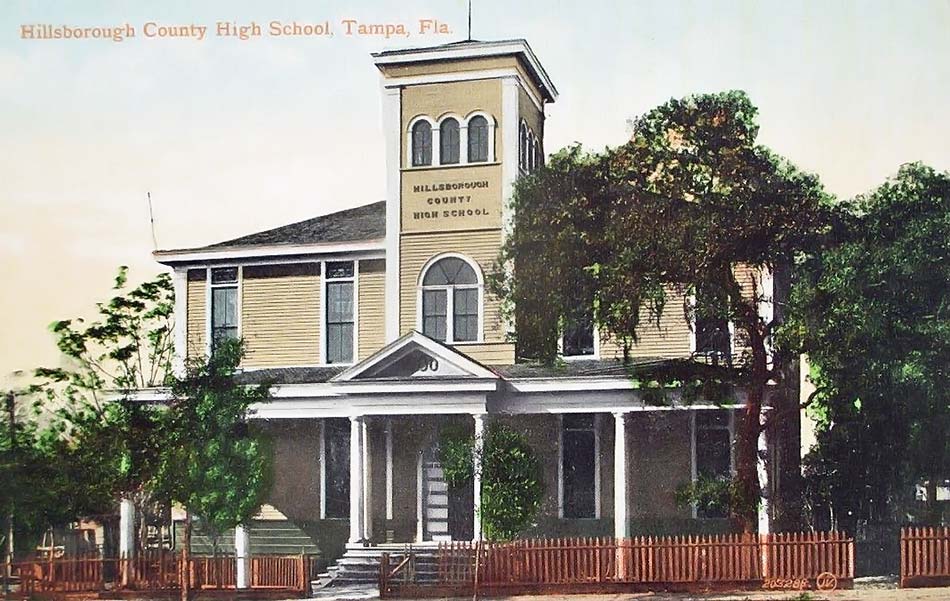
Postcard image courtesy of eBay seller Gold Coast
where a year of 1910 has been attributed.
It could have been made after the school was vacated in 1911. Notice
the front door.
It's from this
building that on Feb. 15, 1911, Doris Hill completed her history
of Hillsborough County High School
for inclusion in the new
building's cornerstone time capsule.
On the right can be seen the 3rd location of the high school.
[Insert articles / events from
1901 - 1904 re Graham Supt. administration.]
|
THE RACE FOR HILLSBOROUGH COUNTY SCHOOL
SUPERINTENDENT B.
C. Graham's term as county schools superintendent would
end Jan. 2, 1905. Campaigning for the "first
primary" to be held on May 10, 1904 started in
early February, 1904.
For reasons not yet
determined by TampaPIx, elections in Tampa in these
times were referred to as a "Primary,"
whether it was one to determine which candidates would
run in the final election, or the final election itself.
It may have just been terminology used only by
newspapers. So as illogical as it sounds, this "primary" was the "primary primary"
and there would be a "second primary" to determint the
winner on June
8th.
|
See
the rest of these articles in their entirety, B. C.
Graham's campaign (or lack thereof) and response,
election results, and various articles about Graham
until the time of his death and some tributes to him afterwards.
Here at the
conclusion of B. C. Graham.
|
|
| |
|
THE
NEED FOR
A NEW BUILDING
Feb. 14, 1907
- The Tribune published an article which appeared in the
most recent issue of the high school's newspaper, The
Donnybrook Fair, detailing the need for a new building.
The Tribune reasoned that "the best critic of any condition
is one who is brought into daily contact with it and has to
suffer in consequence." It also stated that "environment has
much to do with our enjoyment of any of the blessings or
pleasures of life...Young people are peculiarly susceptible
to the teaching of their surroundings."
The writer for
the school newspaper says, "Six years ago we planted
ourselves on the edge of the 'scrub;' now we
are in the midst of it." Their view was the county
jail, "fluttering lines of clothes, or in a word, the
tenderloin of Tampa." Referring to the school as "a
cheap frame building situated in the dirtiest part of town."
They wanted a gymnasium, "for this is found in nearly all
modern schools and its usefulness is not questioned."
Their auditorium was too small to hold the entire student
body, so "no entertainments and no lectures can be given."
The Trib ends by asking, "Is it not a self-evident
proposition?"
|
|
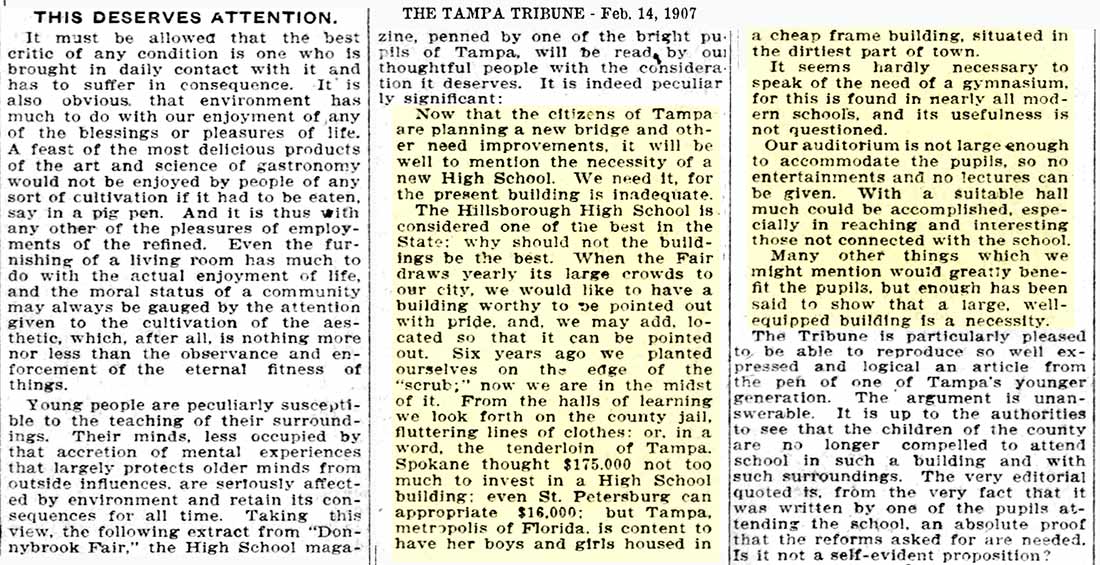 |
|
|
THE SCRUB
In the mid 1800s, the north side
of the Ft. Brooke government reservation ran
east and west along Whiting street. The streets,
as yet, were merely trails winding through the
scrub palmetto. Over the years, as the
town of Tampa grew northward from Whiting St.,
the undeveloped territory on the north side of
town continued to be called "the scrub."
In noted Tampa historian Tony
Pizzo's oral interview by USF, printed in Tampa
Bay History Magazine in their Spring/Summer 1980
issue, Pizzo touched on the topic of the Scrub:
“The Scrub” started as a small
Negro settlement which surrounded a lumber mill
near Oaklawn Cemetery. Tampa was a village then,
its northern fringe extended to Lafayette Street
(Kennedy Boulevard). The Negro settlement got
its name from the scrub palmettos which covered
the area. Some of the first blacks to inhabit
“the Scrub” came from the Bahamas. When many of
the lumber mills in the interior began to close
down in the 1890s, many of the black lumberjacks
drifted into the quarters. This is how Tampa's
first black community emerged. When Ybor City
was established in 1886, two miles to the east
of Tampa, the black community found itself in
the middle of a wilderness sandwiched between
the Cracker village of Tampa on the one side and
the Latin village on the other. In time Tampa
and Ybor City began to grow in all directions
and “the Scrub” remained in the center, a lost
and forgotten world. When a movement was
starting for the clearing of “the Scrub” I
remember Curtis Hixon, then mayor, telling me
while flying to Havana, “we must do
something to better the living conditions of
our black people.
“The Scrub” was a world of its
own. No one ventured into that quarter. Only
those who lived there frequented the place.
There were no paved streets. The houses were
placed at random – thrown together in an
incomprehensible maze. The frame houses dated to
the 1880s; they were weather beaten, shabby, and
literally uninhabitable. It was probably the
worst slum area in the state. I remember a news
story referring to “the Scrub” as a cesspool in
the heart of town. It was a frightful place
forgotten by time.
So when these people were
displaced, where were they to go? Ybor City was
the logical area. Many of the Latins were
beginning to build new homes in other areas.
Real estate agents grasped a golden opportunity
and began selling Ybor City houses to the blacks
who had nowhere to go. These agents gouged the
black man, selling houses for more than double
their worth. Many of the Ybor City houses were
very old and in dire need of repair.
This
1926 photo of the scrub section of Tampa is
from the Burgert Bros. collection at the
Tampa-Hillsborough Co. Public Library. It
shows the scrub section on the left, leading
into Ybor City on the right. The area
outlined in red is the location of HCHS
locations 2, 3 and 6. The black water tank
was used in Tampa's first waterworks at
Jefferson St. and 6th Avenue and was situated
caddy-corner from the school property.
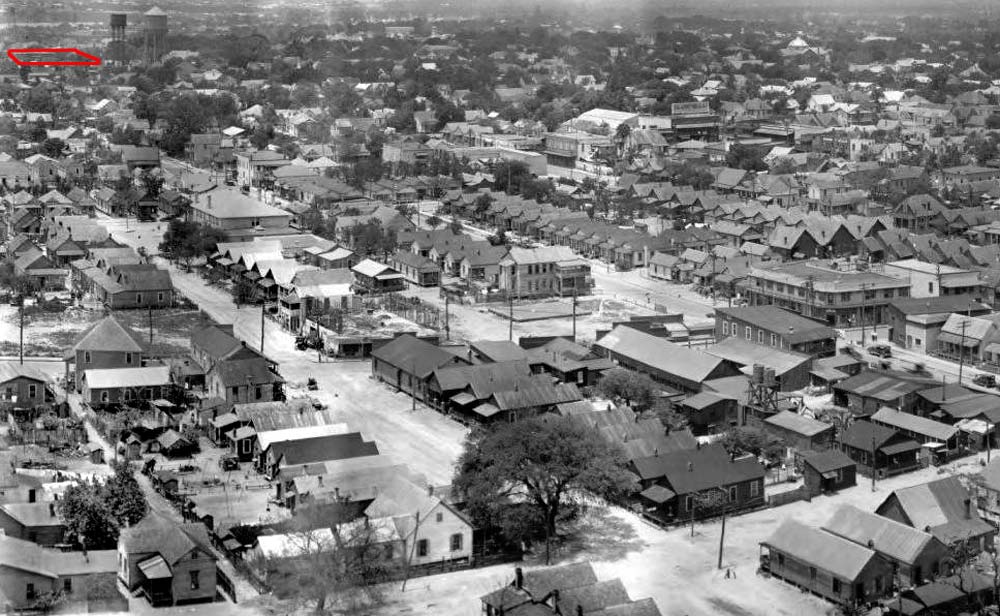 |
|
|
|
THE TARR - MCMURRY GEOGRAPHIES BOOK
BANNING DRAMA
|
|
In
late march of 1907, the Tampa Chamber of
Commerce and the Hillsborough County school
board became involved in an almost completely
one-sided controversy concerning a geography
textbook published by Tarr-McMurry which was
being used in the schools of Tampa.
Lighting the fire and stirring the pot was the
editor of the Tampa Times, Edwin Dart Lambright.
He contended that the book was contentious and
teemed with misrepresentation, and that it was
"colored greatly with scurrilous remarks
derogatory to the South."
At
a special meeting of the Tampa Chamber of
Commerce, only two disagreed with the
contentions. City Superintendent & High
School Principal J. W. McClung considered the
books "non-sectional and proper for use in
Tampa," since they were being used in other
Southern states and did not consider them
prejudicial to the interests of the Southland.
A young attorney named Mr. Turner, who recently
came to Tampa and was practicing in the law
office of Peter O. Knight, defended the passages
others thought to be objectionable, citing them
as "true and fair." Several who spoke at
the meeting believed the book to be prejudiced
against the South, but also believed that the
Chamber of Commerce had no authority to be
dealing with the issue, that it should be a
matter of the school board.
[Unfortunately, online issues of the Evening
Times before 1912 are unavailable, and may not
even exist anywhere. It appears that
Lambright detailed examples of the debated content in
his columns; the Tribune didn't.]
The ensuing controversy over the book enflamed
the rage of pro-Confederacy Tampa. The most
vehement protests came from Confederate Civil
War veterans, one of whom was the police
station keeper who wanted all the Tarr-McMurry books in
the county collected and burned, and then
advocated the burning in effigy the responsible
members of the board who allowed or suggested
the books be used.
To conserve some time in loading this feature
due to high image content, these entire articles
concerning the meetings and actions can be seen
by clicking the article titles.
When
it opens, click it again to see it full size.
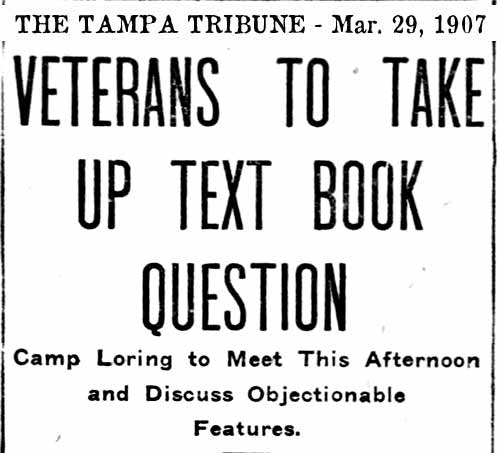
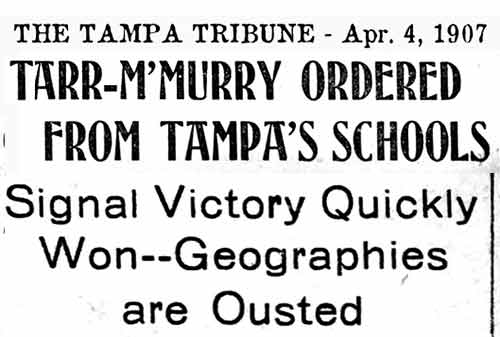 |
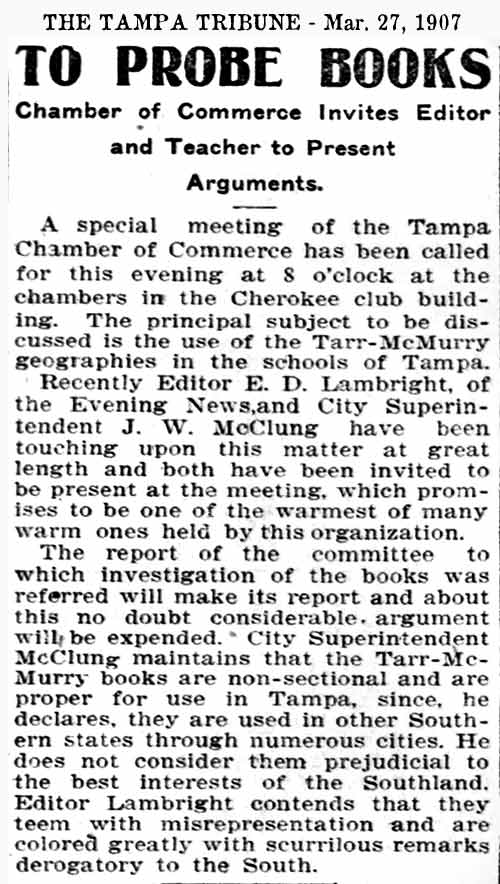


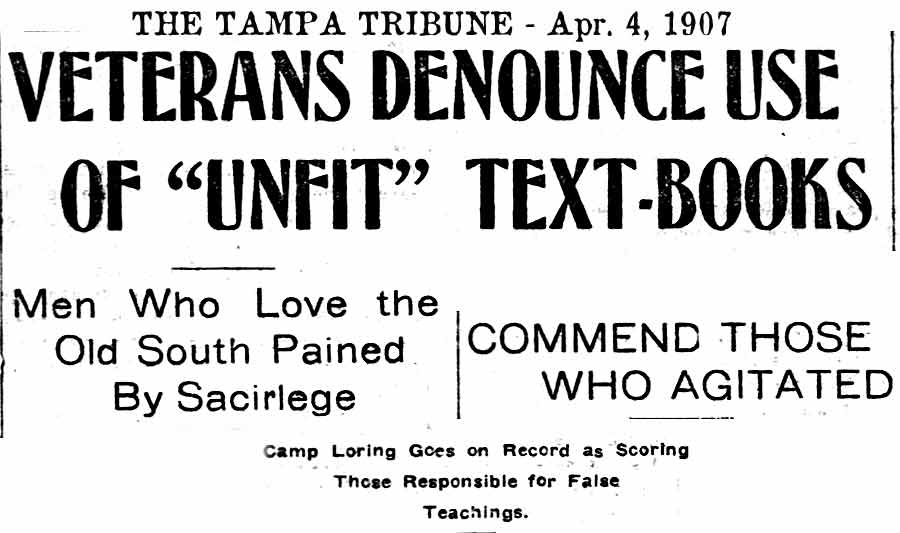
SEE FOR YOURSELF -
LINKS TO EDITIONS AT INTERNET ARCHIVE:
TARR-MCMURRY
GEOGRAPHIES PUBLISHED 1907 AND EARLIER
1900 EDITION
SPECIFIC TO NORTH AMERICA
CHAP. 10 -
SOUTHERN STATES
Agriculture
- Cotton
|
|
|
| |
|
DONNYBROOK
FAIR MAKES ANOTHER APPEAL FOR A NEW BUILDING
In
early May, 1907, the staff of the Donnybrook
Fairy once again voiced the students' desire for
a new school building, and again, the Tribune
was sympathetic to their cause, even to the
point of encouraging them to "Continue the
agitation." The Trib expressed the opinion
that the same authorities that rightfully banned
the Tarr-McMurry geographies should show just as
much zeal in securing a "proper building , with
surroundings which they need not be ashamed." |
|
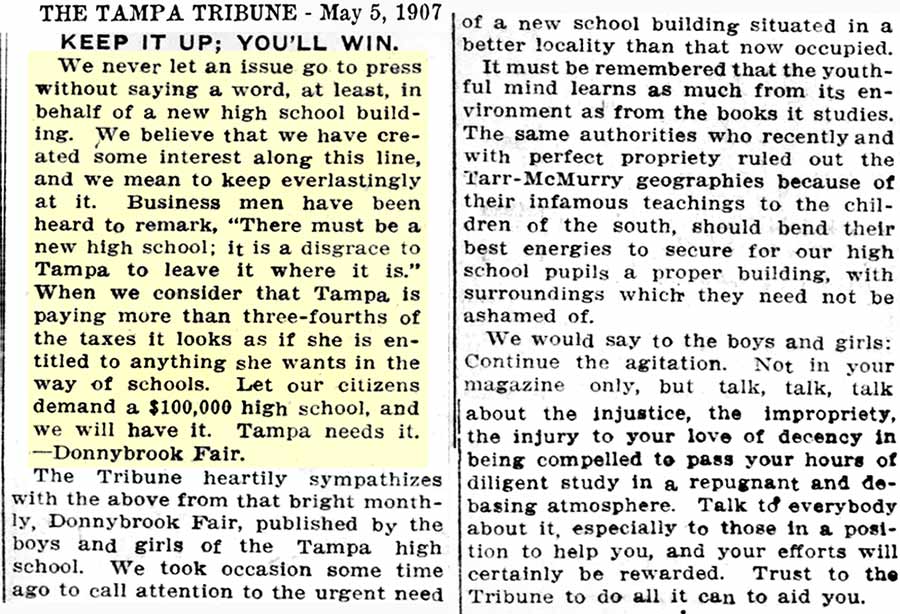 |
|
THE REMAINDER OF DORIS HILL'S TIME CAPSULE
HISTORY - The present faculty and course of study
The High School Faculty at the
present time is composed of Mr. E. L. Robinson, principal, Mr. Fritz
Buchholz, instructor in German and Mathematics, Mr. F. S. Wetzel,
Science teacher, Mrs. Sarah McCreery, Latin instructor, Mrs. L. B.
Bradford, English teacher, Miss M. Sparkman, teacher of Spanish and
History, Miss Butler, instructor in History and Biology, Miss J. E.
Rutland, teacher of English and Algebra and Miss Hulda Kreher,
director of the Orchestra.
The course of study from time
to time has changed. The course which was adopted in September 1910
and which is in use at the present time is as follows:
Freshman Class: Beginning
Latin or Biology, Algebra to Quadratics, English Grammar and
Composition, Ancient History.
Sophomore Class: Caesar or
Biology, Plane Geometry, Rhetoric and American Literature, Modern
History.
Junior Class: Cicero, Algebra
from Quadratics, English Literature and Composition, Physics,
Spanish, German.
Senior Class: Virgil, Solid
Geometry and Plane Trigonometry, English Literature, Chemistry,
Spanish, German, United States History and Civics.
A credit is given when a study
is pursued for one school year with five recitations each week. It
takes four years to complete the High School course. Sixteen credit
marks, divided as follows, are required for graduation: English,
four credits, History, three credits, Math, two credits, Physics,
one credit, Foreign Language, two credits, Elective, four credits.
The High School Orchestra was
organized about 1904. The Orchestra contains eighteen pieces,
including one piano, eleven violins, two cornets, one triangle,
three mandolins, and is effectively directed by Miss Hulda Kreher.
EVOLUTION OF THE SCHOOL NEWSPAPER
The High School paper, which is published monthly throughout the
term by the students, is another interesting feature of our school.
In 1899, when it was first published, it had but four pages and was
printed like a newspaper. Its name was then “Donnybrook Fair." For
two years, 1907 and 1908, it was called “The Star of the Gulf”, and
again in 1909, the title was changed, this time to “The Red and
Black,” for these are our school colors. Our paper now contains
sixteen pages of reading matter and its success is shown by its great popularity with the
pupils.
We are delighted with the
prospect of moving next October into a new building so large and
splendidly equipped, and we intend to take advantage of all that our
new school offers us.
It is largely through his
[Supt. Buchholz]
efforts that our new building is being erected.
Read the
cornerstone history in its entirety and see scans of the original
document in Doris' handwriting
|
|
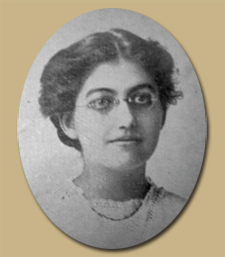 |
DORIS G. HILL
Doris Geraldine Hill was born
on July 15, 1894 in Indiana to Indiana natives DeWitt C. Hill and
Laura in Center township, Marion Co., Indiana, where DeWitt worked
a bookkeeper. Between 1900 and 1910 they moved to 2716 Morgan St.
in Tampa and DeWitt worked as a collector at a piano store. After
graduation, Doris worked as a secretary at Hillsborough County
High School for about a year. She then worked as a stenographer from 1914 to 1918
at the Macfarlane Investment Company. From
1919 to 1931 she was a stenographer at the Macfarlane & Macfarlane
law firm (Hugh and son Howard) which changed names over the years,
being at times Macfarlane & Pettingill and then, Macfarlane,
Pettingill, Macfarlane and Fowler. |
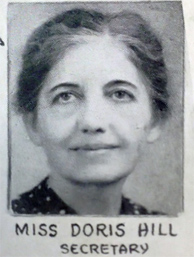 |
|
The photo of
Doris on the left appeared in the "Coloco" (HCHS's 1913 annual)
when she worked at the school as a secretary. The 1912
annual had no name; the 1913 annual was named for the yearbook
board members Collins, Lowry and Conoley.
From 1914 to present it's called the Hilsborean. The photo
of Doris on the right is from the 1948 Hilsborean.
In 1926, Doris became the chief steno clerk at the law firm and
in 1933 she had become a private secretary there.
Meanwhile, Doris' father, DeWitt C. Hill, became the manager of
Cable-Chase Piano Company by 1914 which would then become Cable
Piano Co. This was a position he held until at least 1940.
In 1940, Doris was working as an assistant secretary in the
public school system at Hillsborough High School. The Hill
family moved to 403 Magnolia in 1919 where DeWitt, his wife
Laura, and daughter Doris lived until his death between 1940 and
1945. Doris lived with her parents all their lives and she
never married. She died in Sept. of 1979 and is buried in
Myrtle Hill Cemetery.
 |
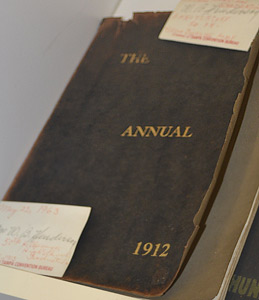
At right, a copy
of the 1912 Annual in the Hillsborough High School section of the
Jefferson High School Alumni Museum. |
PREVIOUS PAGE:
THE
BEGINNINGS OF A SCHOOL SYSTEM IN HILLSBOROUGH COUNTY
Continued on next
page
THE 7TH and 8TH HOME OF HILLSBOROUGH HIGH SCHOOL
|

